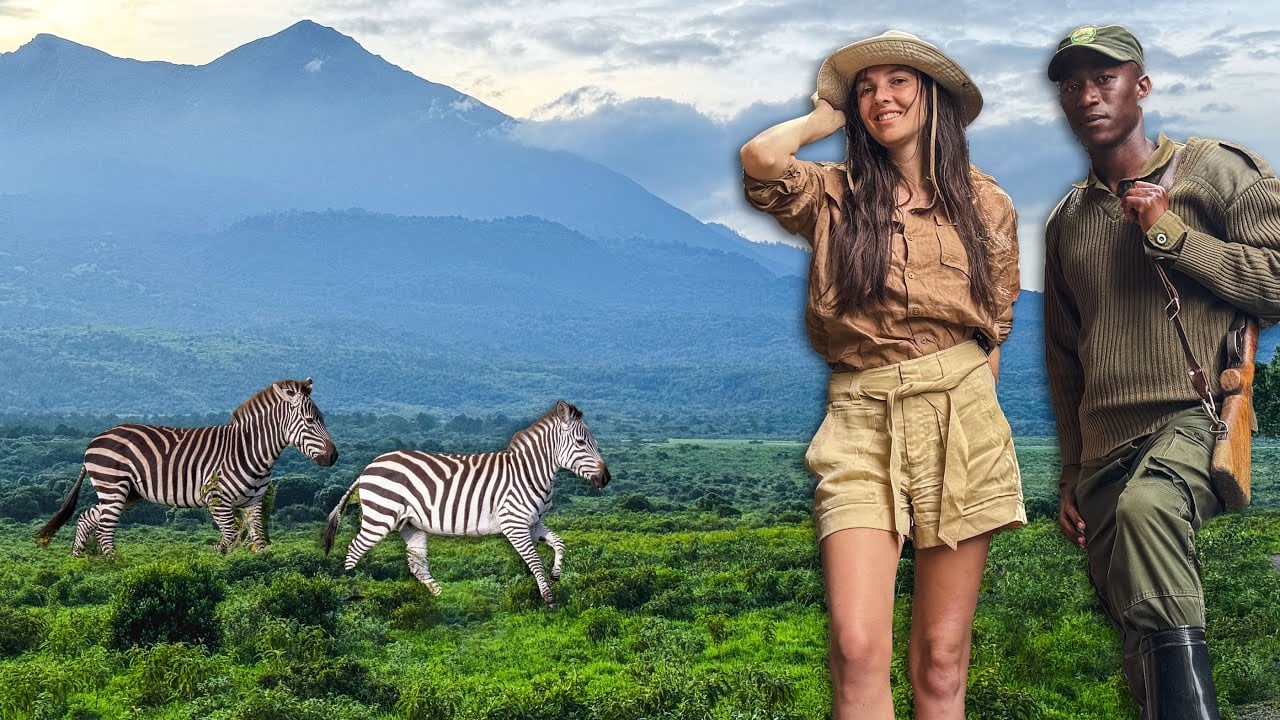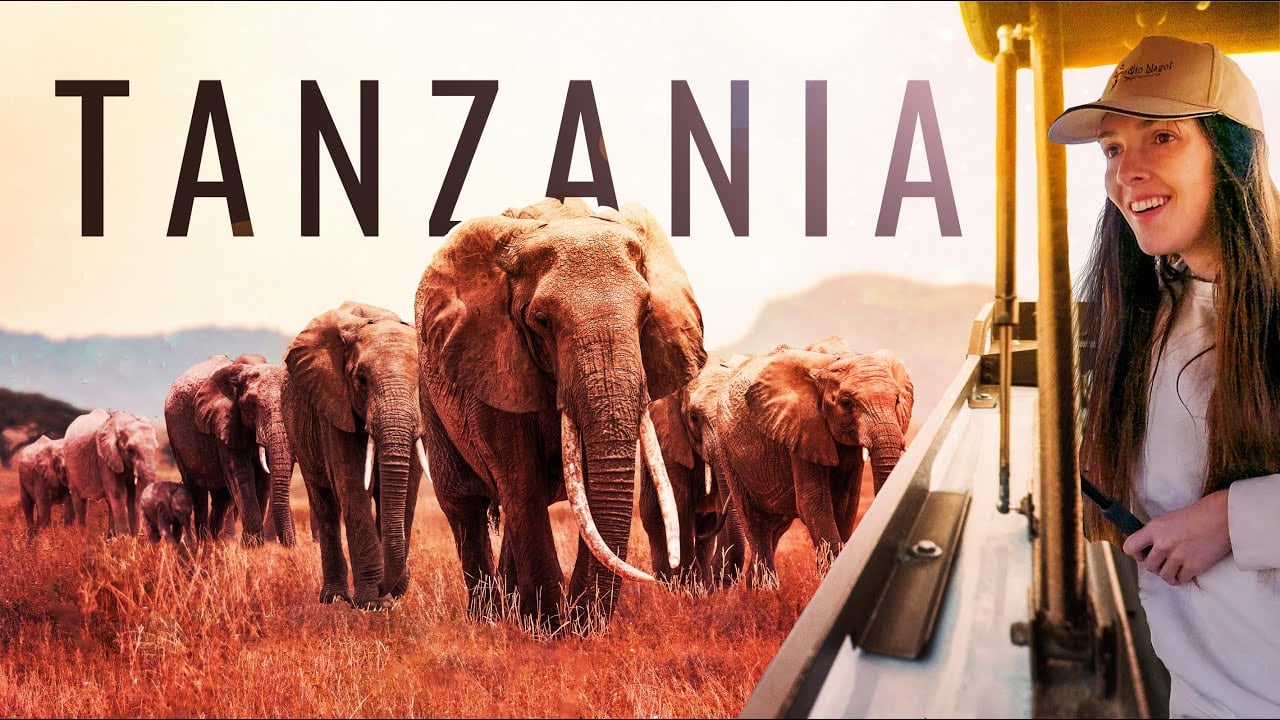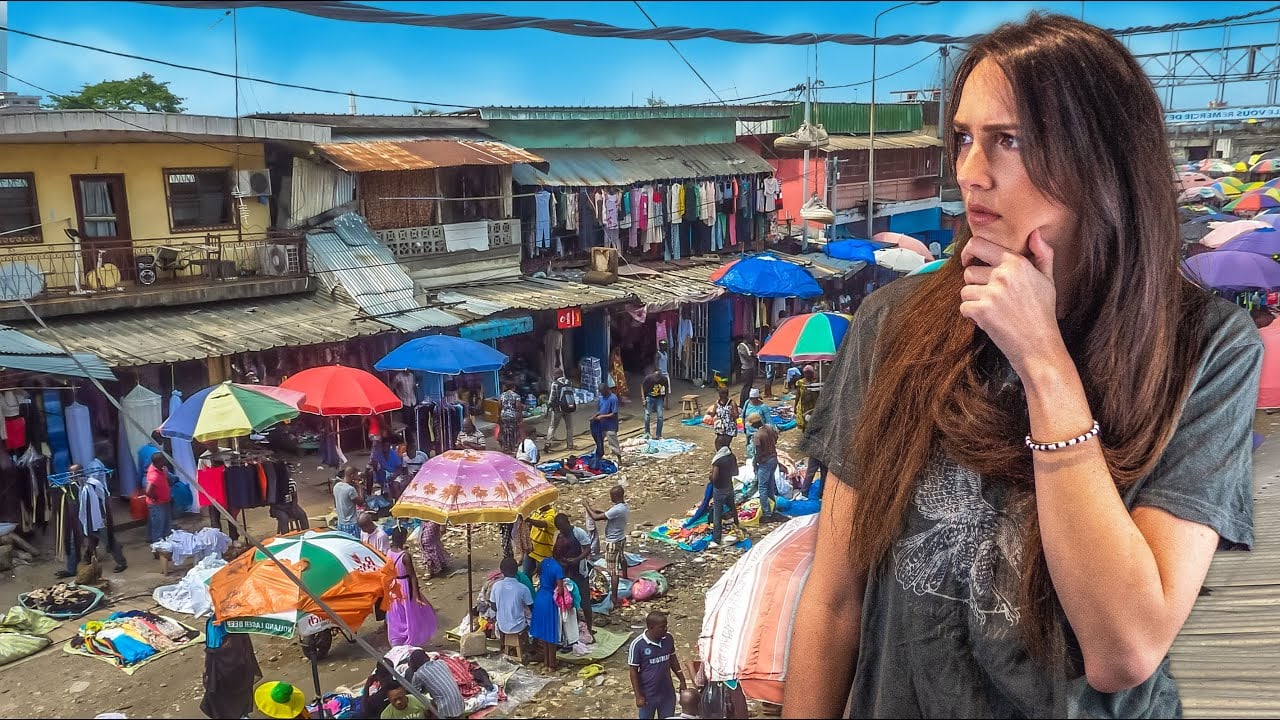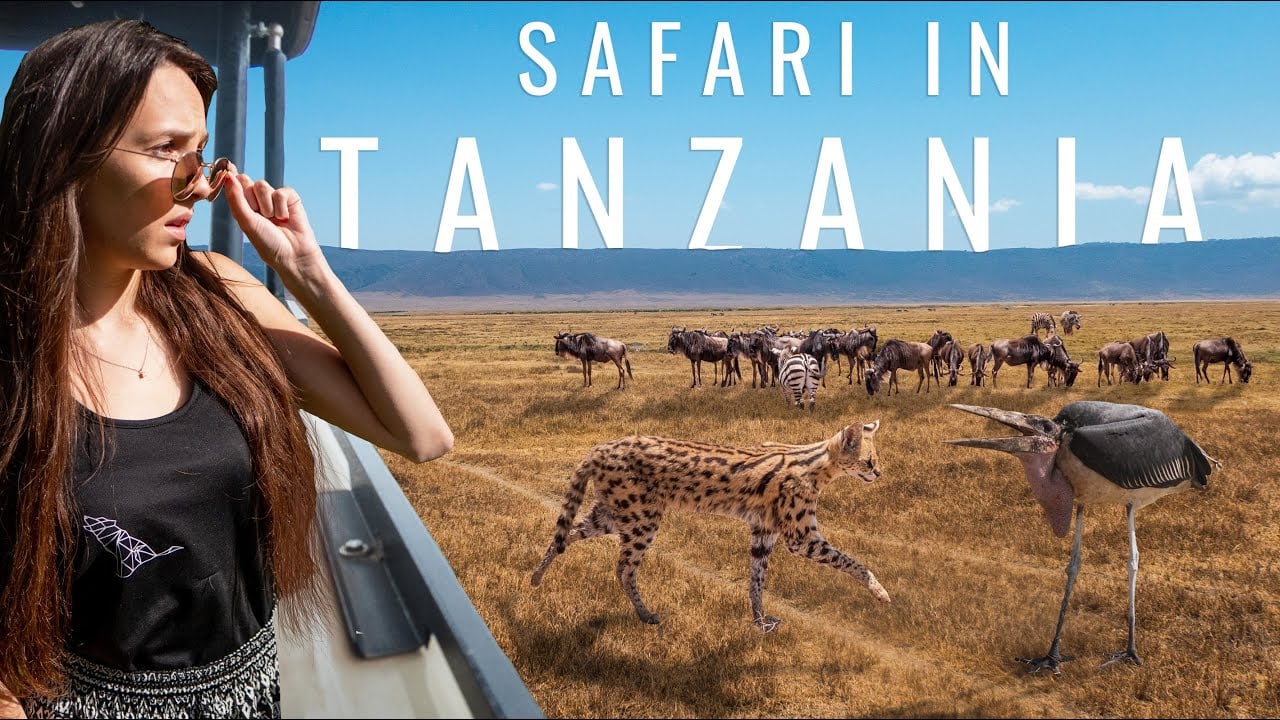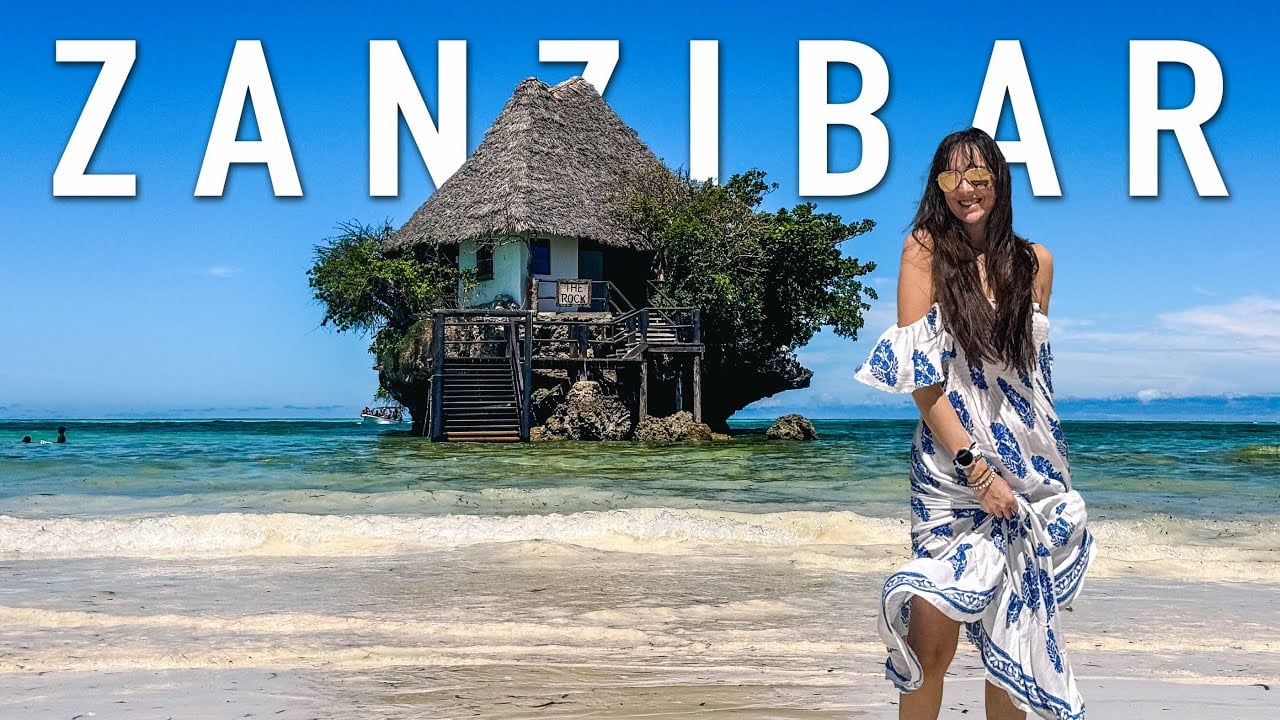Tanzania is quite frankly one of the best safari destinations on the planet. With 22 national parks taking up around 15% of the country, there’s certainly no shortage of things to see!
Whilst a 7-10 day or 2-week Tanzania safari may give you access to some of the country’s highlights, a 3-week safari allows you to incorporate both Tanzania’s lesser known and exclusive Southern Safari Circuit as well as the country’s popular Northern Safari Circuit, before a spot of well-deserved relaxation on the beautiful white sandy beaches of Zanzibar.
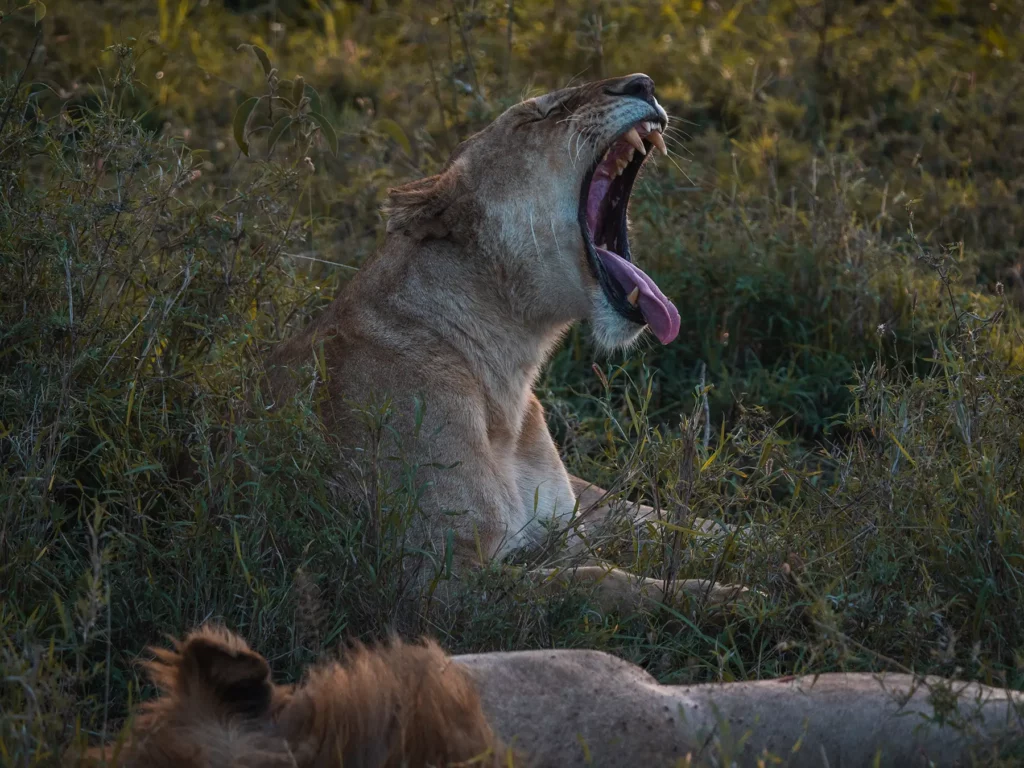
Having been on safari in Tanzania multiple times, the country has earned a place in my heart as one of my favourite safari destinations in Africa . The country is home to some of the best national parks and wildlife viewing experiences on earth, such as the world-class Serengeti National Park and the mystical Ngorongoro Crater.
However, there are some challenging elements that people often forget about when planning their trip, such as long drives on bumpy roads, and factoring in downtime. When you want to make the most of every moment, it’s so easy to overlook the super crucial logistical stuff.
That’s why I’ve carefully created this guide so you don’t miss any important details (or destinations)! This itinerary includes an ideal blend of highlights, hidden gems, and downtime in optimal locations, so you’ll cover the best of everything.

You’ve seen the wildlife documentaries, you’ve dreamed of gazing at lions and elephants from your jeep, and now you’re ready to turn the dream into reality. So let’s get started and plan your trip!
This 3-week Tanzania itinerary is here to help make sure your trip is even better than you could’ve imagined! We’re going to cover everything from how to choose the perfect tour operator to safari costs as well as tips and tricks to make the most of your safari.
Having spent countless hours travelling in Tanzania and soaking up the country’s best safari destinations, I wrote this post to make sure you can plan the best trip possible.
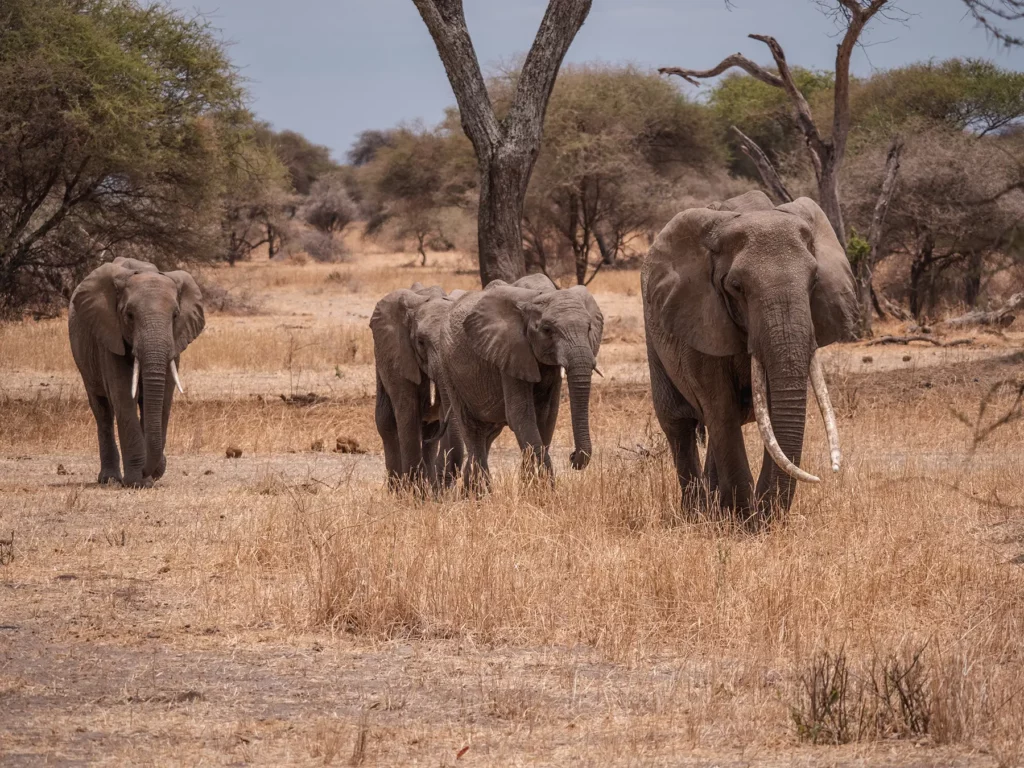
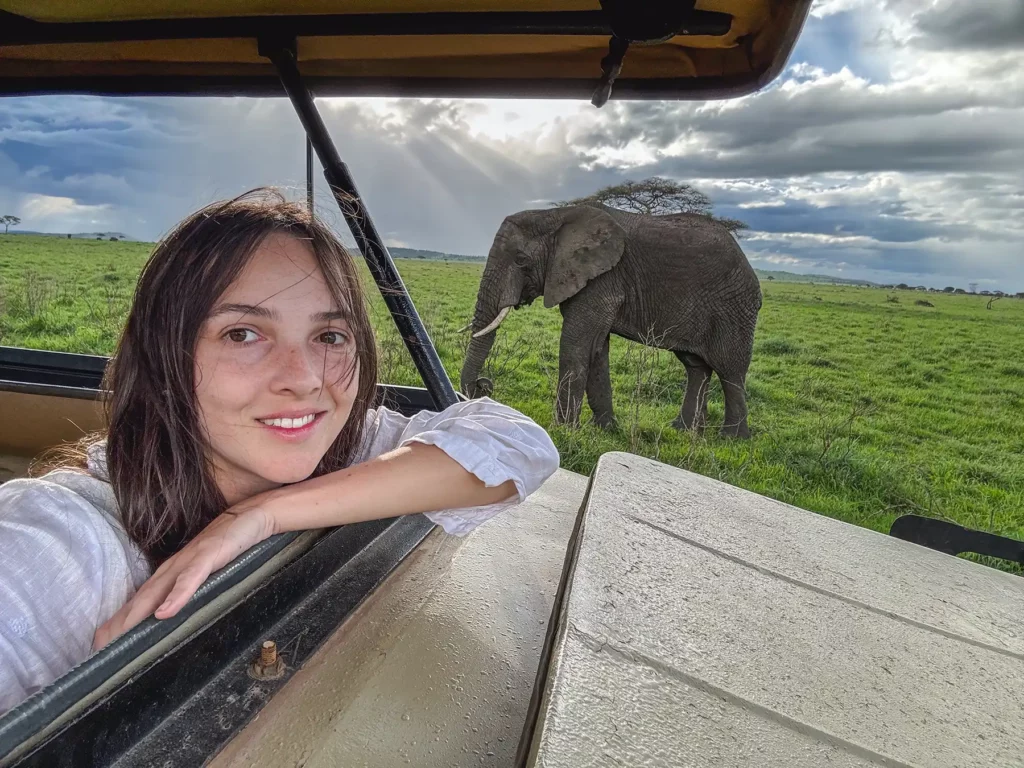
Embark on the Safari of Your Dreams
Save time and ensure an incredible safari experience by getting quotes from my recommended local safari companies
I’m here to make booking your perfect safari quick, easy and risk-free.
Join the rapidly growing tribe of over 1,000 travellers who’ve booked their dream safari using my insider tips and recommendations.

It takes under 60 seconds to fill out the form and in under 48 hours you will receive multiple, no-obligation proposals from my favourite local tour operators with glowing online reviews.
Get your free no-obligation safari quotes and my top safari tips and recommendations
3-Week Tanzania Itinerary Map
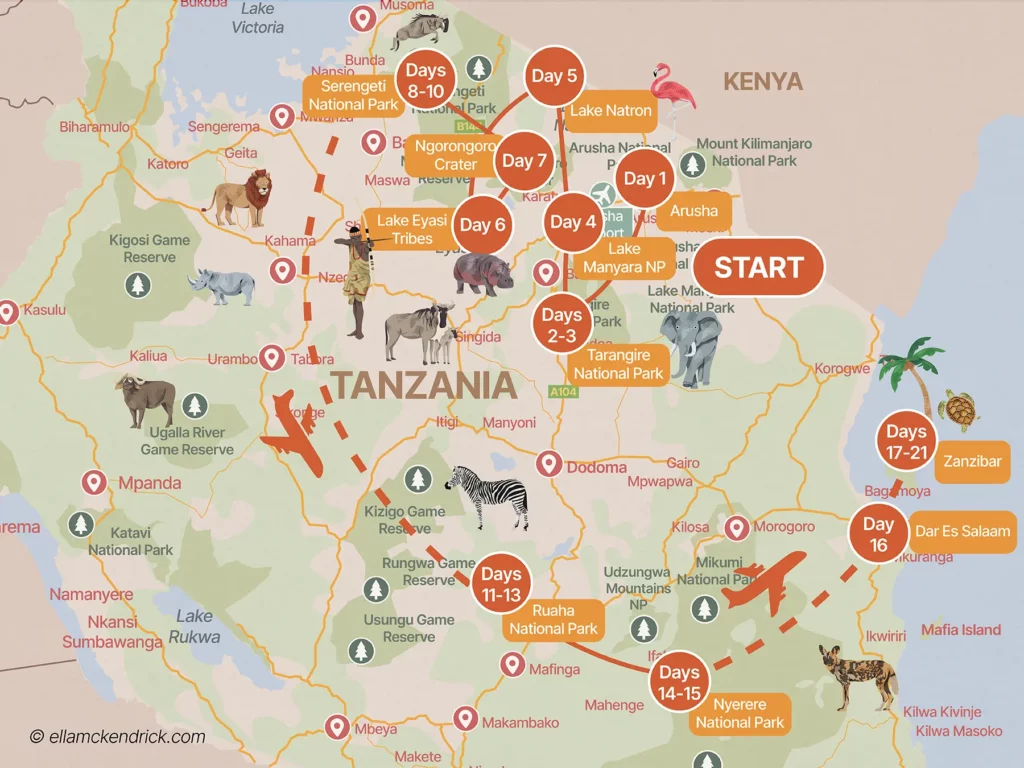
In this Guide
- Why Go on Safari in Tanzania?
- How to Book Your Tanzania Safari
- How Much Does a Tanzania Safari Cost?
- Best Time to Visit Tanzania
- How Long to Spend in Tanzania
- Tanzania Safari Logistics
- Tanzania Safari Itinerary Overview
- Day by Day Breakdown
- Day 1: Arusha
- Day 2: Tarangire National Park
- Day 3: Tarangire National Park
- Day 4: Lake Manyara National Park
- Day 5: Lake Natron
- Day 6: Hadzabe & Datoga Tribes
- Day 7: Ngorongoro Crater
- Day 8 – 10: Serengeti National Park
- Day 11: Ruaha National Park
- Day 12 – 13: Ruaha National Park
- Day 14: Ruaha and Nyerere National Park
- Day 15: Nyerere National Park
- Day 16: Dar Es Salaam
- Day 17: Zanzibar
- Day 18 – 21: Zanzibar
- Final Thoughts
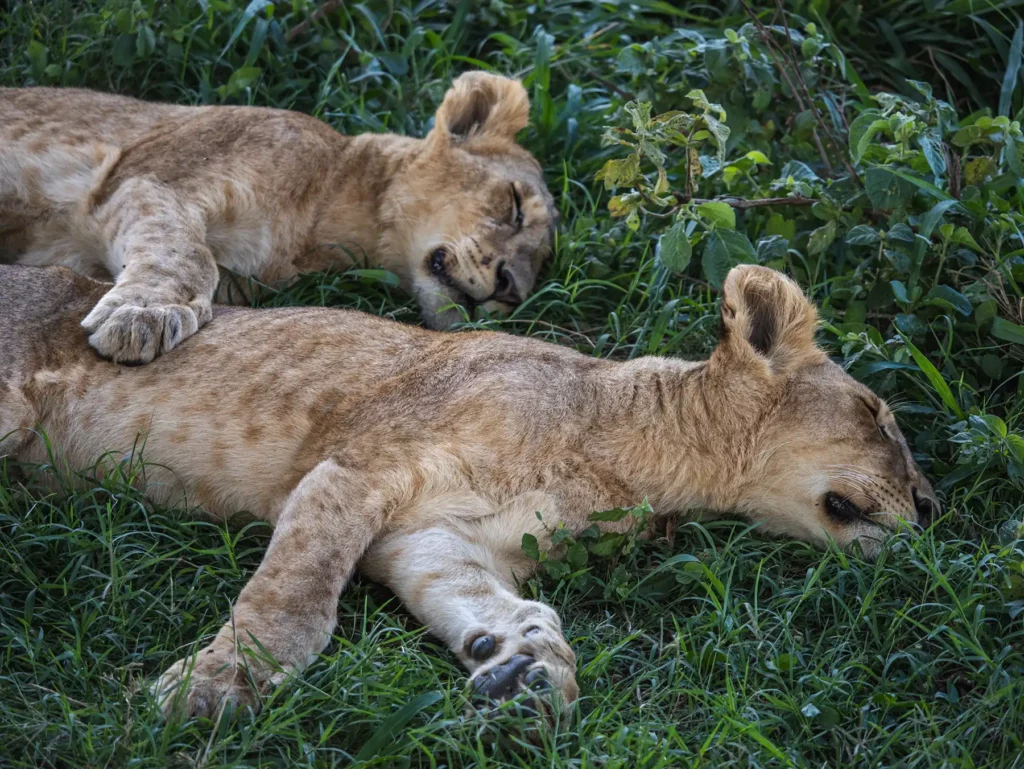
Why Go on Safari in Tanzania?
Having visited Tanzania extensively, I could easily write a book about why you should choose Tanzania for your safari.
For starters, the Serengeti, Tarangire National Park, and Ngorongoro Crater, which are clustered close together in Northern Tanzania, all rate among the most pristine wilderness spaces and iconic safari destinations found anywhere on the planet.
In the south of Tanzania you have the large Ruaha National Park and the enormous Nyerere National Park, which both provide a unique opportunity to see African wild dogs as well as providing a more exclusive experience with less visitors compared to the north.
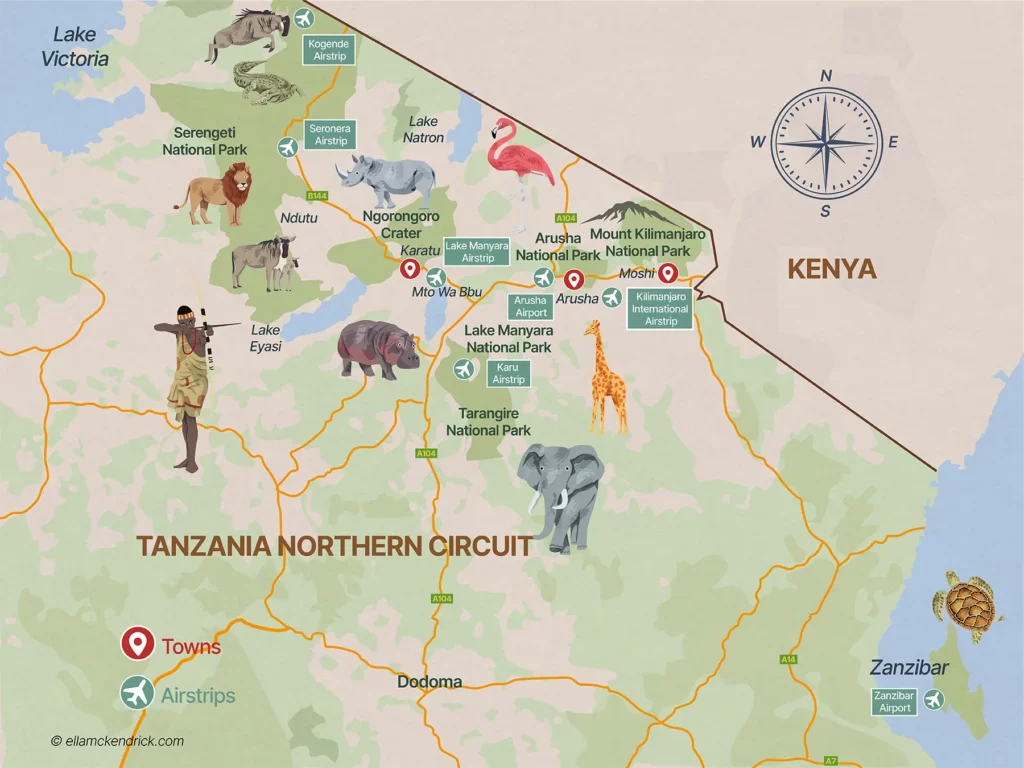
Tanzania is one of the best places to witness Africa’s big cats, the Big Five (lions, elephants, leopards, rhinos and buffalos), and vast numbers of other wildlife such as cheetahs, hippos, crocs, giraffes, zebras, hyenas, jackals, wildebeest and an endless list of buck and bird species.
Not only that, but Tanzania also co-hosts the planet’s second largest land-based animal migration (for years it was thought to be the largest until an even bigger migration was found in South Sudan). Considered one of the greatest shows on earth, there’s nothing like witnessing over two million wildebeests and zebras tearing flat-out and non-stop through the Serengeti landscape, crossing numerous crocodile-infested rivers on the way.
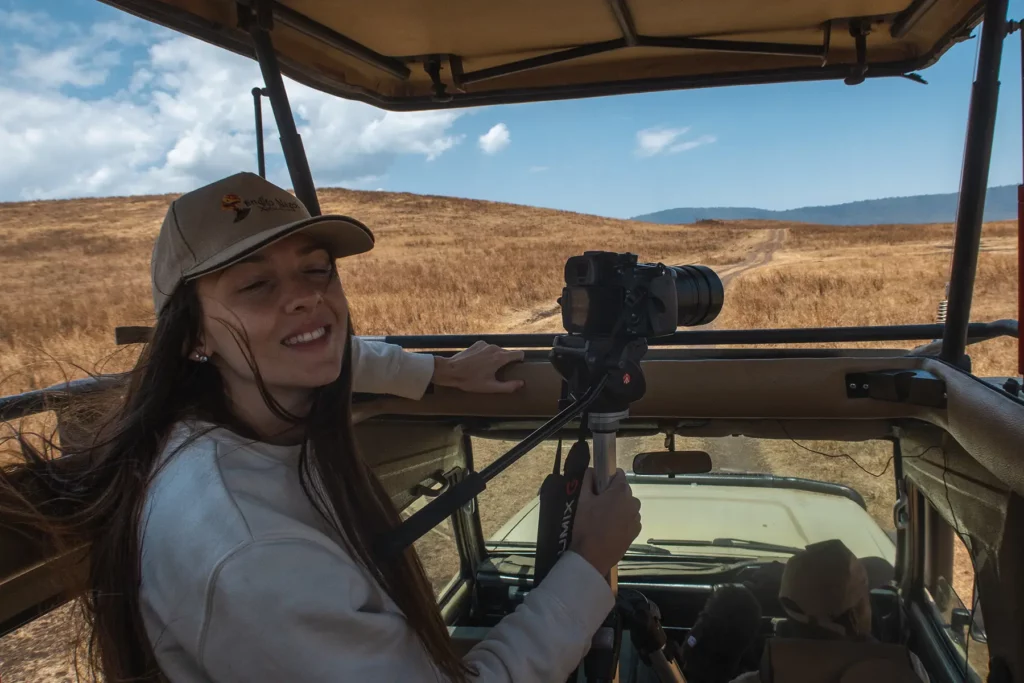
The landscapes are stunning too. From Africa’s tallest mountain, the imposing Mount Kilimanjaro, to the numerous lakes, including Lake Tanganyika which is the longest and second deepest lake in the world, and a stunning coastline and the gorgeous and historic Zanzibar Islands. All these provide extra reasons to go on safari in Tanzania.
As for the culture, Tanzania is home to over 100 ethnic tribes, each with its own identity, fascinating traditions and dialects. These include the fearsome Maasai, the economically powerful Chagga, and the Hadzabe, the world’s last genuine nomadic hunter-gatherer tribe.
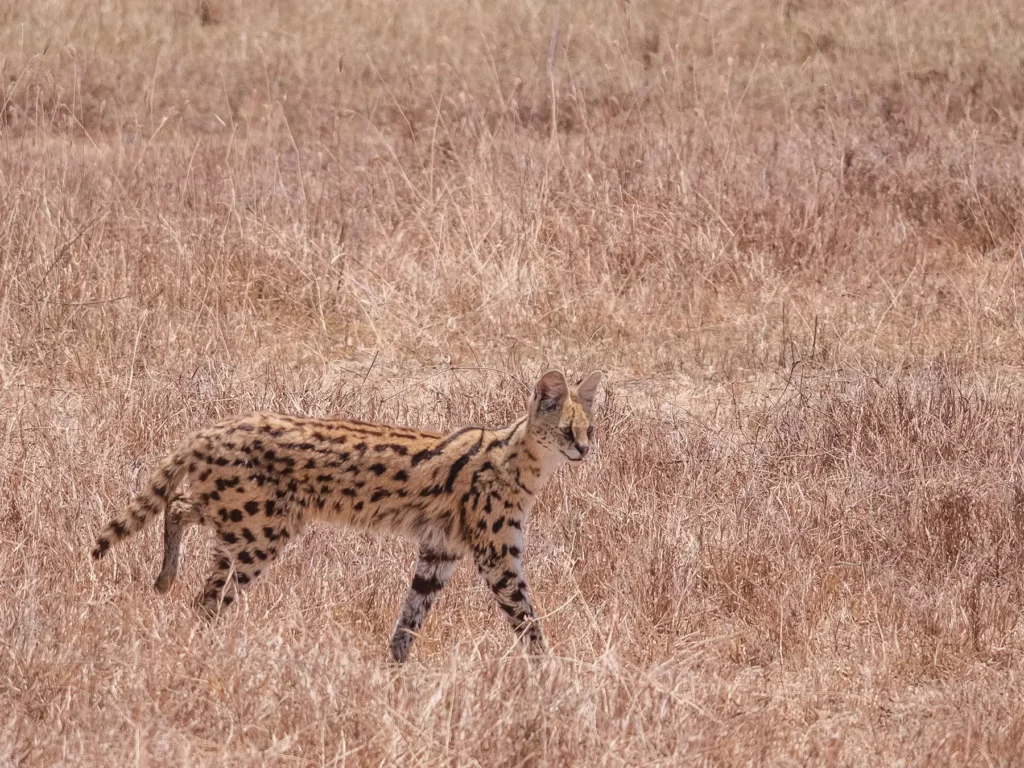
How to Book Your Tanzania Safari
With so many game parks, lodges, camps, tour operators and safari types, selecting and booking a Tanzania safari can seem like a daunting task, especially for first-time visitors.
But there’s no need to be overwhelmed; in this section, I’m going to provide you with an overview of each of your four booking options as well as my top recommendation.
You can jump to the booking options using the links below.
You can get quotes from the same local tour companies I use to organise my own trips here: Safaris By Ella

Option 1: Self-Drive Safari
When you start thinking about what sort of safari experience you want, the first task is to choose between these two key safari options – a self-drive or a guided safari.
Those who pick a self-drive safari usually do so partly for the freedom and flexibility, but mainly as this can seem like a more budget-friendly option. After all, you’ll save costs by not paying for a driver guide. Right?
Well, not necessarily. Although you’ll likely save a little money choosing a self-driving safari, the savings may be much smaller than you’d imagine. In my opinion, the slightly lower cost doesn’t warrant the cons you’ll get from not having a guide.
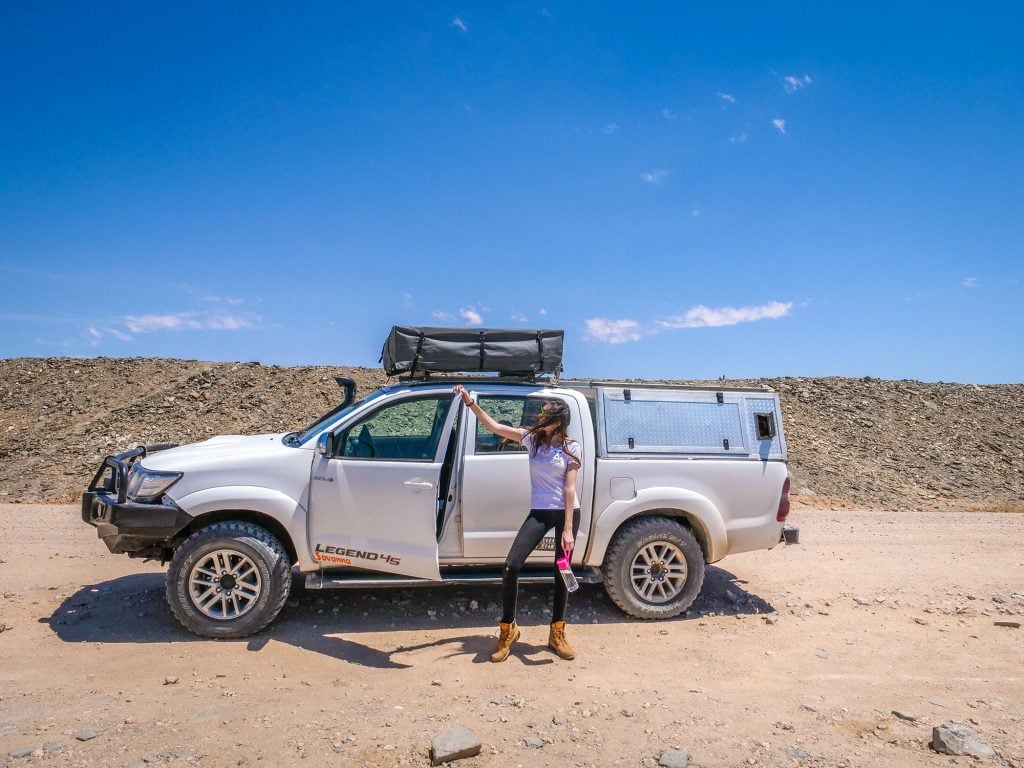
Firstly, park fees form the largest chunk of safari costs, and these remain the same regardless of whether you’re on a self-drive or a guided drive safari.
Secondly, self-drive safaris require you to hire a 4×4 vehicle and ensure you always have enough fuel to get you to the next filling station. Thirdly, you’ll have to make your own arrangements in the event of an accident, a breakdown, a flat tyre, or getting stuck in some remote area surrounded by wild animals.
Once you add up all these costs, the savings might not be as great as you expected.
But in my opinion, the main reason not to choose a self-driving safari is that having a guide is invaluable. I mean, be honest with yourself, how good are you at spotting wild animals in a vast, unfamiliar terrain?
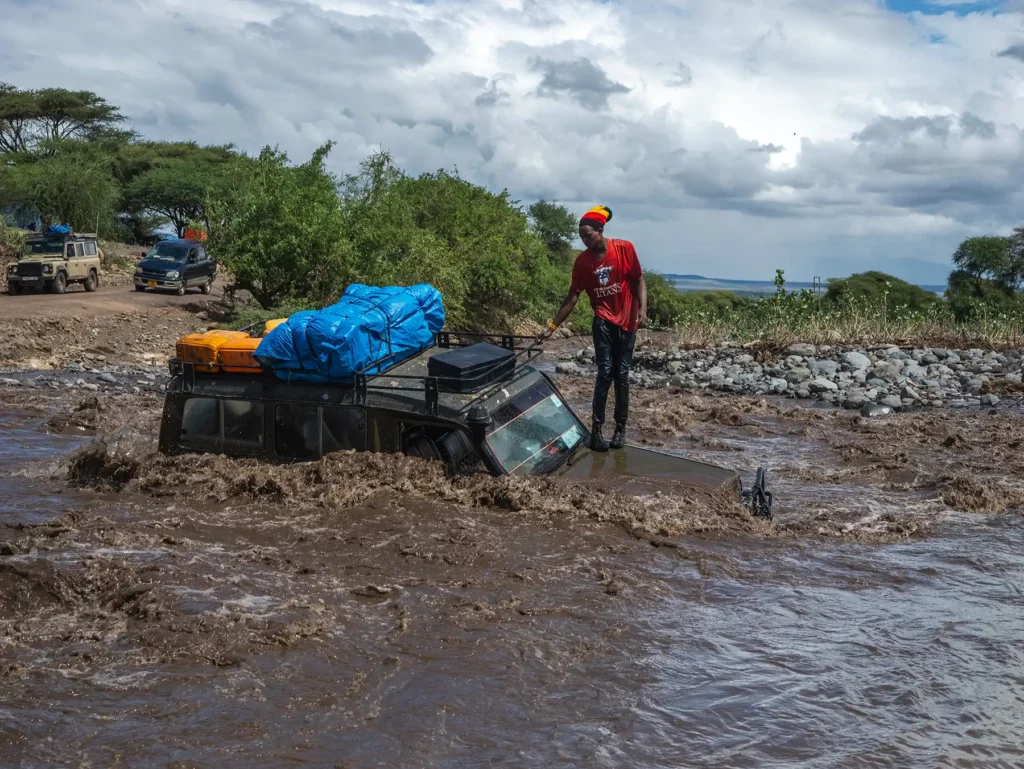
Tour guides are extremely knowledgeable about each park and the local wildlife’s habits and behaviour. Not only will they point out animals that you’d likely miss without them, but also share their fascinating insights into the wildlife and ecosystems here.
Guides know the best spots to observe certain animals at different times of the day or year. They’re also in constant radio contact with other safari guides and can get you to a rare sighting quickly.
Honestly, what you save in money, you’ll likely lose in time and effort from driving aimlessly around the bush. I have seen far too many self-drivers getting lost in the parks and seeking help from other drivers.
Although self-drive safaris may be suitable in vast, flat and open landscapes such as those found in the arid landscapes of Namibia where game is easy to spot and the roads are wide and straight, I wouldn’t recommend them in Tanzania – especially if it’s your first time in the country.
How to Book a DIY Self-Drive Tanzania Safari
- Option 1: Comparison sites which provide multiple quotes from verified suppliers such as Safaris By Ella. Make sure to write you want to self drive in the notes when requesting a quote. (This is a hybrid approach where you’ll drive yourself but they will arrange everything)
- Option 2: Research and book all elements of the trip yourself using Google and online travel agents.
Join the rapidly growing tribe of over 1,000 travellers who’ve booked their dream safari using my insider tips and recommendations. Get your free quotes and my top tips and recommendations now.
Option 2: Local Tour Operator
Booking a guided safari with a local tour operator is a hassle-free safari option.
Your chosen operator will take care of your accommodation, park fees, vehicles, driver guides, and even meals and beverages for your game drives. On your arrival, they can also arrange to pick you up from the airport and take you straight to your lodge – this can be such an asset after a long flight! It’s also a lot safer than hopping in a taxi as I’ve found many of the taxi drivers drive recklessly.
Once you’ve chosen your local tour operator, you can then choose between a private safari (where it’s just you and the guide) or a group tour (these are usually up to eight people).
If budget allows, a private safari offers the best option as you have the freedom and flexibility to do and go wherever you want. Tour operators also tend to keep their best guides for private safaris. And with no other guests, they can be fully attentive to your needs and questions.
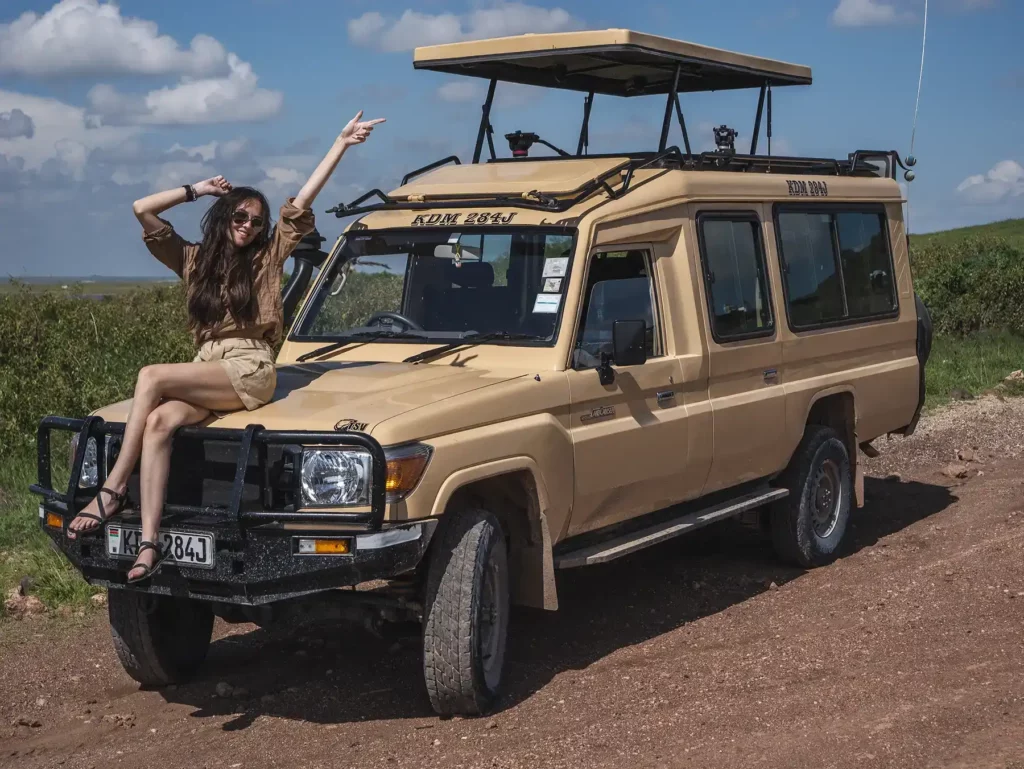
That said, group tours (which are slightly cheaper) can still be a great experience, especially if you’re a solo traveller, so don’t feel like you’re missing out if you can’t stretch to the pricier private option. The downside is that things are understandably less flexible; you’ll have less of a say in everything from choosing your lodge, and park, or what time to get up in the morning.
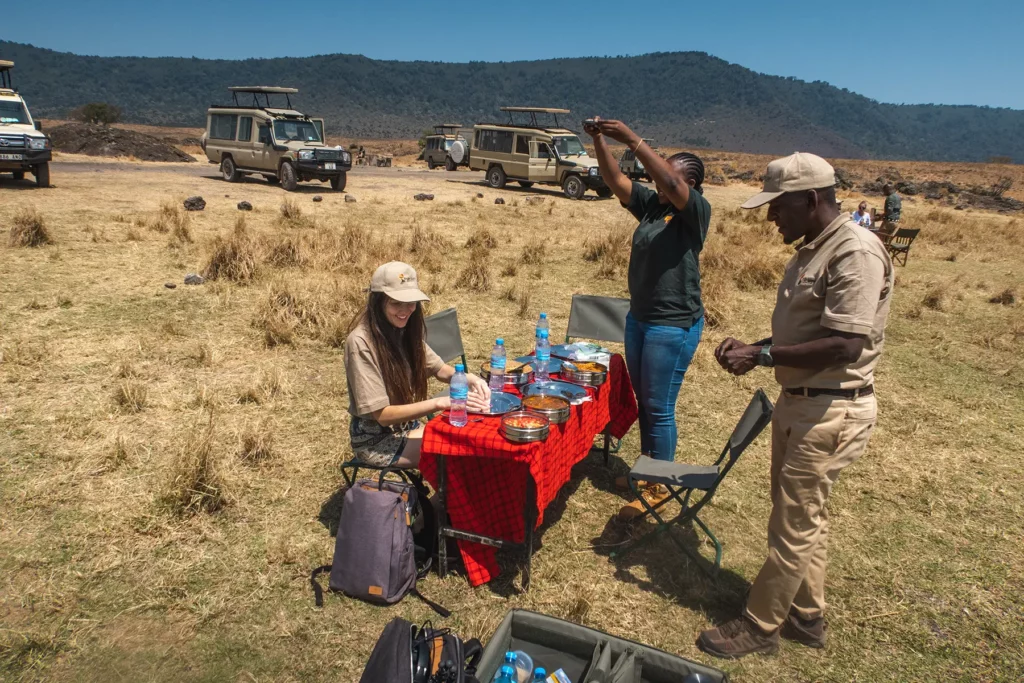
When choosing your local tour operator, make sure you do your homework. Services vary between different operators, and it’s essential to read customer reviews. I suggest using Google reviews (or another impartial review site) as opposed to those shared on company websites – there’s a good chance they’ll only share the favourable ones!
Having spent a lot of time visiting Tanzania’s game parks with many tour operators, I feel confident that I can recommend certain safari tour operators in Tanzania. I trust these will provide you with the best all-round experience and services, and help bring your dream safari to life.
How to Book with the Best Local Safari Companies
- Comparison sites which provide multiple quotes from verified suppliers such as Safaris By Ella
Join the rapidly growing tribe of over 1,000 travellers who’ve booked their dream safari using my insider tips and recommendations.
Option 3: International Travel Agents
While booking through an international travel agent may seem like the more convenient option, it will undoubtedly be far more expensive than going straight to a local tour operator.
Why? Well, international travel agents act like middlemen between you and the operators and therefore mark up the cost of each service to make a profit. However, your safari experience will remain the same regardless of who you book with. The only difference is that international agents are able to book your international flights as well, providing you with a complete package.
A benefit of international tour operators is that they are usually ‘bonded’ which in theory provides payment protection should they go bust before your trip.
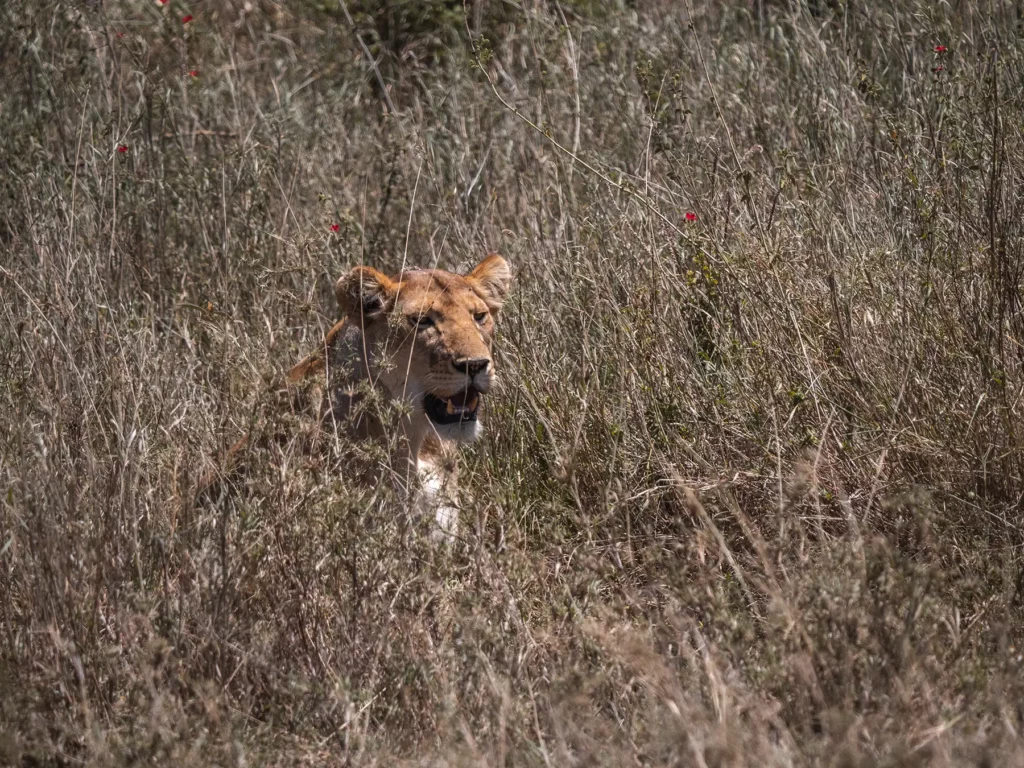
In my experience, it’s just as easy to book your Tanzanian safari adventure through a local tour operator online, thus cutting out the ‘middleman’ and making your trip less expensive. I used to book with international travel agencies until I realised that I was just paying over the odds for the same service. Now I always choose local!
Regarding payment protection when I book with trusted local companies, I sometimes pay the deposit via credit card which gives me purchase protection and I typically pay the balance closer to the trip. I’ve always had a good experience booking with local providers but I do choose them very carefully.
How to Book Your Safari with an International Travel Agent / Safari Company
- Comparison sites which provide multiple quotes from verified suppliers such as Safaris By Ella. When you select a luxury budget on the quote request, you will receive a quote from my recommended International safari company as well as my recommended local companies for comparison.
Join the rapidly growing tribe of over 1,000 travellers who’ve booked their dream safari using my insider tips and recommendations.
Option 4: Fly-In Hotel Safaris
Getting to and from each park by road can be lengthy and exhausting. Although some national parks are close to one another, Tanzania is still a vast country.
And not to mention that the roads here probably aren’t like the highways you’re used to at home! Instead, you should expect many long and uncomfortable hours spent on rough dirt roads.
That’s where fly-in safaris come in.
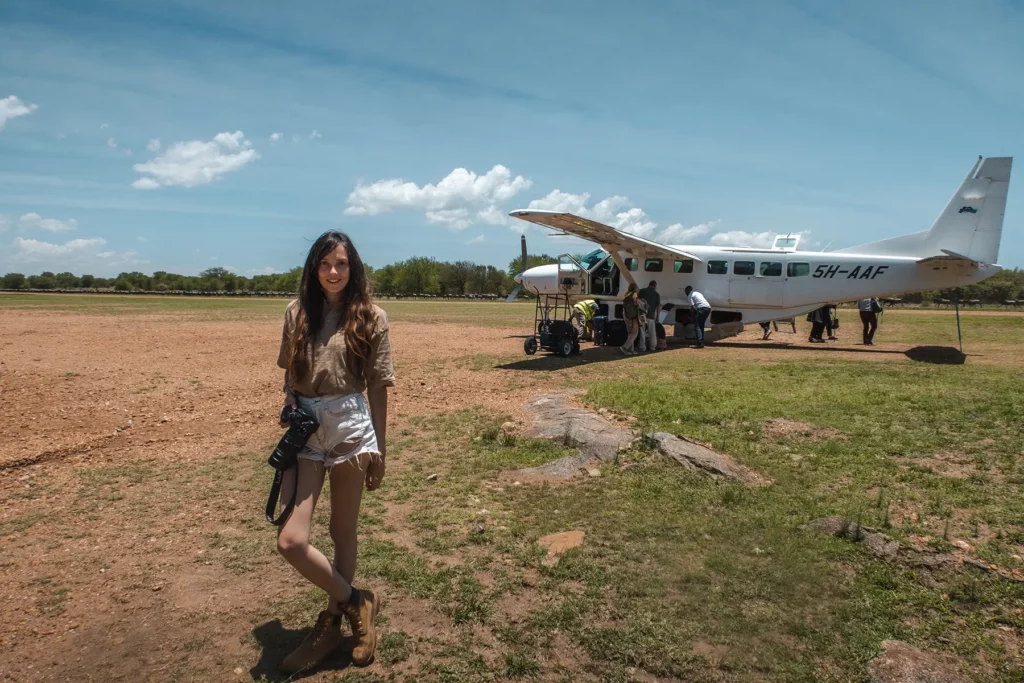
Most of Tanzania’s main parks, hotels and lodges are situated close to airstrips, making fly-in hotel safaris an easier option. Alongside being more comfortable, you’ll also save hours or even days of drive time, so these safaris are often a popular option for those who don’t have much time in the country.
As you can imagine, the downside is the cost – fly-in safaris are by far the most expensive safari option. Depending on the season, availability of flights and distance travelled, flights may cost anything from $100 to over $500 per person.
Another downside is that you’re unlikely to get the safari vehicle to yourself. As lodges only have limited vehicles, lodge guests often go out in full vehicles. This means less flexibility with how long you’re on safari for and which animals you prioritise. It also means you could be jostling with other guests for the best viewing spots.
How to Book a Hotel-Provided Safari
- Option 1: My recommended tour operators on Safaris By Ella can arrange hotels and air or road transport to and from the hotels. If you opt for the more cost-effective road transport, since they have driven you to the hotel, you might find it cheaper to use the safari company for safaris rather than using the hotel-provided safaris.
- Option 2: Check with your chosen accommodation whether they provide this service and the booking requirements.
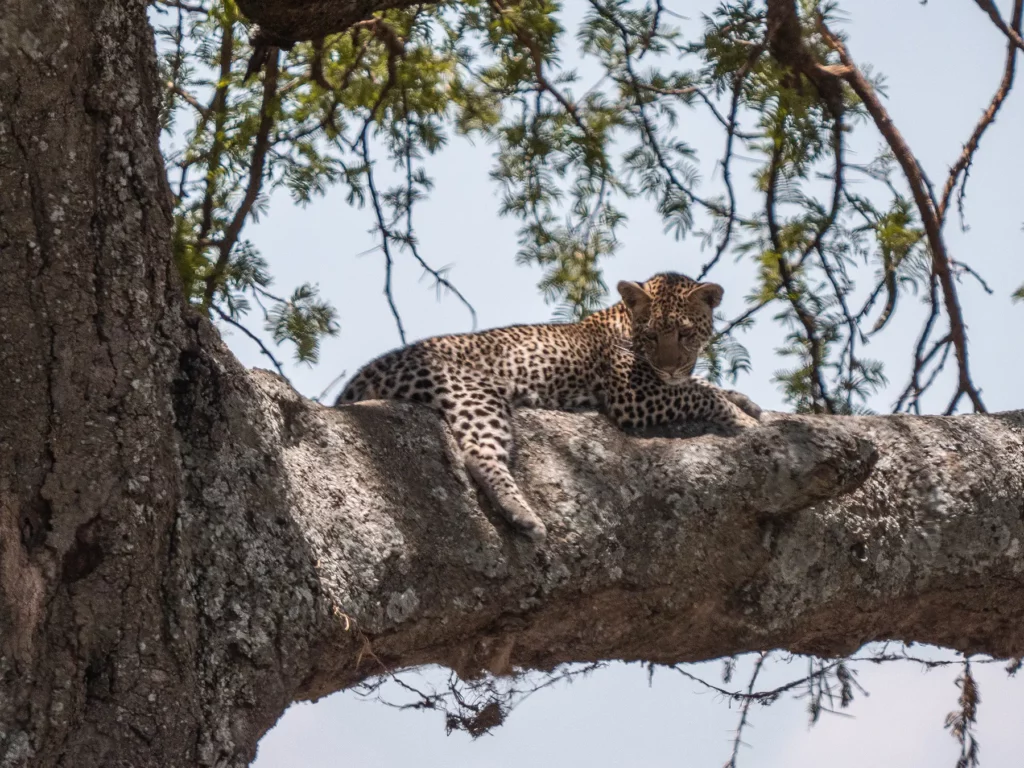
So, what is the best way to book a safari?
In my experience, using a local tour operator to book your safari is the best way to go. It’s the best value for money and provides you with, in my opinion, the best experience.
Local tour operators take care of everything (apart from international flights), providing you with a hassle-free experience, and your driver guide is truly invaluable. With their insider information you’re more likely to have fantastic sightings and their knowledge of the area means that the entire safari experience will go a lot smoothly than if you orchestrated it yourself.
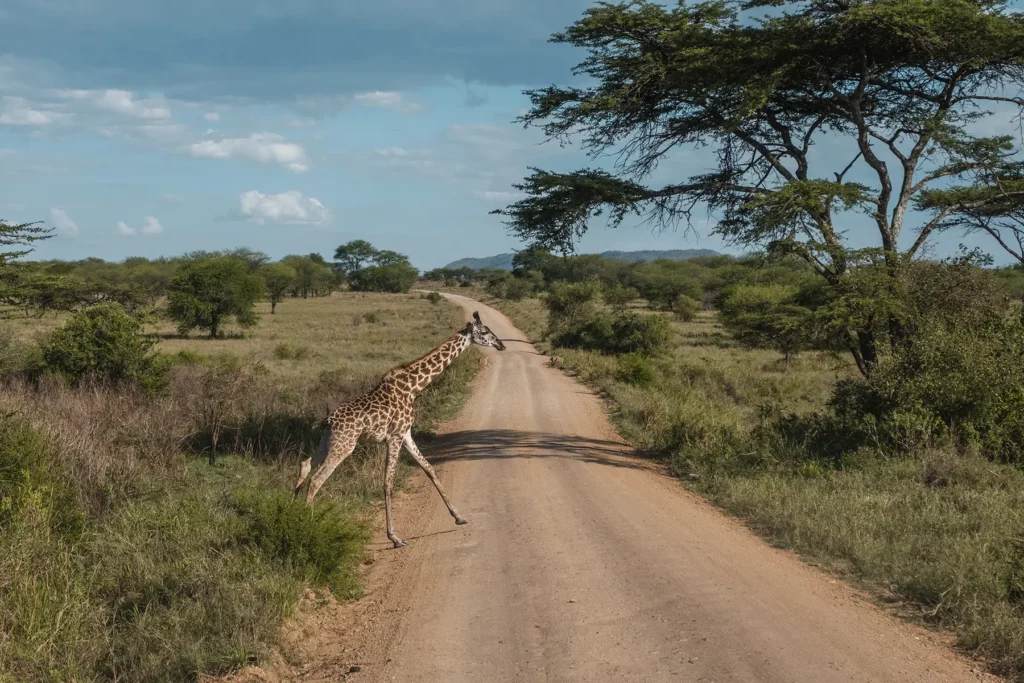
How Much Does a Tanzania Safari Cost?
Many different factors affect how much your Tanzania safari will cost, from accommodation to park fees and specific activities. However, the below will give you a good estimate of safari costs based on booking through a local operator.
If you want a more in-depth cost breakdown, you can check out my up-to-date guide to Tanzania safari costs.
Usually, private safari tours cost from around $350 per person per day. This includes hotels, park fees, all meals, transfers and all activities. On the luxury end, you could spend up to $650+ per day, whereas mid-range will set you back around $450 each day.
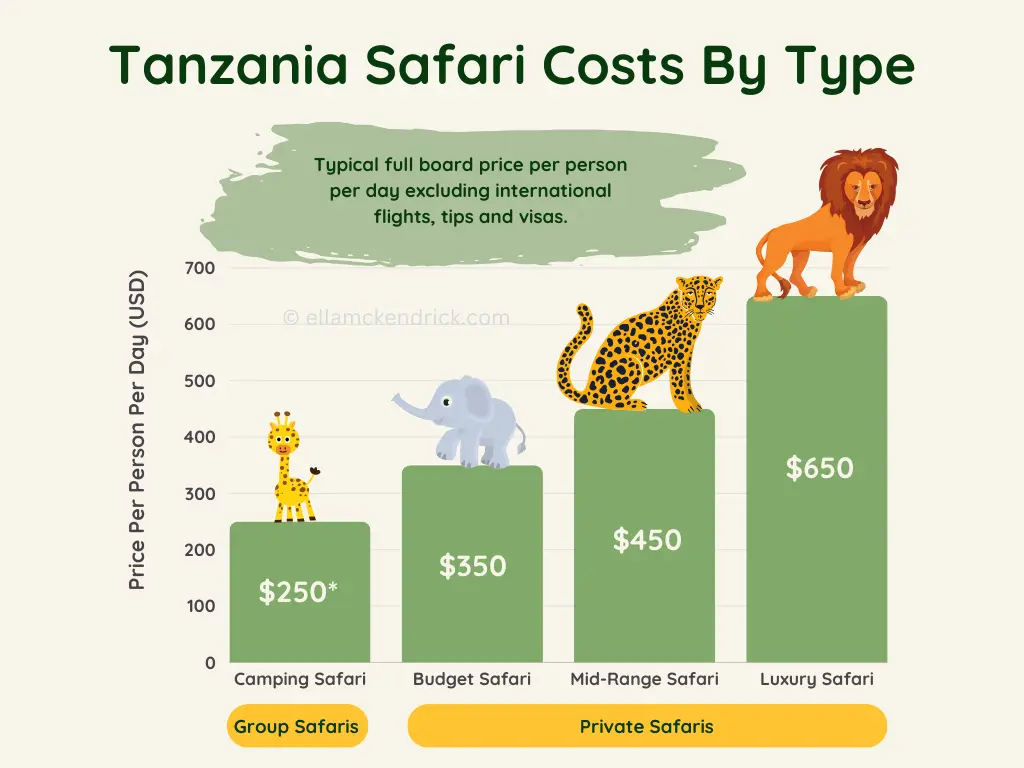
Alternatively, shared group safaris are a more budget-friendly option, costing from around $250 per person per day. Shared safari costs usually include basic camping accommodation. When booking a shared safari however be sure to check reviews, as some cheaper options have questionable facilities, and a bit of extra comfort might be more enjoyable.
Bear in mind that costs are also impacted by the season you visit. Generally speaking, prices are 20-30% lower in the low season (March to May) and 12-14% cheaper in the shoulder seasons (Jan, Feb, Nov, Dec). Peak season (June to October) is the most expensive time to visit.
Please note that the costs above are for booking through a local operator, and will be more expensive if you book through an overseas travel agent.
Below I’ve included a chart which breaks down where the money goes for a safari of 2 people.
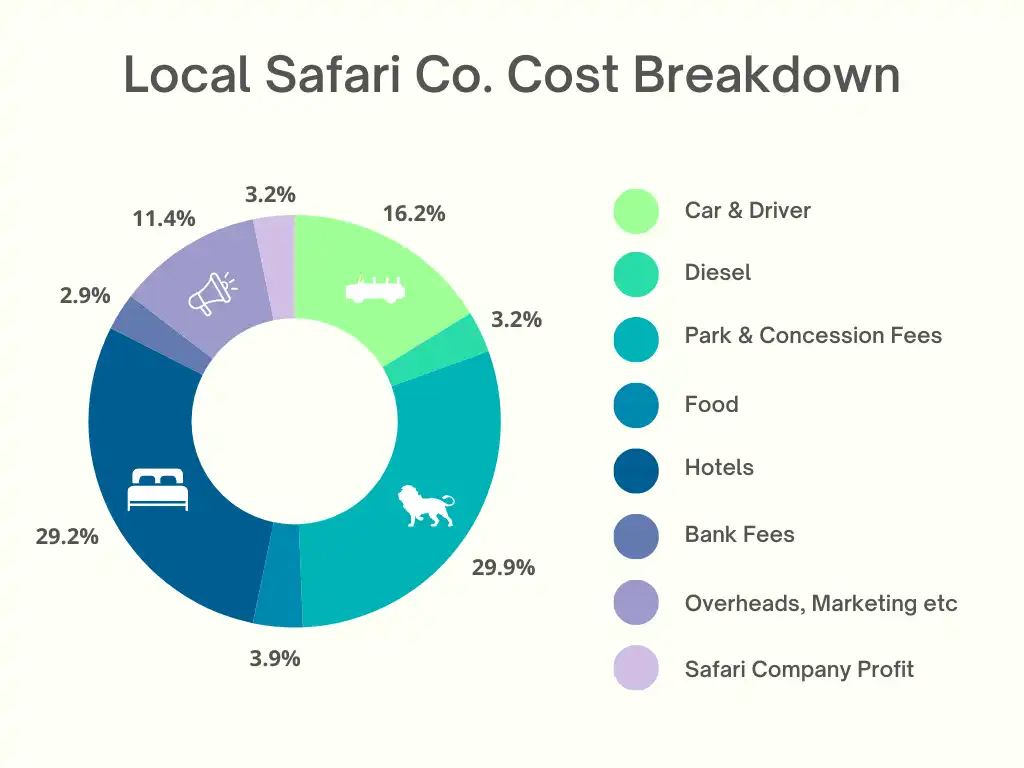
You’ll also need to budget for travel vaccinations and malaria tablets, safari-appropriate clothing if you don’t own some already, souvenirs, tips, and any optional additional activities you’d like to do that aren’t included in your safari package.
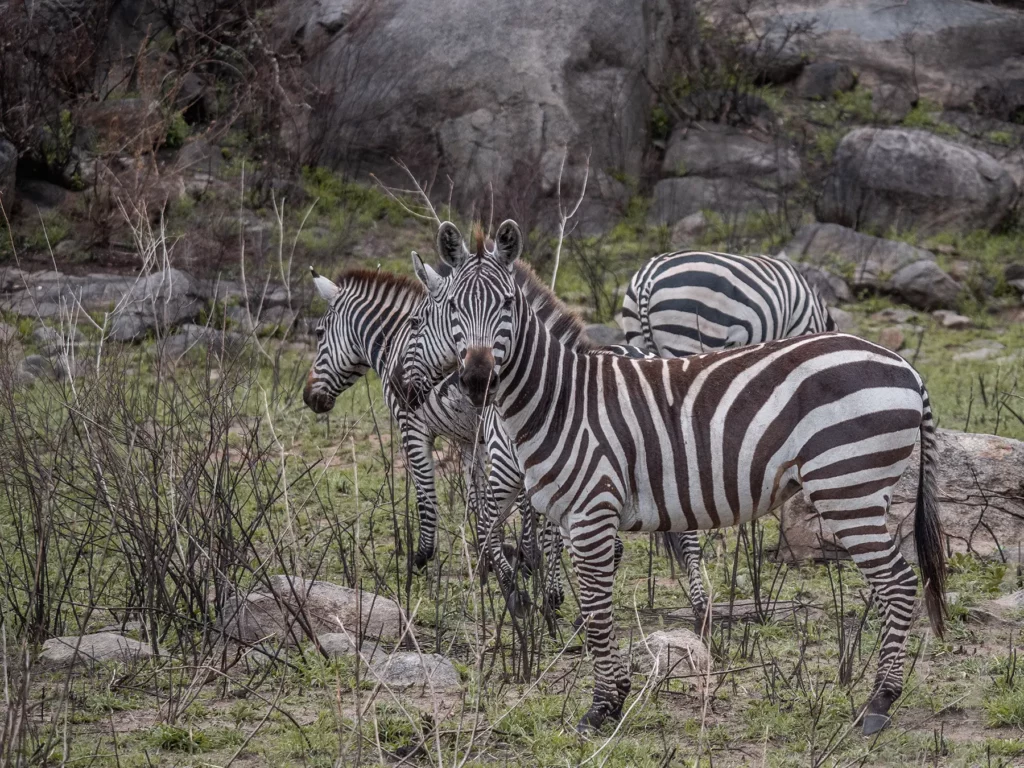
Best Time to Go on Safari in Tanzania
Tanzania is an all-year-round destination, and every month has something unique to offer.
I’ve ranked each month of the year for safari in Tanzania as Excellent, Good, OK, or Poor, based on typical game viewing and weather conditions.
- Excellent
- Good
- OK
- Poor
Jan
Feb
Mar
Apr
May
Jun
Jul
Aug
Sep
Oct
Nov
Dec
If you want to dig deeper, the chart below shows what you can expect in each month in Tanzania in terms of cost, weather, wildlife and hiking Kilimanjaro.
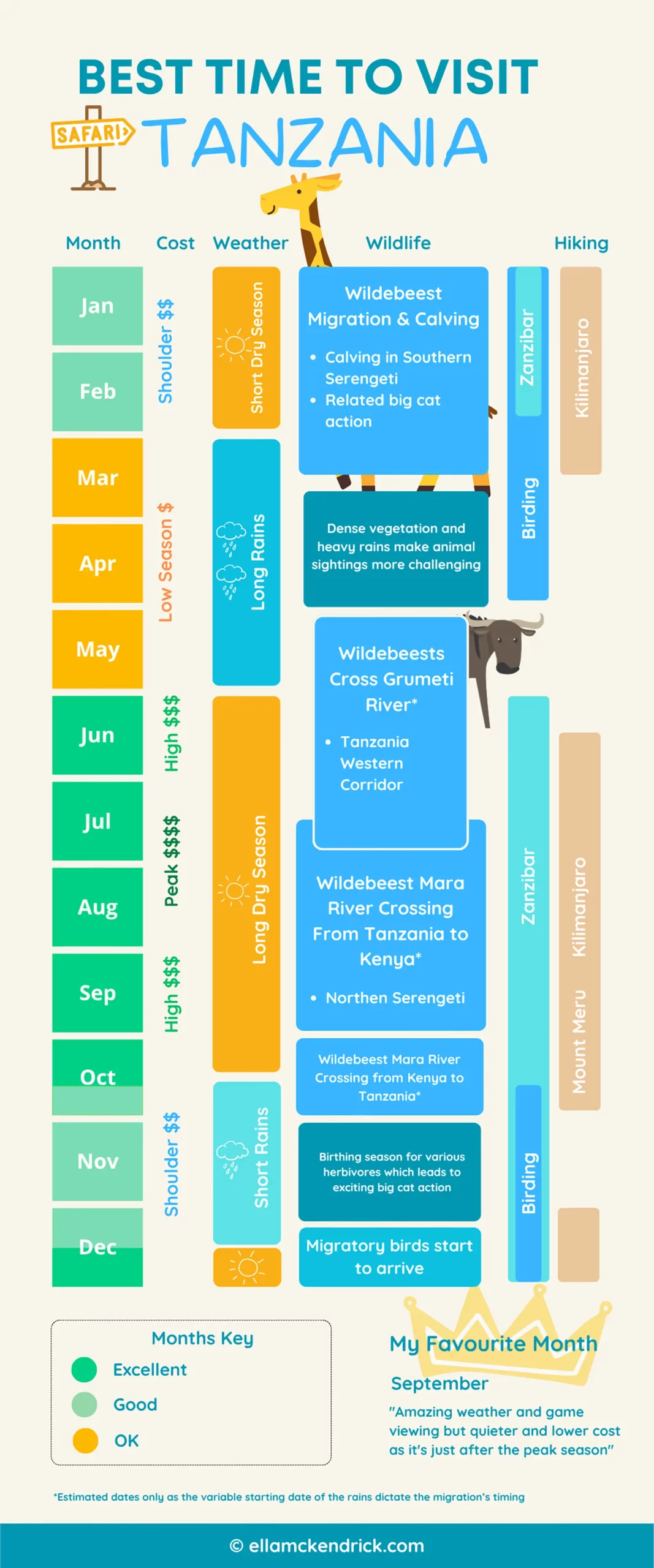
For more information take a look at my ultimate guide on the Best Time to Visit Tanzania.
The Long-Dry Season (June – Mid-October)
That said, the best time to go on safari in Tanzania is during the long dry season (June to mid-October). During the dry season, the grasses are short and the vegetation is sparse, which makes it easier to spot animals. Animals tend to congregate close to lakes, waterholes and river banks, also adding to the ease of seeing them.
Another benefit of visiting from June to mid-October is that mosquito populations are at their lowest during this period, which means there is a lower risk of malaria. (Not to mention how annoying mosquitos are!)
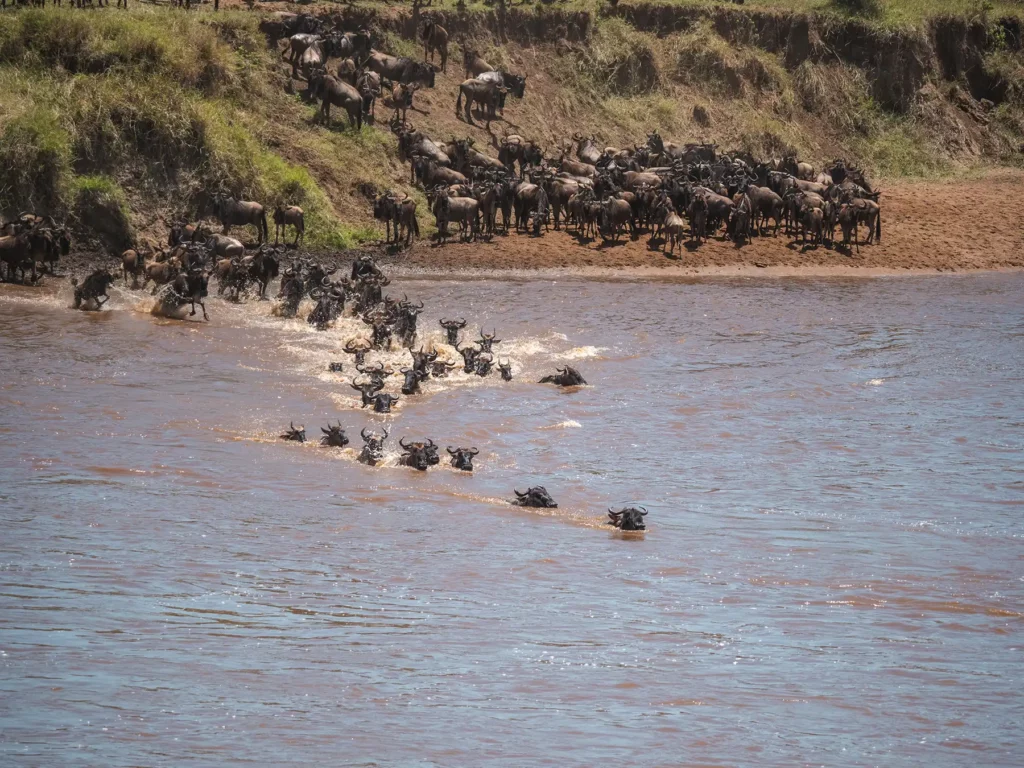
June to mid-October is also an ideal time to visit the coast and the Zanzibar Islands. The weather is perfect for beach days, snorkelling the coral reefs, or swimming in the calm coastal waters. Further inland, it’s a good time for hiking Mount Kilimanjaro, although it does get pretty chilly near the summit.
The only negative is that booking your safari during the long dry season is more expensive. Parks are at their busiest and costs are high. Make sure you book well in advance to get a good deal.
If the main reason you’re visiting Tanzania is to witness the Great Wildebeest Migration, particularly at the infamous Mara River crossing, July to September is the ideal time to visit.
But if you’re not able to visit during the dry season, you can still have a fantastic trip during the other months.
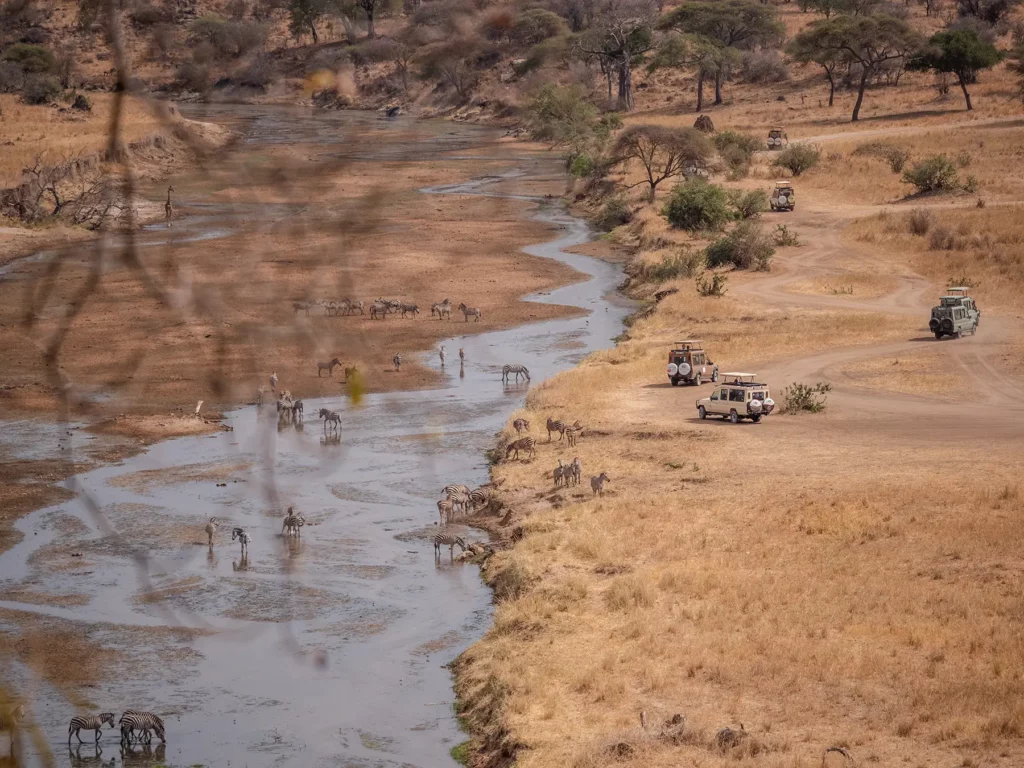
The Short Dry Season (January and February)
Mid-January to mid-February is the best time to see baby animals in the southern regions of the Serengeti. Over 8,000 wildebeest calves and thousands of various buck species are born during this short period! All these baby animals bring out Tanzania’s big cats and other predators so it’s an excellent time to see them in action.
These months are known as the “short dry season” so it’s a pleasant time to travel. The vibrant greenery of the landscape is a stunning backdrop, as it remains lush and dense from the earlier rains. However, it can make spotting animals a little harder in some areas.
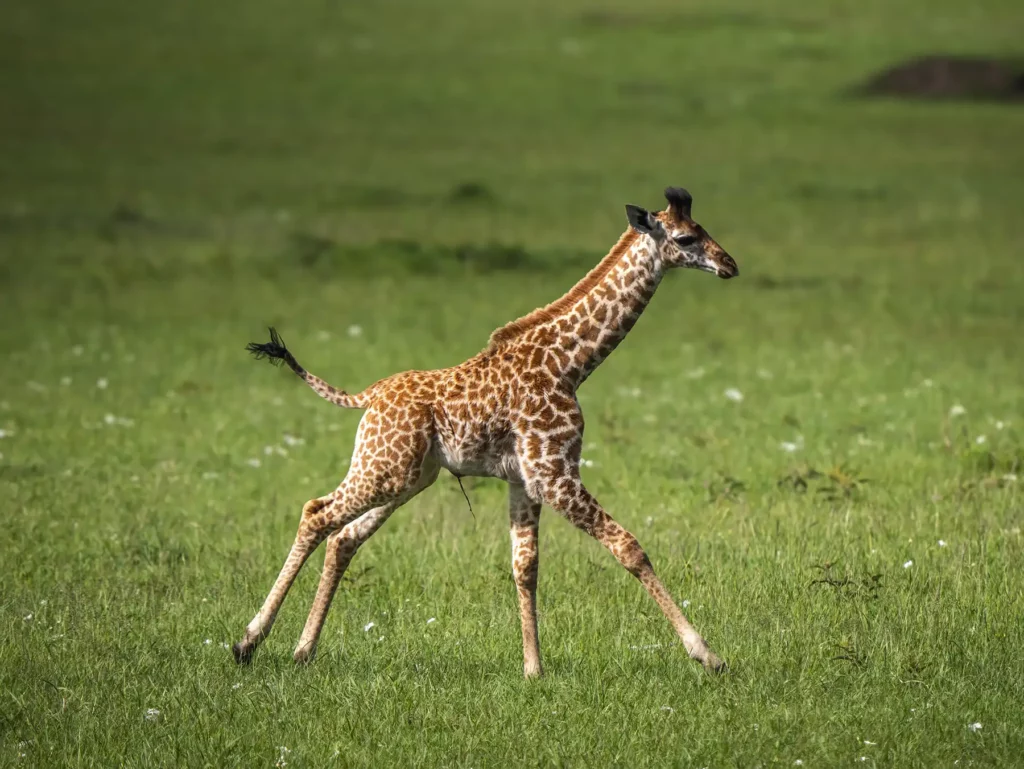
Short Rains (Mid-October to Mid-December)
During the short rains be prepared for some rain, often in the afternoon. Prices and lower compared to the peak period and parks are quieter. Mid-Oct to mid-November gives the chance of seeing the Wildebeests crossing back across the Mara River as part of the year-round Great Migration.
Birding is good at this time of year and it’s a birthing season for some herbivores, leading to related big cat action. Zanzibar and Kilimanjaro are not a their best at this time of year although Kilimanjaro hiking starts to get better in December.
Foe me the main benefit of this time of year is the lower visitor numbers in the park which enhances the game viewing experience.
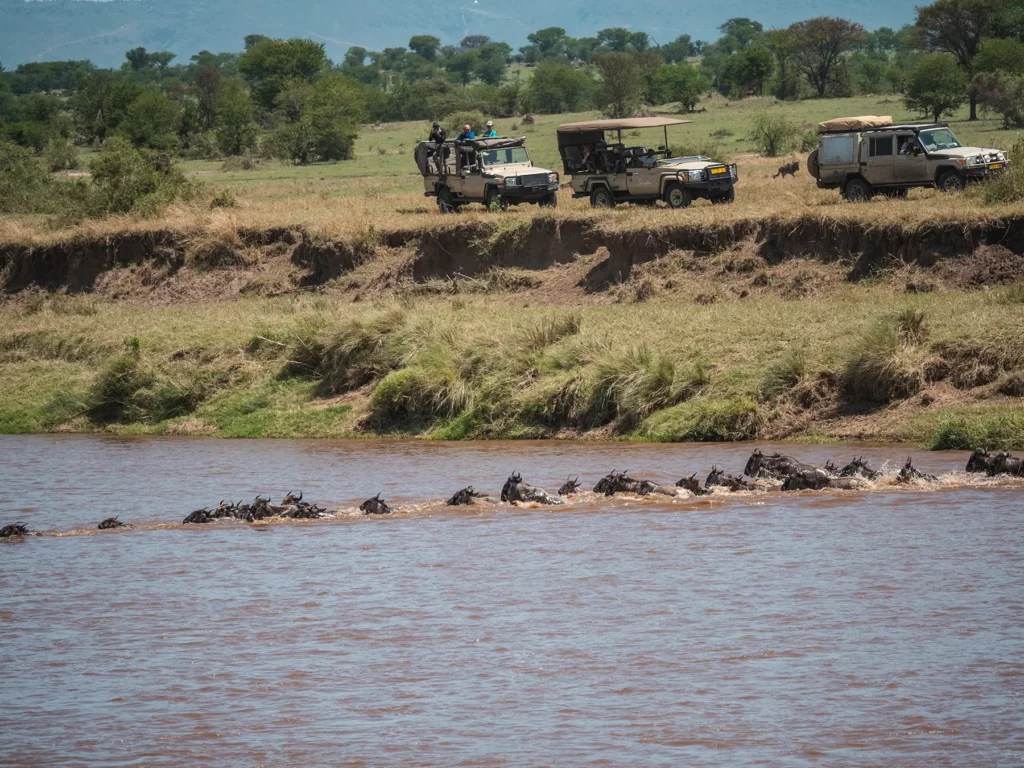
The Long Rainy Season (March – May)
The wet season runs during March, April, and May, and this is the time I’d suggest avoiding for most visitors. Known locally as “the long rains,” these months are met with frequent showers and thunderstorms during the afternoons, and it can get uncomfortably humid too.
On the bright side, this is a good time to visit Tanzania for birdwatchers. Many migratory birds have arrived from the northern hemisphere, and breeding season is in full swing with many entertaining courtship rituals on display. As parks and lodges are quietest during the low season, prices are also lower.
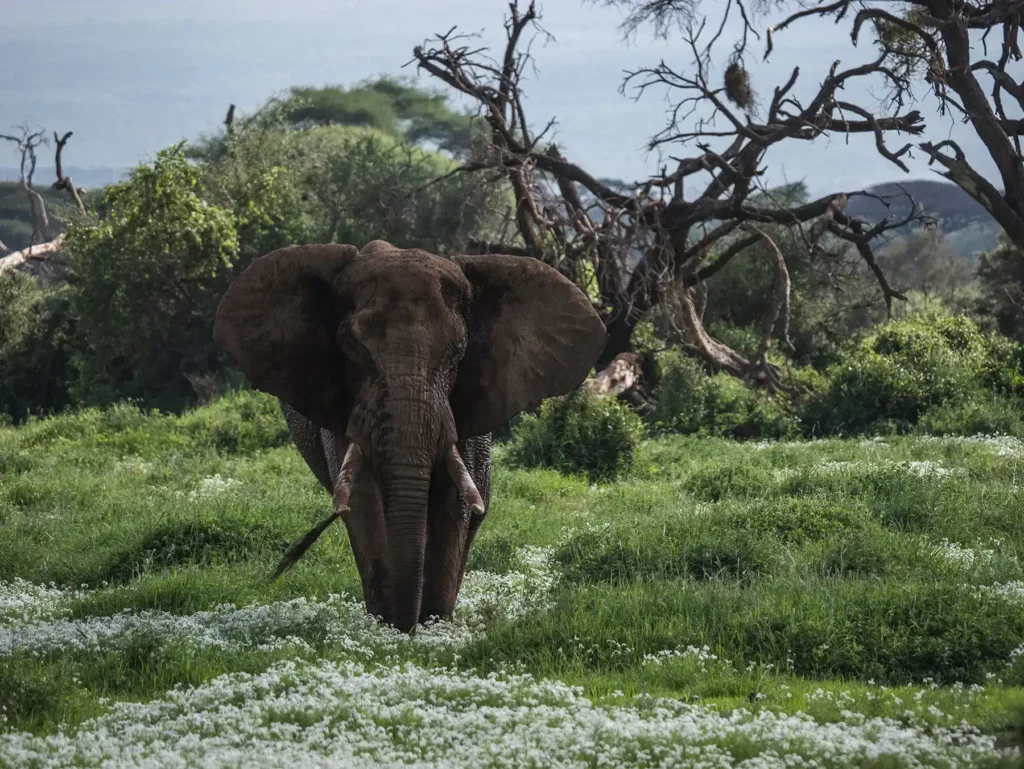
My Favourite Time to Visit Tanzania
If I had to choose one month to visit Tanzania, for me, it would have to be September. The weather is still great at the tail-end of summer, but visitors have started to thin out so prices are a bit lower. There’s also tons of wildlife to see and the Great Migration is approaching its dramatic climax in the northern Serengeti.
For further information, you can read my full guide on the best time to go on safari in Tanzania.
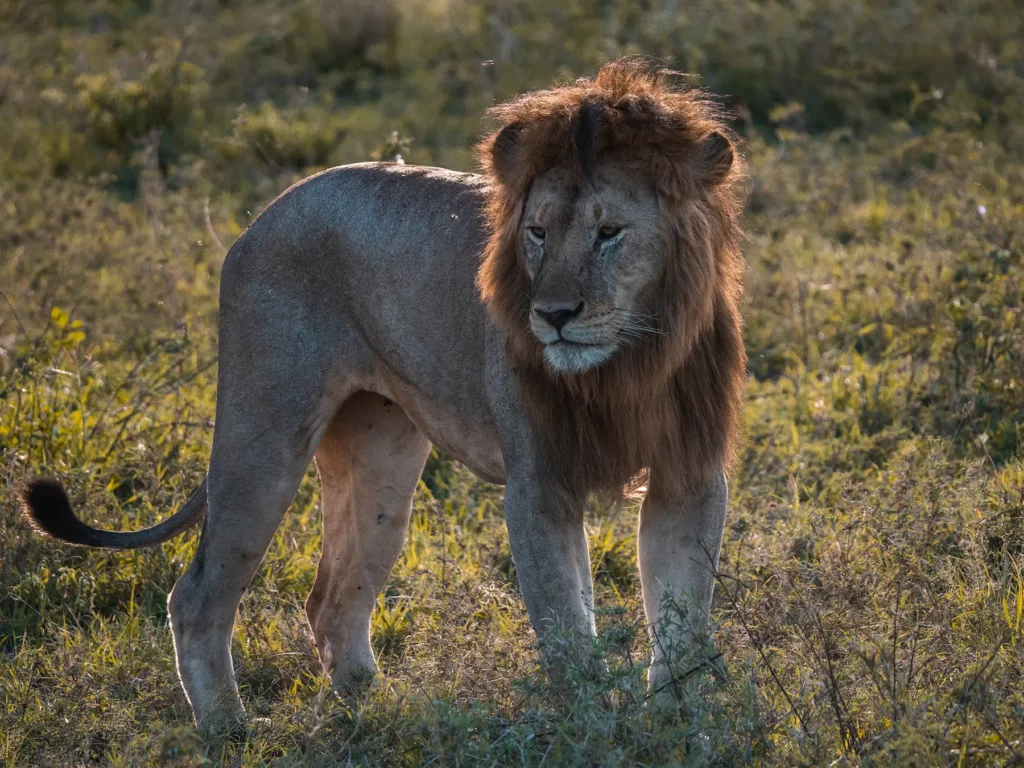
How Long to Spend in Tanzania
Although you can get a taste of Tanzania on a 3-day or 5-day itinerary, shorter itineraries only allow you to scratch the surface, and you may leave feeling rushed and like you missed out on a lot of what the country offers.
Ideally, I recommend spending at least 7-10 days in Tanzania on safari, and 2 weeks in Tanzania will give you long enough to truly appreciate and immerse yourself in the landscapes and wildlife here.
That said, if you’re hoping to see some hidden gems and get to know Tanzanian culture, alongside soaking up its contrasting landscapes with a stop at the coast, then this 3-week itinerary is ideal. Tanzania is a huge country, so it’s simply impossible to fully understand what makes it special in under three weeks!
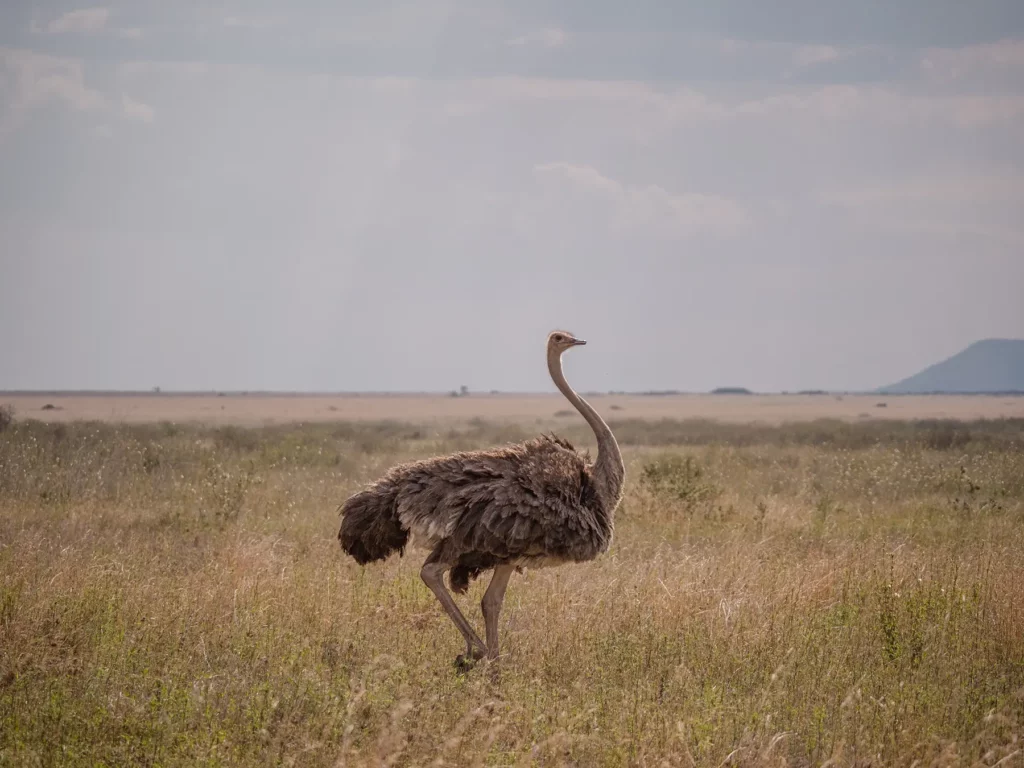
Tanzania Safari Logistics
If you’ve booked through a travel agent or tour operator, they’ll take care of most of the safari logistics for you.
However, there are still a few things left over that you’ll need to arrange yourself. These include visas, vaccinations, and medication.
To get you up to speed, we’ll take you through everything else you need to know below.
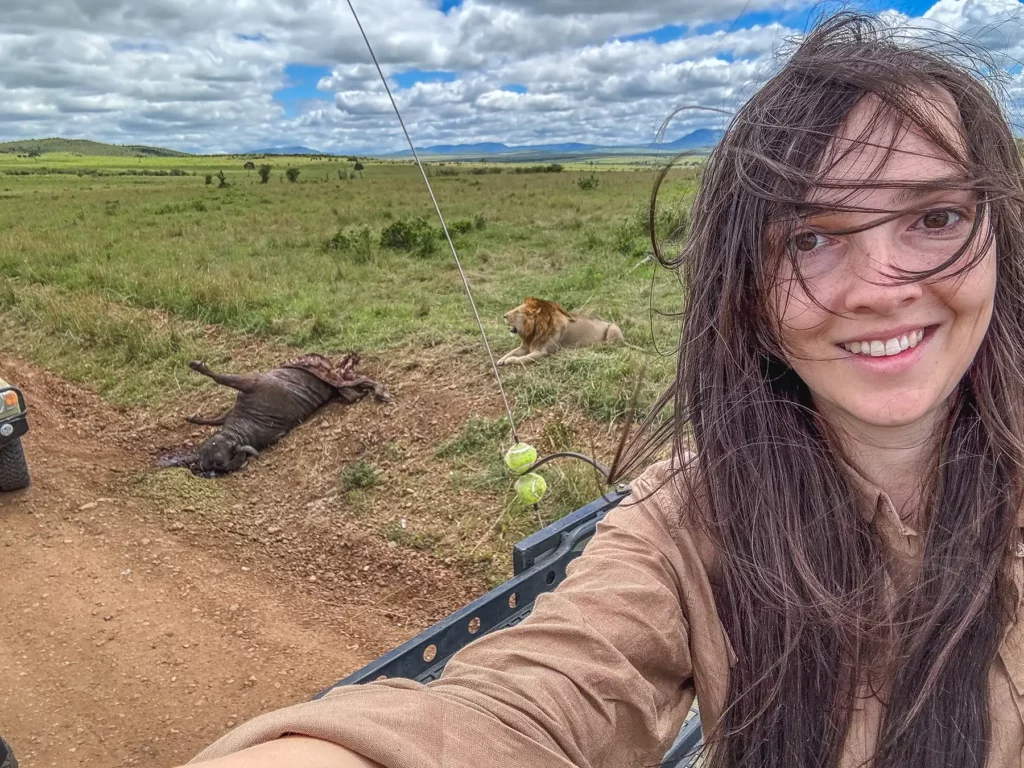
Visas
Visitors from the UK, Canada, Australia and several European countries require a single-entry visa to enter Tanzania. A single-entry visa costs $50 and can be obtained on arrival or by applying online in advance, which is recommended to avoid delays at the airport.
Visitors from the USA, however, need to purchase multi-entry visas. These cost $100 and can be purchased either online or upon arrival.
It’s advisable to apply a month or two before your trip as it takes several weeks to receive the approval.
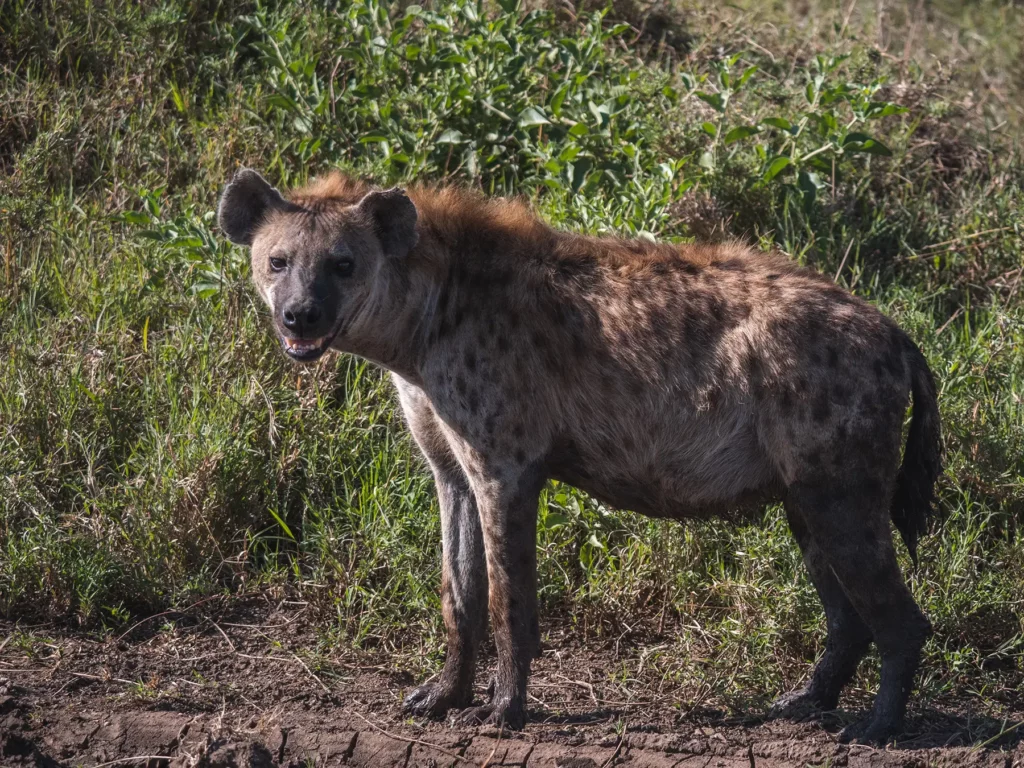
Vaccinations
Tanzania has a low risk of Yellow Fever and no vaccination certificate is required. However, if you’re crossing from Kenya, Uganda or another country which is a high-risk area, or have transited through an airport in a high-risk country, then a Yellow Fever certificate is required.
Although no other vaccinations are mandatory to enter Tanzania, you should view the list of vaccines that are recommended and check in with your doctor a few months before your trip.
Some vaccines your doctor may recommend are Hepatitis A & B, Diphtheria, Meningitis and Typhoid.
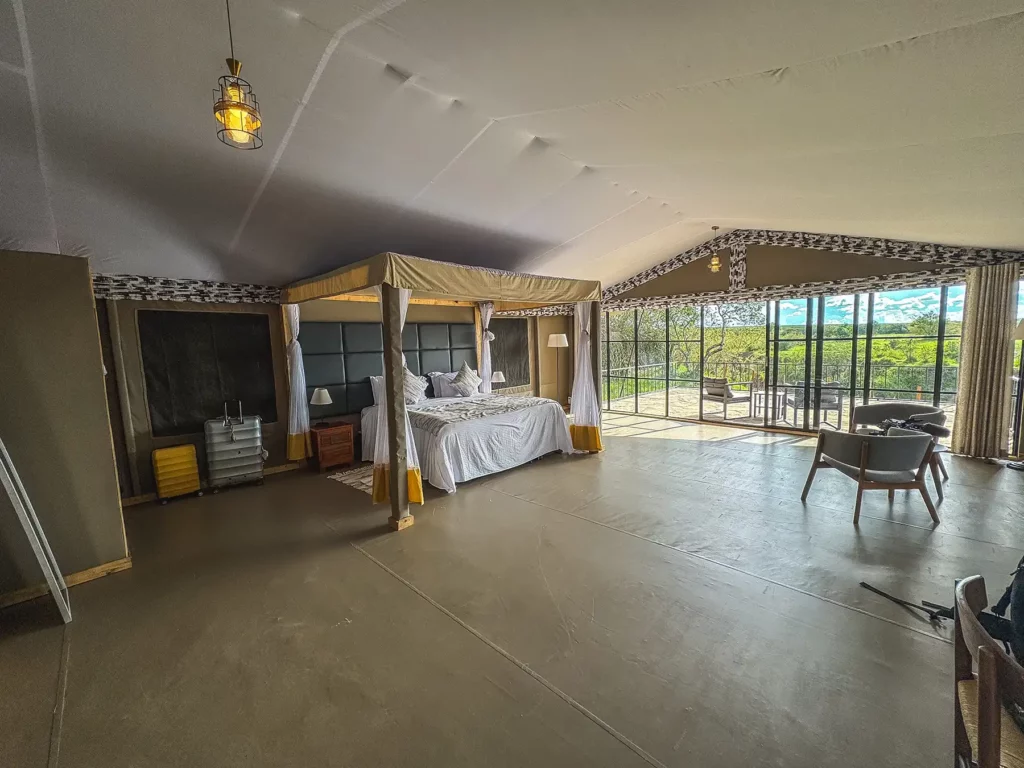
Medication
Tanzania is a high-risk area for malaria, particularly during the wet seasons, so precautions are necessary.
Firstly, check with your doctor or pharmacist which anti-malaria tablets are suitable for you, as side effects can vary. Besides medication, the best way to keep safe is to take a few easy precautions to avoid getting bitten – make sure you bring plenty of insect repellent and wear suitable clothing, especially at night.
You’ll also obviously need to bring any regular medication with you. Make sure you bring enough for the entire duration of your trip.
If you’re prone to travel and altitude sickness on flights or long road journeys, check with your pharmacy before travelling to see what they recommend.
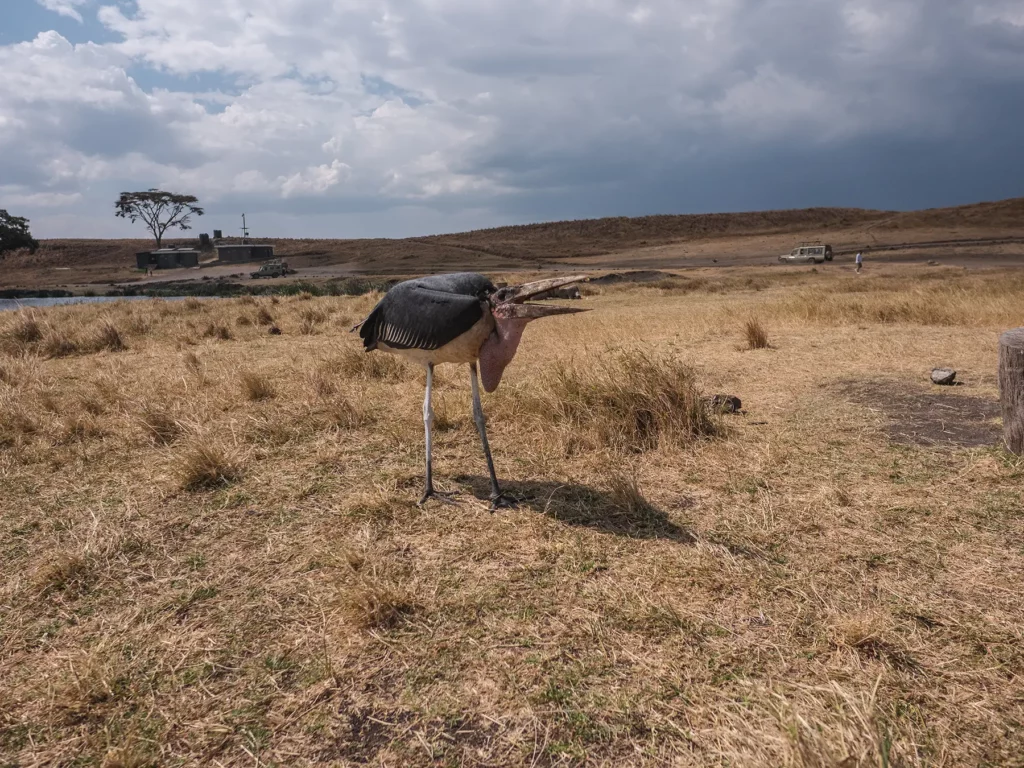
3-Week Tanzania Safari Overview
As Tanzania is such a vast country with so much amazing nature, wildlife, and culture to see, you’ll no doubt be keen to make the most of your time here! Especially considering how far you’ve come and the money spent.
So after multiple trips, and taking into account the advice of both locals and other tourists, I’ve carefully put together this three-week Tanzania itinerary.
Not only does this itinerary include a variety of the country’s highlights, hidden gems and best safari experiences, but I’ve also made sure to include some downtime.
After all, three weeks is a long time to travel across this vast country’s long roads, and you’ll need a little time to relax in between busy safari days to avoid burning out. (And with some of the world’s most beautiful beaches in Tanzania, you won’t regret taking some time to relax.)
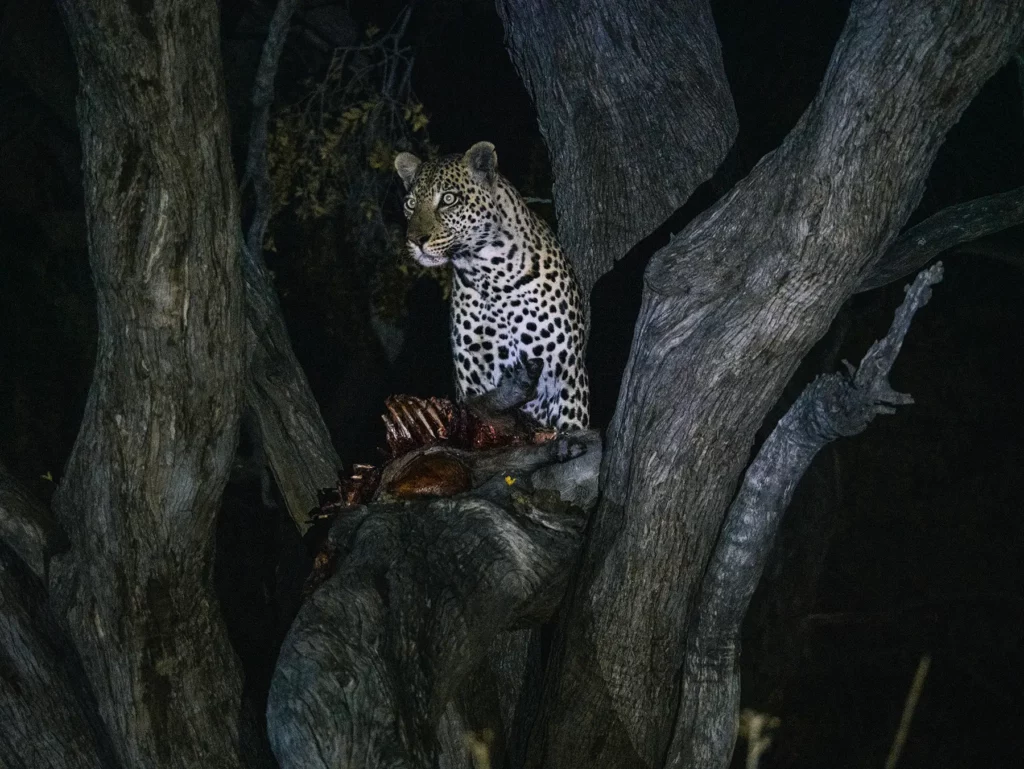
Day-by-Day Breakdown of the Ultimate 3-Week Tanzania Safari Itinerary
Here’s what you can expect to experience on what I can truly call my ultimate 3-week Tanzania safari itinerary.
Click any of the days below to jump to my full notes on that day.
- Day 1: Arusha
- Day 2: Tarangire National Park
- Day 3: Tarangire National Park
- Day 4: Lake Manyara National Park
- Day 5: Lake Natron
- Day 6: Hadzabe & Datoga Tribes
- Day 7: Ngorongoro Crater
- Day 8 – 10: Serengeti National Park
- Day 11: Ruaha National Park
- Day 12 – 13: Ruaha National Park
- Day 14: Ruaha and Nyerere National Park
- Day 15: Nyerere National Park
- Day 16: Dar Es Salaam
- Day 17: Zanzibar
- Day 18 – 21: Zanzibar

Day 1: Arusha
Total drive time: 1 hour 20 minutes from Kilimanjaro International Airport.
Depending on what time your flight arrives in Arusha (and how tired you feel after a long flight), you can spend today resting in your hotel or begin exploring some of the city’s nearby attractions.
To start your trip seamlessly, I’d recommend arranging for your tour operator to pick you up at the airport and take you to your first accommodation. Arranging taxis after arriving in a new city can always be a bit of a headache, so this is a nice, relaxed way to begin your holiday.
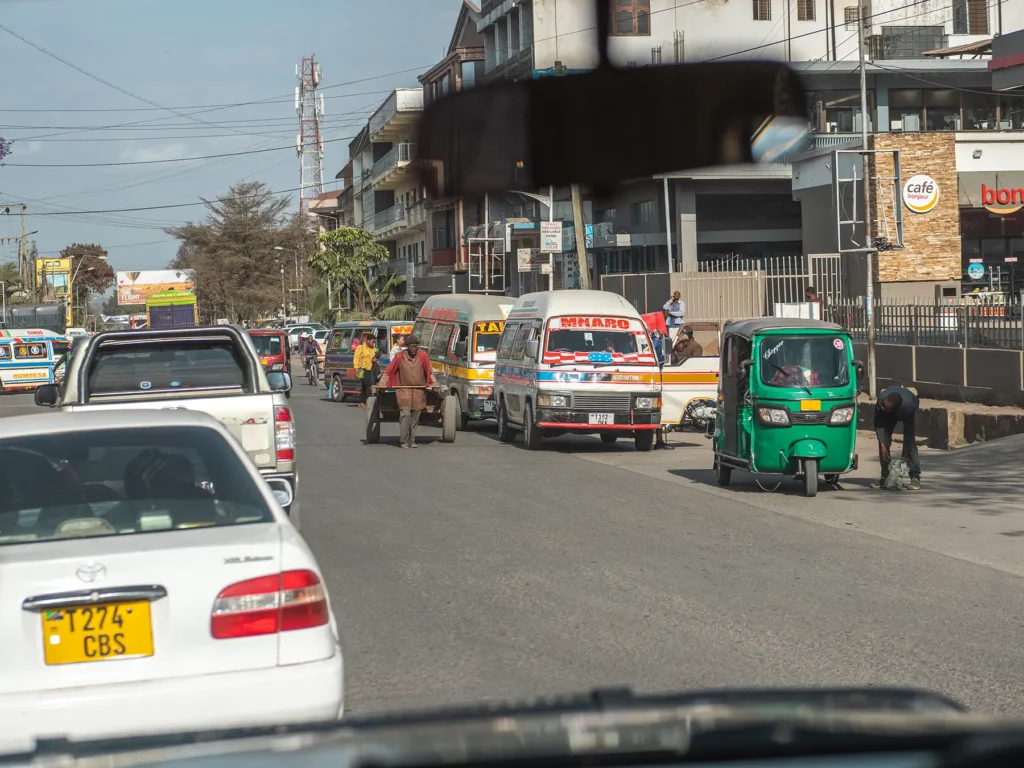
About Arusha
Situated on the foothills of Mount Meru, Arusha is Tanzania’s third-largest city.
It’s the perfect place to begin your Tanzania itinerary as it’s conveniently located close to many of the country’s best attractions, including Mount Kilimanjaro, the Serengeti, Ngorongoro, Tarangire and Lake Manyara.
Since Arusha has both an international and domestic airport, the city provides easy and quick access to these popular national parks and landmarks.
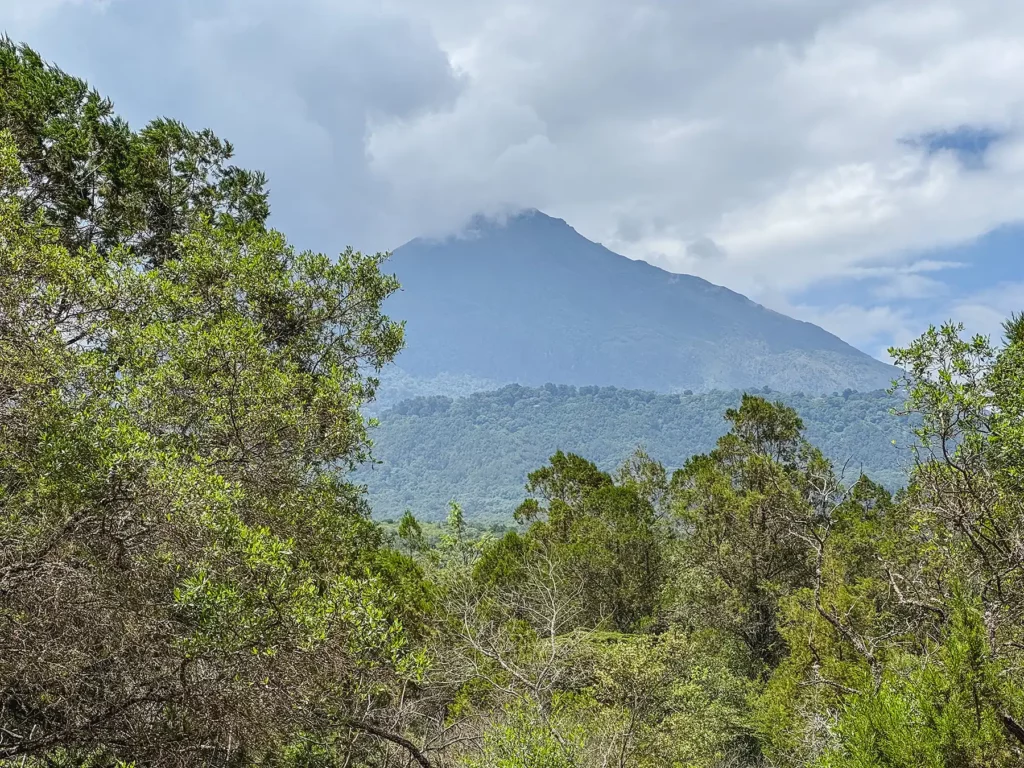
Things to Do in Arusha
Although most tourists don’t spend much time in the city before heading off on safari, Arusha itself is a nice, friendly place.
That said, it’s a bustling, multinational city that may feel a bit intense after a long flight, and getting around can feel pretty chaotic. I recommend taking a hotel-recommended taxi around if you’re easily flustered like me!
Here are a few things to do in Arusha to kick off your Tanzania holiday.
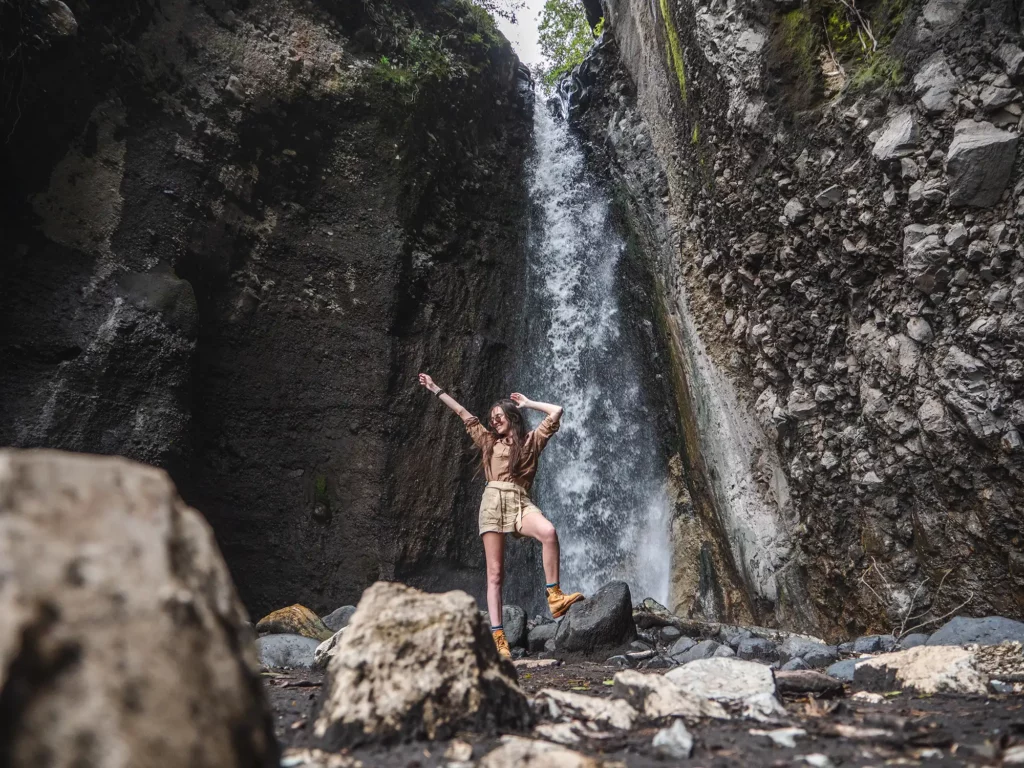
1. Arusha National Park
If you can’t wait to meet some of Tanzania’s wildlife, the open plains and hillsides of Arusha National Park are located just 25 km away.
You’re unlikely to see predators here, but elephants, buffaloes, zebras, hippos, warthogs and numerous buck species are common sights in this relatively small park. You can also spot colobus monkeys in the jungle canopies, and a wide selection of birds including flamingos around the alkaline and algae-rich Momella Lakes.
It also holds the largest concentration of giraffes in the world!
Due to the absence of big cats, walking safaris are relatively safe here. You’ll still be accompanied by an experienced armed ranger on your hike through the park, as any wild animal can be potentially dangerous.
As the park lies upon the slope of Mount Meru, Tanzania’s second-highest mountain, it goes without saying that natural beauty is plentiful here. Look out for the gorgeous Tululusia Falls, hike to the Ngurdoto Crater, and don’t miss driving through the famous Fig Tree Arch.
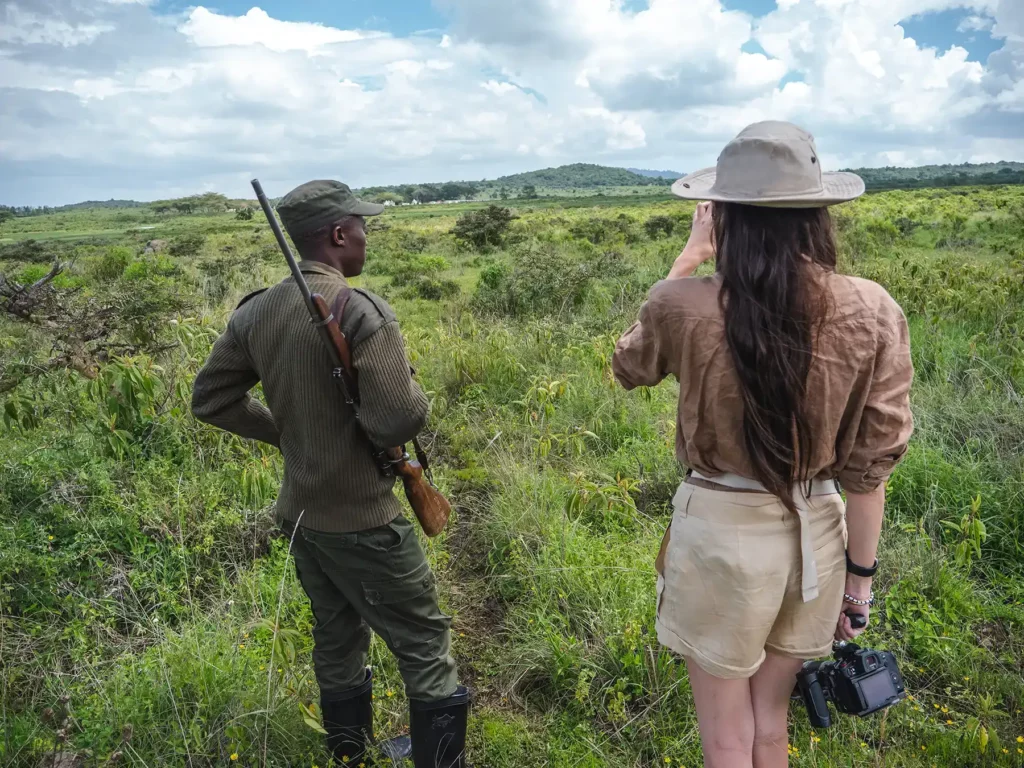
2. Local Markets
If you don’t have much time to spare, heading to Arusha’s local markets is a fun introduction to the local culture.
The markets here sell anything from barbequed goat meat to exquisite jewellery and everything in between. Just be prepared to haggle for whatever you want to buy – it’s a way of life here!
The Maasai Market in the city centre is the best place to shop for traditional colourful fabrics, beadwork and other Maasai cultural souvenirs. If you’re looking for stylish Tanzanite jewellery, the Tanzanian Experience in the Sheraton Complex or at the museum a short distance away are the places to go.
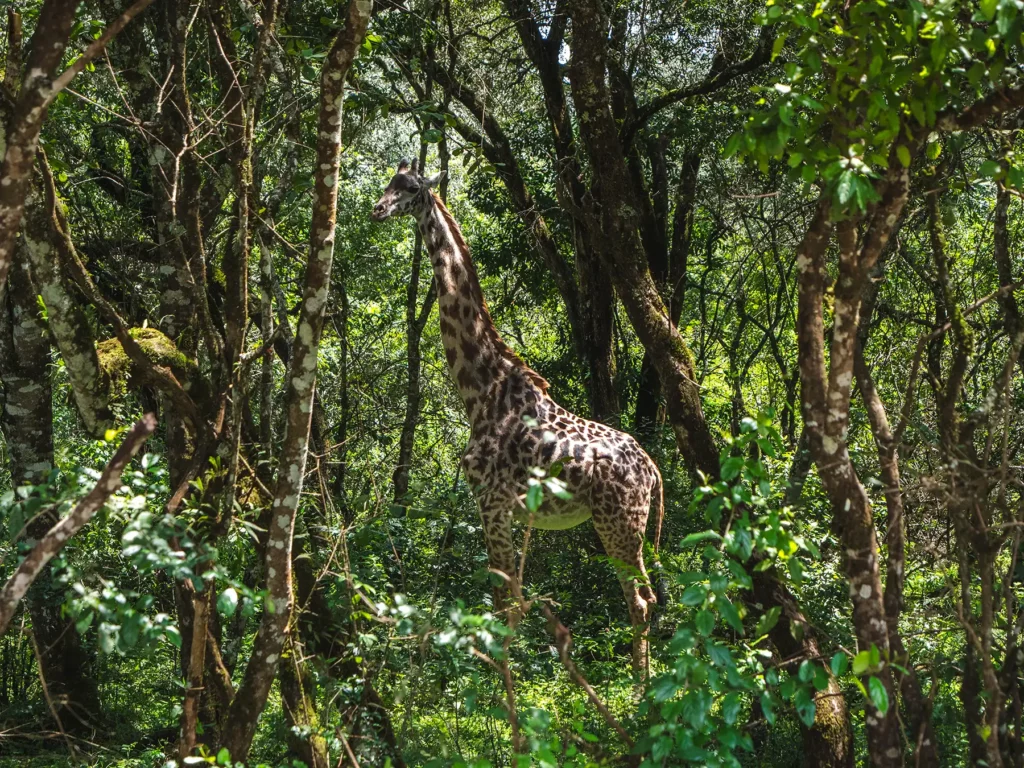
Alternatively, head to the Cultural Centre to see a wide selection of East African art and artefacts. You can purchase paintings, carvings and other cultural artworks and souvenirs here. The centre’s unusual shape is said to be inspired by Kilimanjara’s famous Uhuru Peak.
Meanwhile, the Shanga Gift Shop in the Arusha Coffee Lodge is an interesting spot to buy world-renowned glassworks, beadworks and fabrics. Located within a coffee plantation, they also offer highly informative and entertaining coffee tours through their plantation. Tasting their various blends is a perfect way to wake up after a long flight!
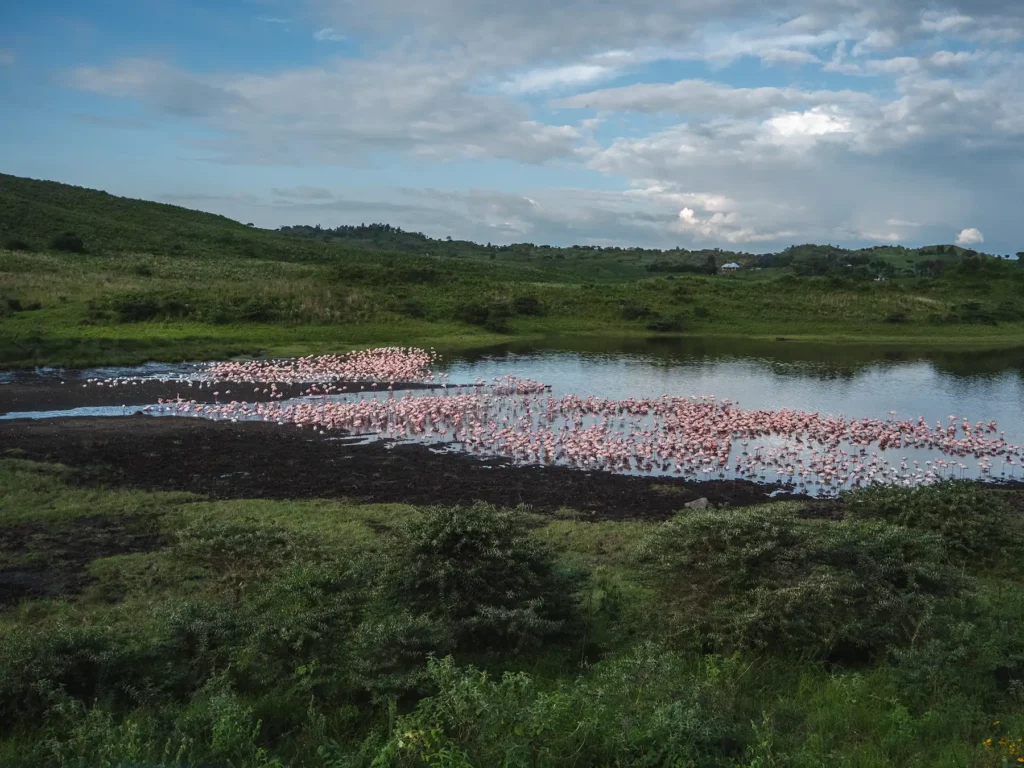
3. Chemka Hot Springs
If you fancy a unique day trip, Chemka Hot Springs is less than two hours away, located in the foothills of Mount Kilimanjaro.
Consisting of two unbelievably clear pools surrounded by a lush, tropical jungle, these springs are the perfect place to swim, float on a tube, or even snorkel. They have shallow areas which are great for small children, and the most daring will love taking a turn on the Tarzan swing over the water.
Chemka’s spring water is not actually hot, but it’s truly perfect for a cooling dip. And watch out for the tiny tilapia fish if you dangle your feet in the water! These massage fish have developed a taste for dead skin, so you can enjoy a free pedicure!
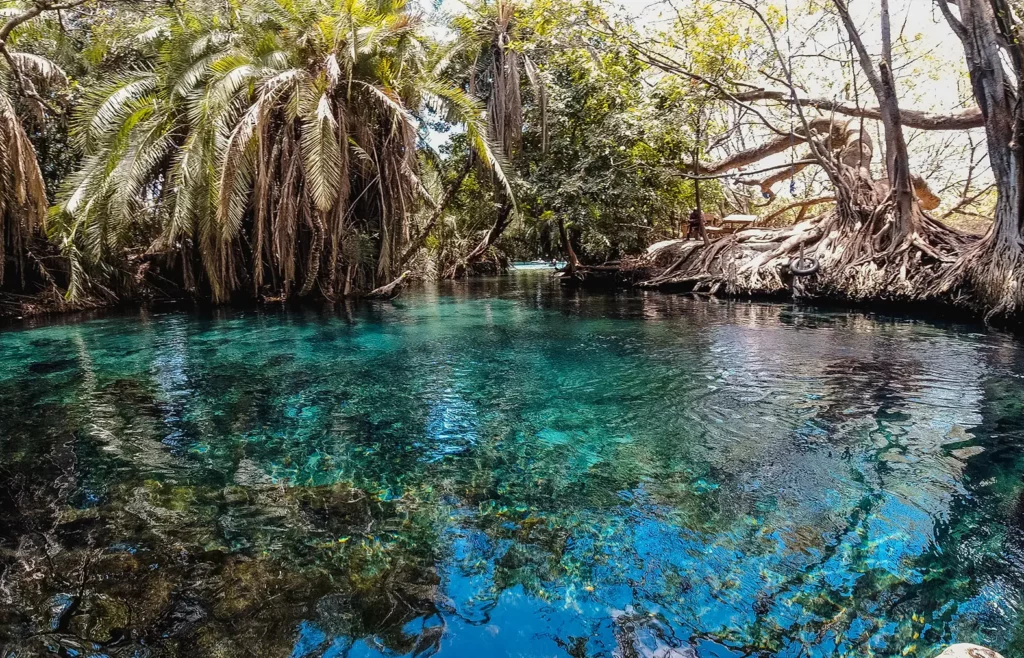
4. Eat at One of Arusha’s Delicious Restaurants
I don’t know about you, but I’m always in need of a good meal after a flight. Thankfully, Arusha has a bit of everything, from refined dining to burger and pizza joints.
Recently relocated to the edge of the city with fantastic views of Mount Kilimanjaro and Mount Meru, Blue Heron restaurant is the perfect welcome to Tanzania. Peaceful indoor and outdoor dining at its very best with a wide and varied menu with a somewhat Italian flavour, which includes steaks, seafood, salads, shawarmas and of course, pizzas to die for.
For Chinese/Asian cuisine, the Chinese Whispers is another popular restaurant that has become known for its sumptuous food and good service. Some say it’s the best Chinese restaurant in East Africa.
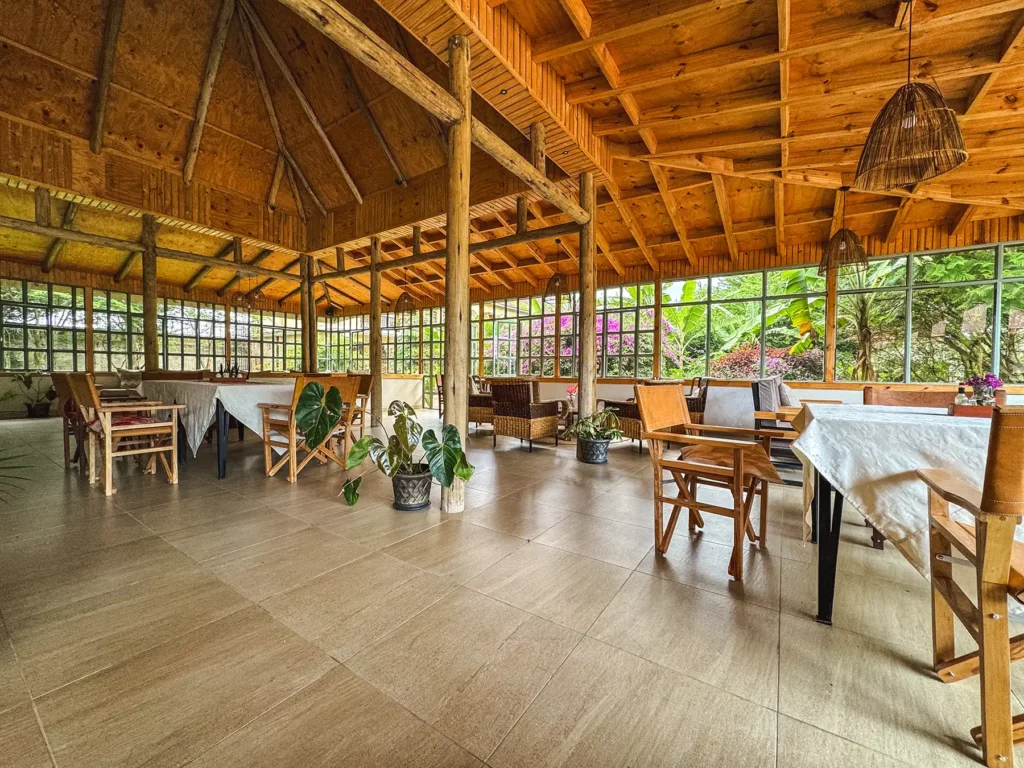
Centrally situated in the Njiro Mall in Njiro Street, it has a great ambience, a varied menu, great cocktails, generous portions, and friendly staff and is owned by a local who owns another Chinese restaurant in Nairobi. Don’t take my word for it, check them out for yourselves.
If you want to kick off your Tanzania adventure with a romantic and superb fine-dining experience, look no further than the serene ambience of the Onsea House at the Machweo Wellness Retreat.
Situated on the outskirts of Arusha, away from the noise of the city, Onsea House also offers spectacular mountain scenery including Mount Meru, Tanzania’s second-highest peak. Their cuisine is a fusion of sophisticated European and African dishes you would expect to find in a Michelin Star restaurant in the heart of Europe. Possibly, it’s one of the most tranquil and magnificent settings found anywhere in Tanzania.
Tips for Visiting Arusha
As with all big cities, be cautious, and always guard your wallet, passport and valuables.
It’s also worth being wary of anyone who approaches you offering to be your guide and show you around the city. If you stand out as a foreigner, you may also need to haggle a bit harder at the markets!
Some parts of Tanzania are predominantly Muslim and both men and women may dress more conservatively than you’re used to at home.
If you’re not sure how to dress respectfully, a rule of thumb is to wear comfy, loose clothing. For example, t-shirts that cover your shoulders and skirts or shorts that cover your knees when visiting the markets.
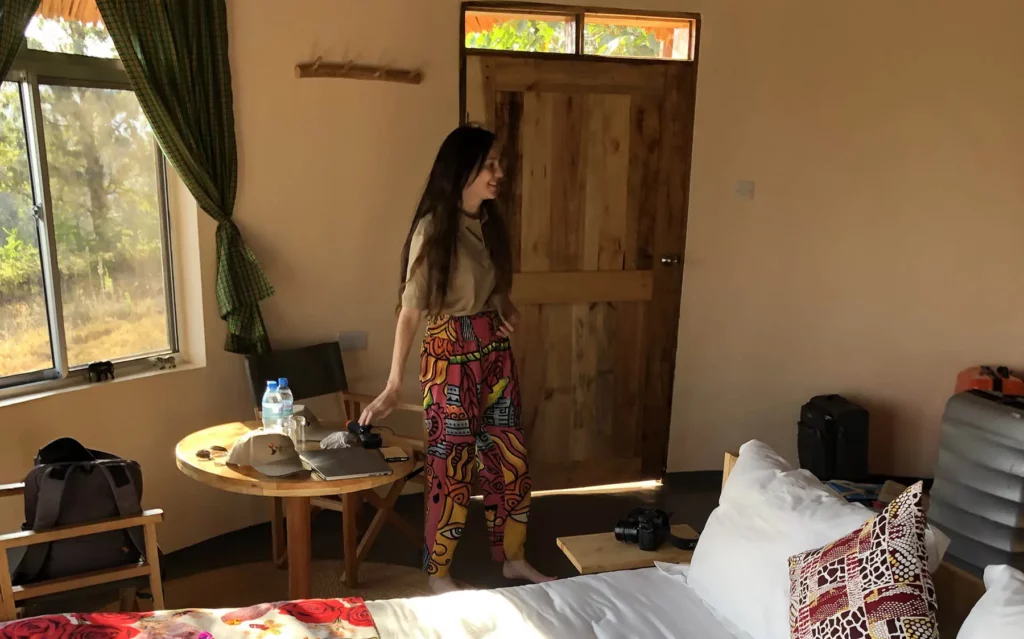
Where to Spend the Night
As Arusha is well-known as the gateway to the northern Tanzania safari circuit, there is a wide selection of accommodation options here, including reasonably priced Airbnbs, hotels, and guesthouses. If you booked through a travel agent or tour operator, then this was likely selected for you in advance.
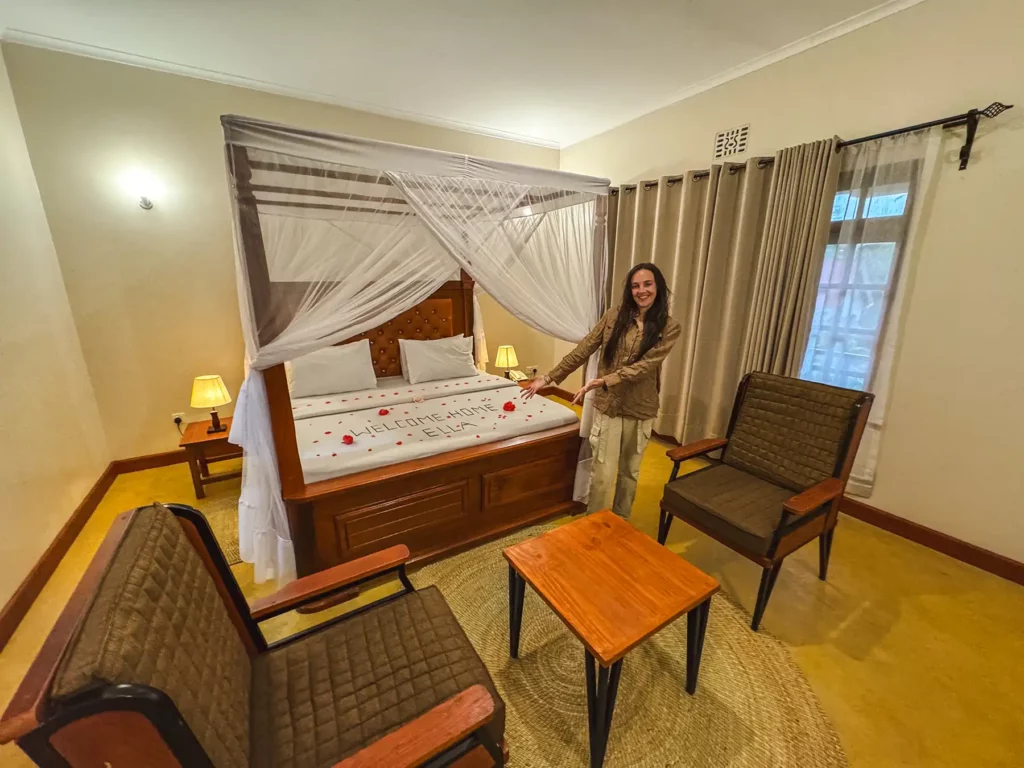
My Experience Visiting Arusha
I felt safe during my time here and particularly enjoyed visiting Arusha National Park and Chemka Hot Springs, so I definitely recommend both of these if you have time!
The only downside is you can experience some hassle on Arusha’s streets, so if you do choose to walk around the city, walk with purpose and work out your route in advance to avoid getting hassled. And don’t accept tours from people who approach you on the street as these are never the best rates.
You can watch a video of my experience visiting Arusha National Park below.
Day 2: Tarangire National Park
Total drive time (excluding game drives): Approximately 3 hours
Today, your safari adventure begins as you make your way to Tarangire, one of Tanzania’s premier national parks! Tarangire has four of Africa’s Big Five and is home to some of the largest herds of elephants found anywhere on the continent.
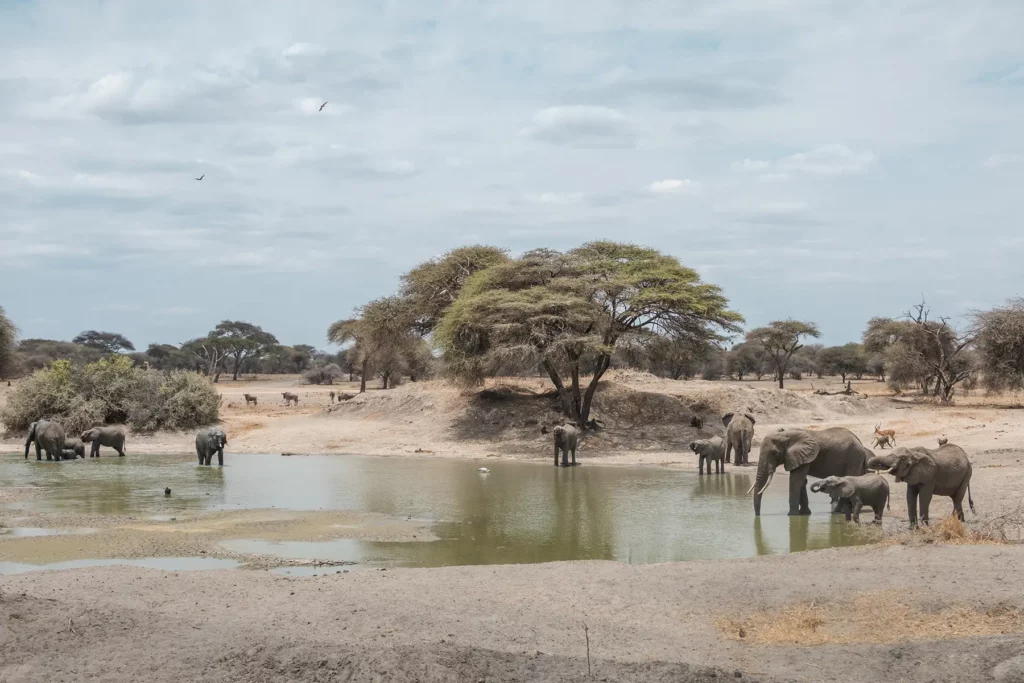
Itinerary
Leave Arusha early and spend your morning on the three-hour drive to Tarangire.
Once you arrive, you have a chance to go on your first game drive through Tarangire National Park. After you enter the park gates, it likely won’t take long before you have your first wildlife sighting!
Some of the best viewing sites are along the Tarangire River, which flows northwards through almost the entire length of the park. During the dry season, the river banks are teaming with wildlife and you stand a good chance of observing many species here, including some predators.
You’ll spend the evening relaxing at your lodge just outside the park.
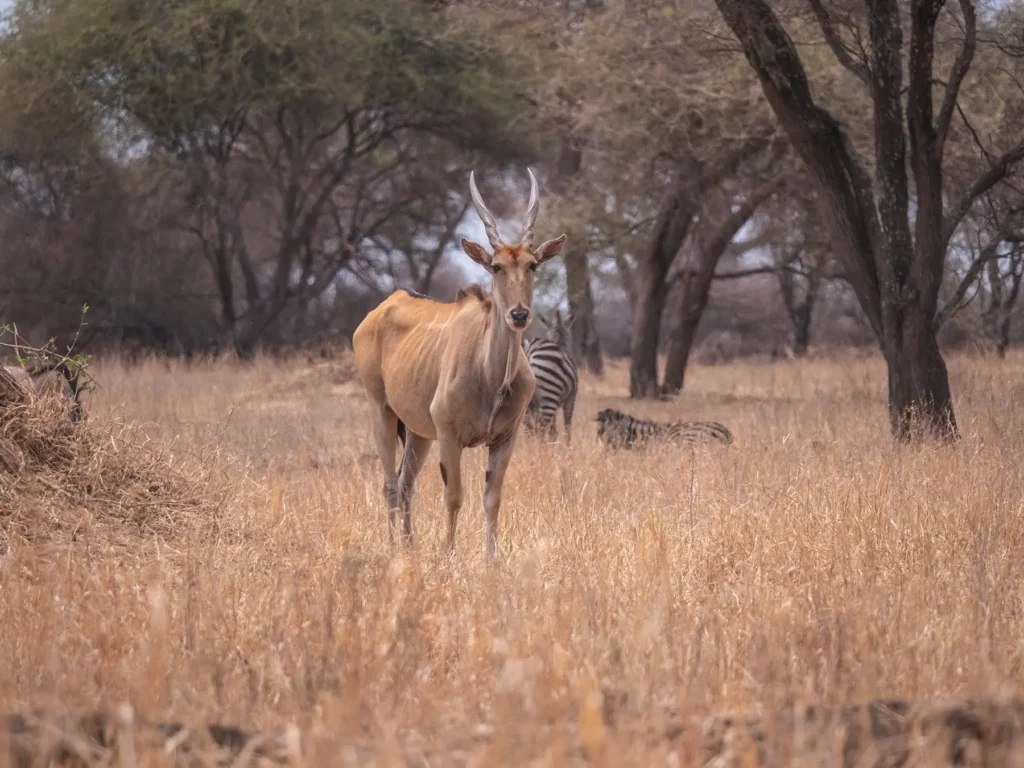
About Tarangire National Park
As well as having over 4,000 elephants, with some herds being over 300 strong, Tarangire National Park is also home to lions, leopards, cheetahs, buffaloes, giraffes, zebras, baboons and vervet monkeys, wildebeest, eland and many other antelope species including the rare fringe-eared Oryx.
Unlike other antelopes, fringe-eared oryx give birth during the long dry season and are usually found in small herds up to about 30 in number. Another unique characteristic is that when they’re on the move, they travel in an orderly single file fashion! Keep your eyes peeled for these unique and rare creatures – they’re not easy to spot.
As for predators, you’re likely to see hyenas lions and, if you’re lucky, a leopard lazing in a tree.
Meanwhile, hippos and crocodiles convene in the lakes, marshes and river banks, along with over 500 species of birds.
The landscape of Tarangire is vastly different to the other parks you’ll be visiting because it has a drier climate. The park has an abundance of giant and distinctive Baobab trees, some of which grow to over 100 metres tall, tall green grasses, granite rock formations, and red soils.
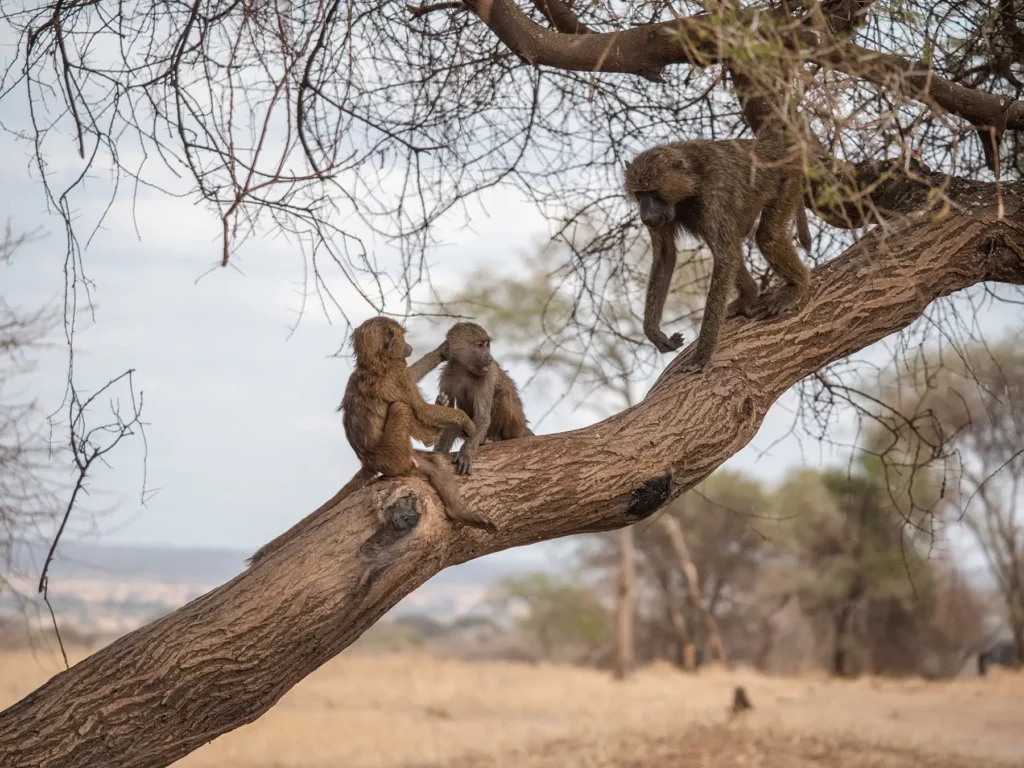
Tips for Visiting Tarangire National Park
As with almost all parks in Tanzania, take plenty of water on game drives as it gets pretty warm during the day, even in winter. Bug spray and sunscreen are also a must. Mozzies are a constant threat, so it’s best to dress in long trousers and long-sleeve tops.
As some lodges and camps are unfenced, be wary of walking or letting small children wander around your camp after dark – animals sometimes like to wander around them too!
Tipping guides is customary in Tanzania – I recommend around $10-$15 per person per day. However, I always recommend tipping at the very end of your safari rather than after the end of each day.
Where to Spend the Night
There are various lodges within or just outside the park, from luxurious options to basic tents. Choosing a lodge inside the parks cuts down on driving time, but these tend to be more costly.
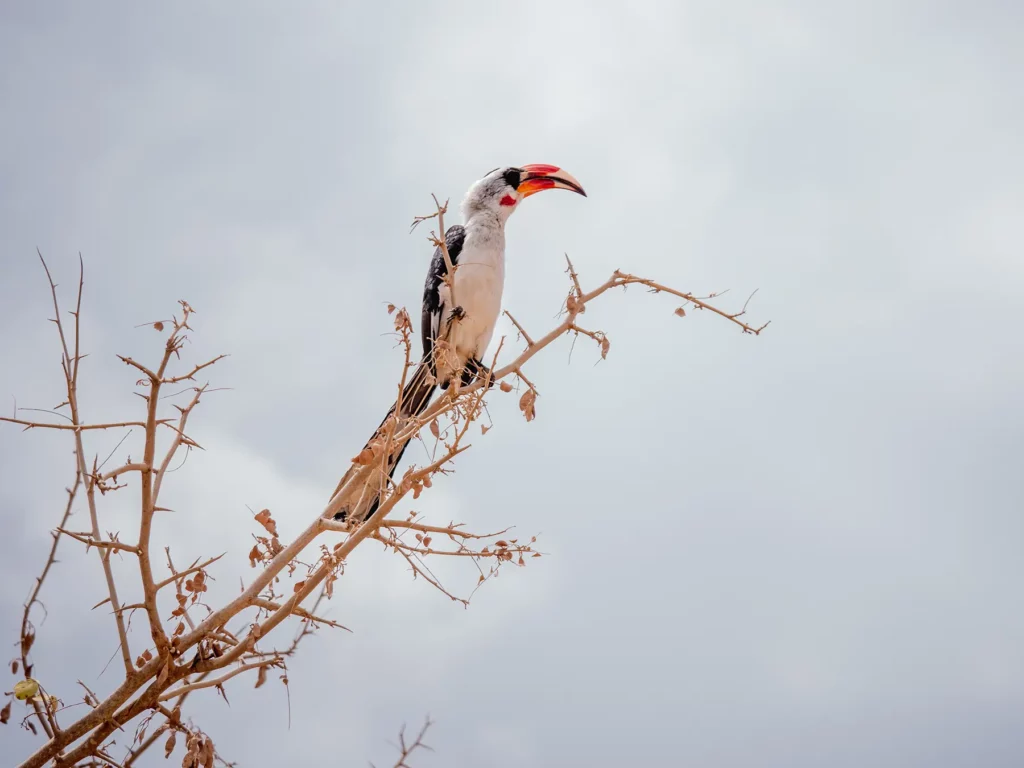
My Experience Visiting Tarangire National Park
With its long yellow grass and towering baobab trees, I thought Tarangire National Park was beautiful.
I saw tons of animals here, including buffalos, elands (the largest antelope in Africa), helmeted guinea fowl, zebras, and ostriches. During my scenic picnic lunch, I had to keep my eye on cheeky velvet monkeys who were looking for scraps.
Some of my best sightings were at the waterholes, where I saw a herd of elephants drinking, including the sweetest baby elephant rolling around in the water joyfully. Wildebeest and zebras drank here too.
I also saw a whole troop of baboons with their playful youngsters hanging out at the waterholes with impalas – two species who interestingly enjoy hanging out together! There were quite a few bird species here too, including saddle-billed storks and yellow-billed storks.
Another of my favourite sightings was of some lions lying down in the tall grasses beyond the river, and watching two elephant herds greet each other by raising their tusks and begin feeding together. This was magical!
You can watch a video of my experience visiting Tarangire National Park below.
Day 3: Tarangire National Park
Total drive time (excluding game drives): 1 hour.
Today, you’ll be spending a second night in Tarangire, so you’ll spend the full day enjoying a game drive.
Since Tarangire covers a huge 2,850 square kilometres and hosts a quarter of a million animals, you’ll definitely need another full day to make the most of this step!
Itinerary
Start your day early, ideally before sunrise. Getting to the park first thing will massively increase your chances of seeing predators; they tend to be more active in the early morning when the weather is cooler.
Your lodge will be able to arrange a picnic lunch, and there are plenty of picturesque spots to eat. The pretty Matete Picnic Site overlooking the river is a favourite.
In the afternoon, you’ll make your way towards the saline swamps of Lake Burunge, a favourite hangout for thousands of pink flamingos.
Finally, you’ll finish your day driving around Lake Manyara towards Mto Wa Mbu village. The farming community here has representatives from 120 tribes and a village walk is a great way to learn about Tanzanian traditions
Where to Spend the Night
Spend the night in Mto Wa Mbu Village, a truly photogenic area surrounded by coffee and banana plantations. The area has plenty of lodges dotted about, from luxury to basic.
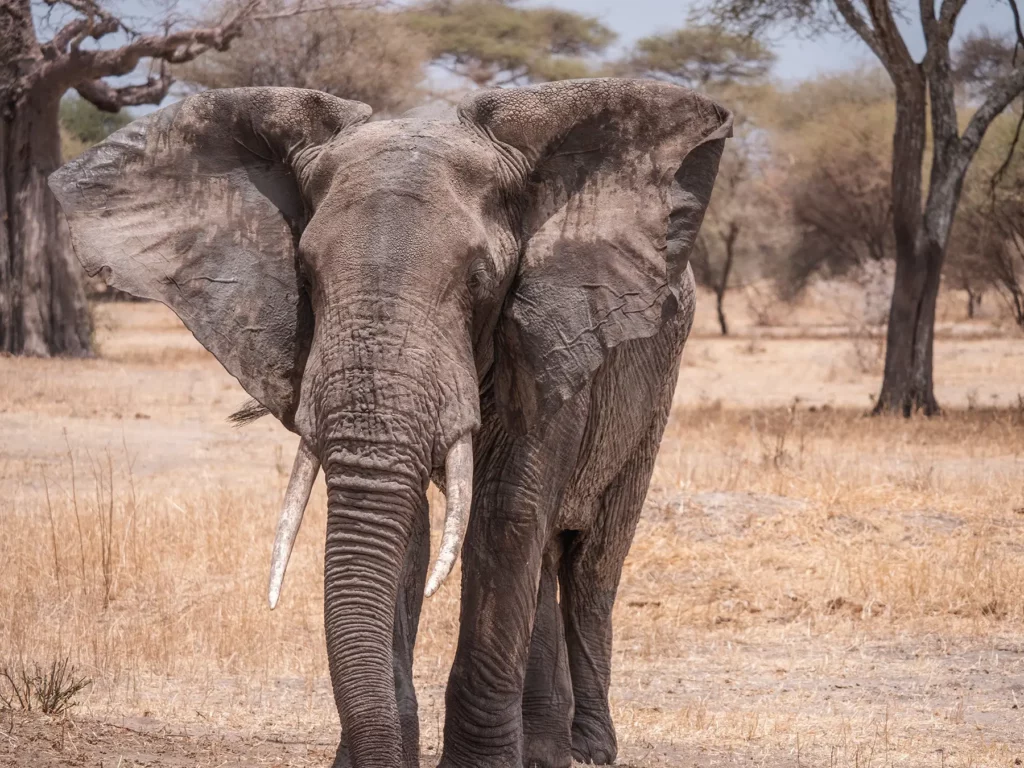
Day 4: Lake Manyara National Park
Total drive time (excluding game drives): 2 hours
Lake Manyara National Park lies next door to Mto Wa Mbu, where you’ve just spent the night, so you can get stuck into more game drives today!
Itinerary
Setting off early, you’ll enter Lake Manyara National Park for a full-day game drive. During the morning, you’ll likely stay close to the lake which is a favourite gathering spot for many animals.
After a picnic lunch, potentially at the crystal clear Maji Moto Springs, you’ll pass through open grassy floodplains. This is where many antelope, waterbuck and zebras like to graze – and cats like to hunt! You’ll also enter into some lush dense woodlands to hopefully spot large numbers of elephants feeding on the evergreen foliage.
Finally, end your day heading towards Lake Natron, which has the notorious nickname of the Deadliest Lake in the World. Sounds like a good place to spend the night… right?
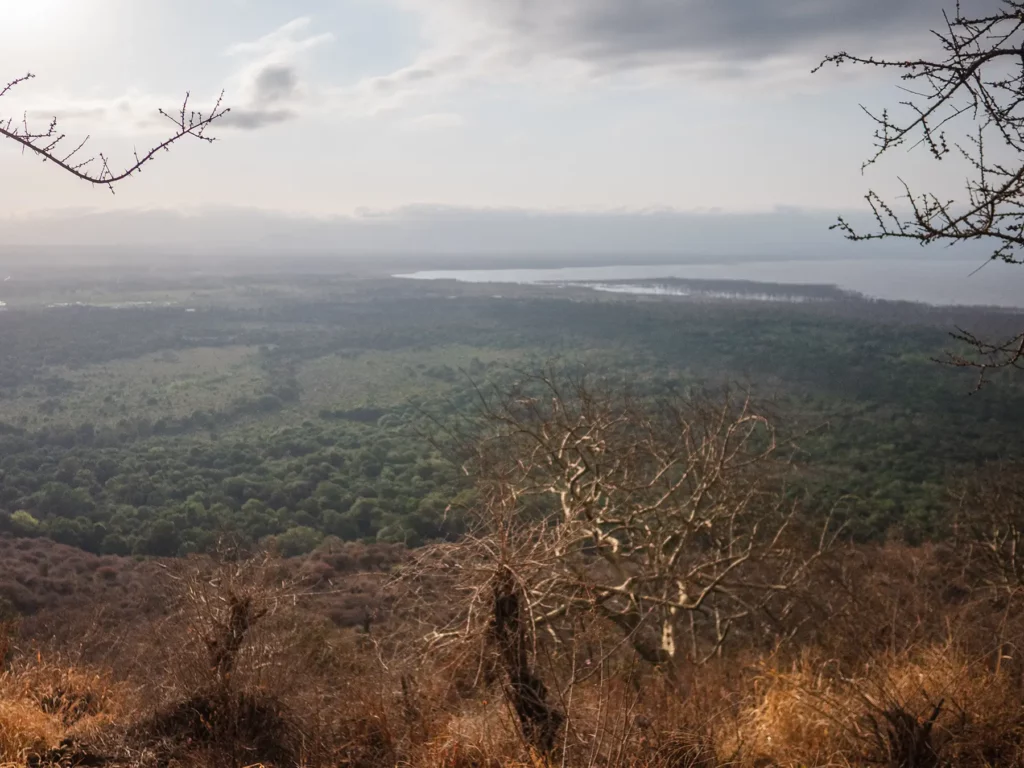
About Lake Manyara National Park
Lake Manyara National Park is a rather small park totalling 330 square kilometres with two-thirds of it being taken up by the lake.
Animals to look out for include elephants, cheetahs, giraffes, zebras, buffaloes, wildebeest, impalas, baboons and tons of waterbuck and other antelope species. Its big stars, however, are its pride of tree-climbing lions. Lake Manyara is one of the only places you can see them.
The lake and shoreline are teeming with hippos, pelicans, flamingos and countless water bird species. If you want a unique perspective of the hippos, ask your operator about canoe safaris, as you can often get closer to them in the water!
While the park is picturesque all year round, the dry season is best for wildlife viewing, while the rainy season turns the landscape into a beautiful, vibrant green.
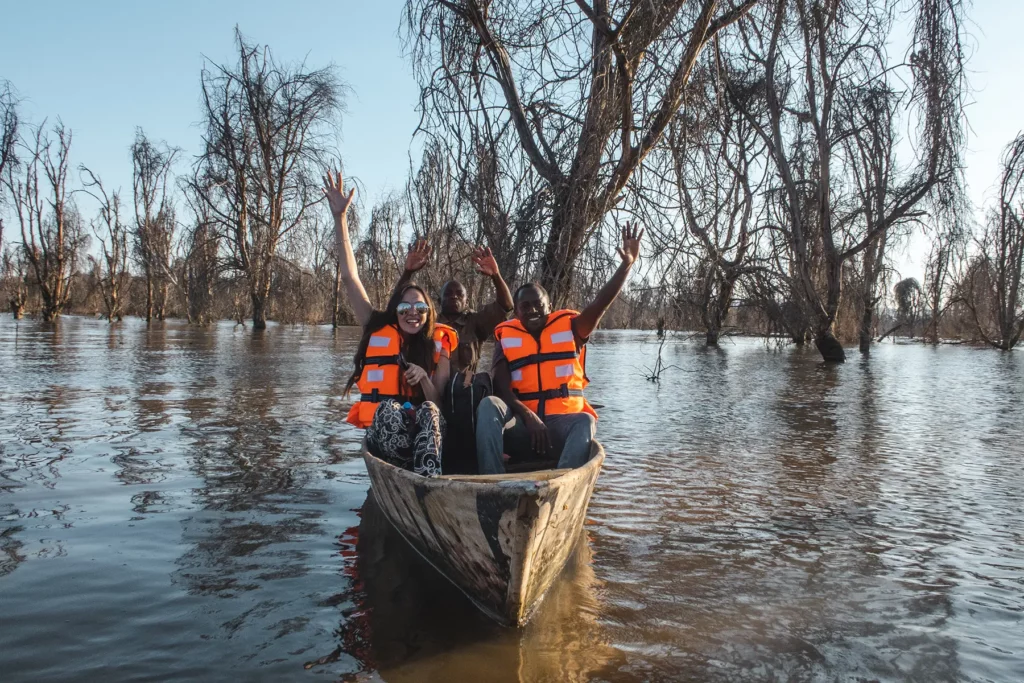
Tips for Visiting Lake Manyara National Park
Lake Manyara has suffered quite a lot in recent years due to flooding. This has shrunk the park and forced some of its inhabitants to go elsewhere. Therefore, the park isn’t as magical as it once was. However, it’s still a haven for birds and the topography is different to other parks, making it a unique place to visit.
Don’t feel disappointed if you don’t spot any tree-climbing lions here as you’ll have another opportunity to view them later on in this itinerary, in the world-famous Serengeti National Park.
Where to Spend the Night
You’ll be spending the night at Lake Natron. Since Lake Natron is a two-hour drive from Lake Manyara, you’ll likely just want to eat and sleep once you arrive.
There are only a few lodges and tented camps on its southern shores, so make sure this is booked early during the high season.
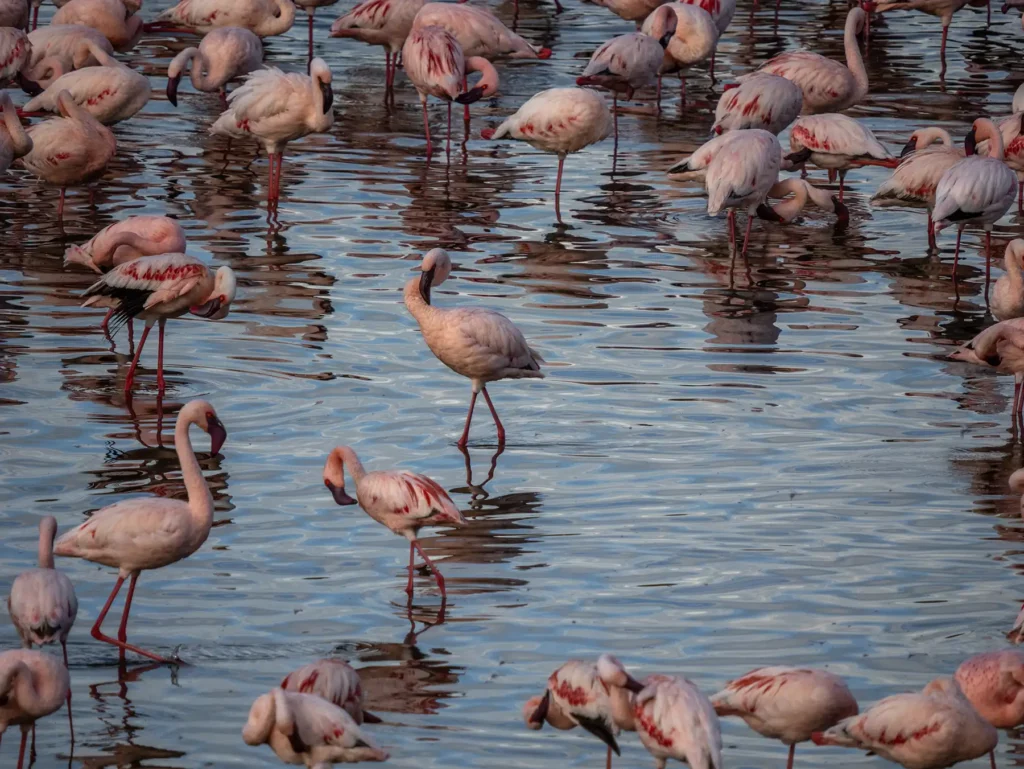
My Experience Visiting Lake Manyara National Park
You can watch a video of my experience visiting Lake Manyara National Park below.
Day 5: Lake Natron
Total drive time (excluding game drives): 3-4 hours (Lake Natron to Lake Eyasi)
Today you’ll wake up early and explore Lake Natron during the day. You’ll leave late afternoon for the 3-4 hour drive to Lake Eyasi, where you’ll spend the night.
Itinerary
Although Lake Natron is a fascinating place with tons of activities, swimming isn’t one of them. In fact, don’t even dip your finger into this water.
Why? Because Lake Natron’s waters are hot and highly alkaline! The waters are partly fed by mineral-rich volcanic springs and contain certain salt-loving microorganisms, which are pink or red. This is what gives the lake its reddish otherworldly appearance! So at least it’s as beautiful as it is deadly.
The vivid colour varies depending on the ever-changing levels of salinity (saltiness) and evaporation but is beautiful to view from its shores all year around. Enjoy capturing some eerie Martian-like images of the vibrant lake!
Behind the lake’s southern shores, the imposing Ol Doinyo Lengai is an active volcano that still spews white lava when it erupts. This lava is the culprit for causing the lake’s high levels of Natron and its deadly effects.
Popular activities include short hikes around the lake and viewing the flamingo colonies and other birdlife. While here, you can also visit the 120,000-year-old Hominid Footprints, which are fascinatingly well-preserved footprints left by our early ancestors! The 600-metre Ngaro Sero Gorge and its waterfalls are also just moments away from Lake Natron.
Alternatively, you could visit a Maasai village, and meet some of their fearsome warriors and brightly clothed women, while also learning about their customs and culture.
After you’ve explored Lake Natron, In the afternoon you’ll set off for Lake Eyasi. This 170km drive usually takes around 3-4 hours.
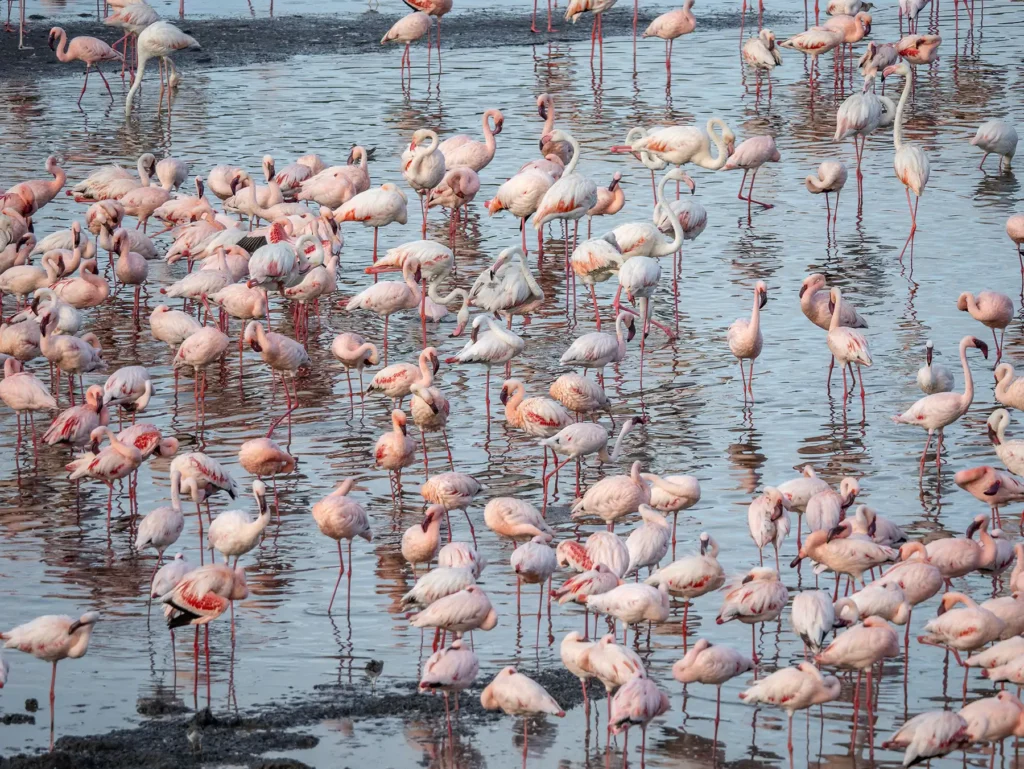
About Lake Natron
Lake Natron is massive. Depending on the rainfall, the lake can reach up to 60 km in length and stretch into Kenya!
The lake is named after Natron, a highly caustic mineral that is found in high levels within the water. This mineral is so corrosive that if any unsuspecting bird flies into the lake, it will die before it sinks to the bottom and is instantly calcified turning into stone. Ouch! (See what I meant about not even dipping your finger in?)
As a result, the lake’s shores are often littered with mummified bird corpses, which feel truly spooky. Incidentally, Natron was used by the ancient Egyptians in their mummifying processes.
Despite its toxic waters, there is still wildlife here. Lake Natron is the breeding ground for huge colonies of flamingos. Phenomenally, these birds have built up a tolerance to the water, and a layer of scales on their legs protects them.
The lake’s toxic waters also detract predators, so it’s a relatively safe place to raise their chicks. During the dry season, flamingos flock to the islands formed in the middle, fully protected.
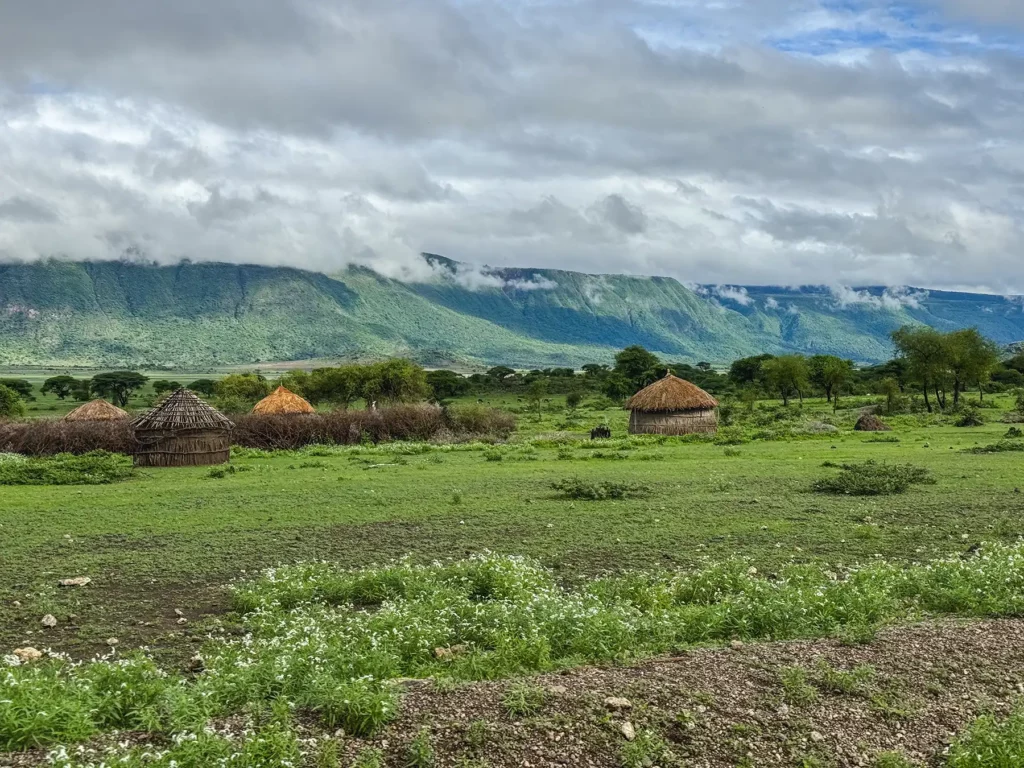
Tips for Visiting Lake Natron
Weather-wise, it’s best to visit Lake Natron during the so-called winter months of June-August. These months are still pretty warm, but tolerable. The summer months can be extremely hot, though December to January is ideal to witness the hatchings of millions of baby flamingos if you can handle the heat.
It is also worth noting that Lake Natron is located in a very remote area, far from any services or facilities should you have an emergency, so make sure you take any necessities with you.
Where to Spend the Night
After arriving at Lake Eyasi, you can find several lodges around this area, most of which are located in the northeastern section. These provide easy access to Lake Eyasi and nearby cultural sites and activities.
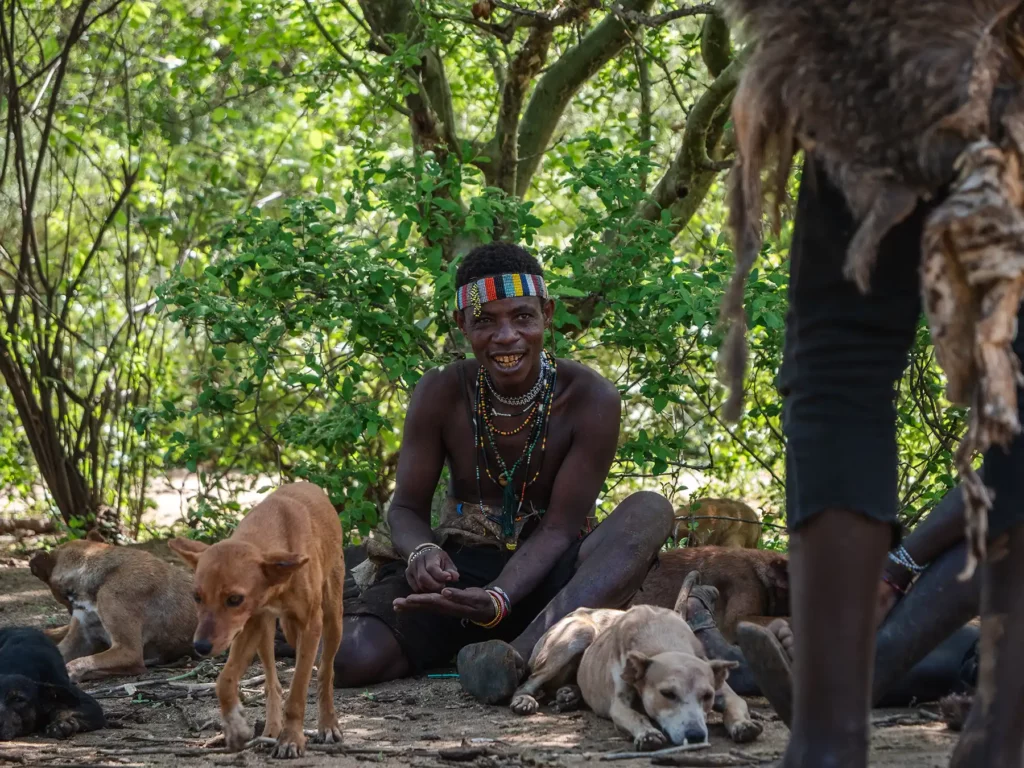
Day 6: Hadzabe and Datoga Tribes
Total drive time (excluding game drives): 30-60 minutes to the tribal villages and 1 hour to Karatu
After waking up at Lake Eyasi, you’ll step back in time to the Stone Age as today you’ll get to spend a few hours with the Hadzabe and Datoga tribes, whose ancestors have inhabited this area for thousands of years.
Thankfully, the tribes are close by, so you won’t have too much driving, besides your hour journey to Karatu at the end of the day.

Itinerary
Start your day very early by joining the Hadzabe tribe hunters on their daily hunt. They hunt with bow and arrow only and target small animals, such as impalas and birds, which they take back to the village.
If their hunt is successful, you may be invited to share some barbequed free-range meat or a few pulls on their tobacco pipes. (Of course, you are free to politely decline the offer if you prefer.)
While here, you can learn how they light fires by rubbing sticks and how they use a bow and arrow, alongside other survival skills such as game tracking and tree climbing techniques.
If you’re not up to that, you could join the women on their daily forage collecting fruit, and berries and digging for tubers (a nutritious part of the plant, such as stems or roots). Finally, you’ll likely finish off with a traditional song and dance.
In the afternoon, it’s time to stop by a Dotoga village. Here, you can learn of their ancient blacksmith skills, such as melting iron, aluminium or copper to make arrowheads, knives and spears, as well as bracelets, rings and other jewellery.
Finally, in the late afternoon, you’ll drive to Karatu.
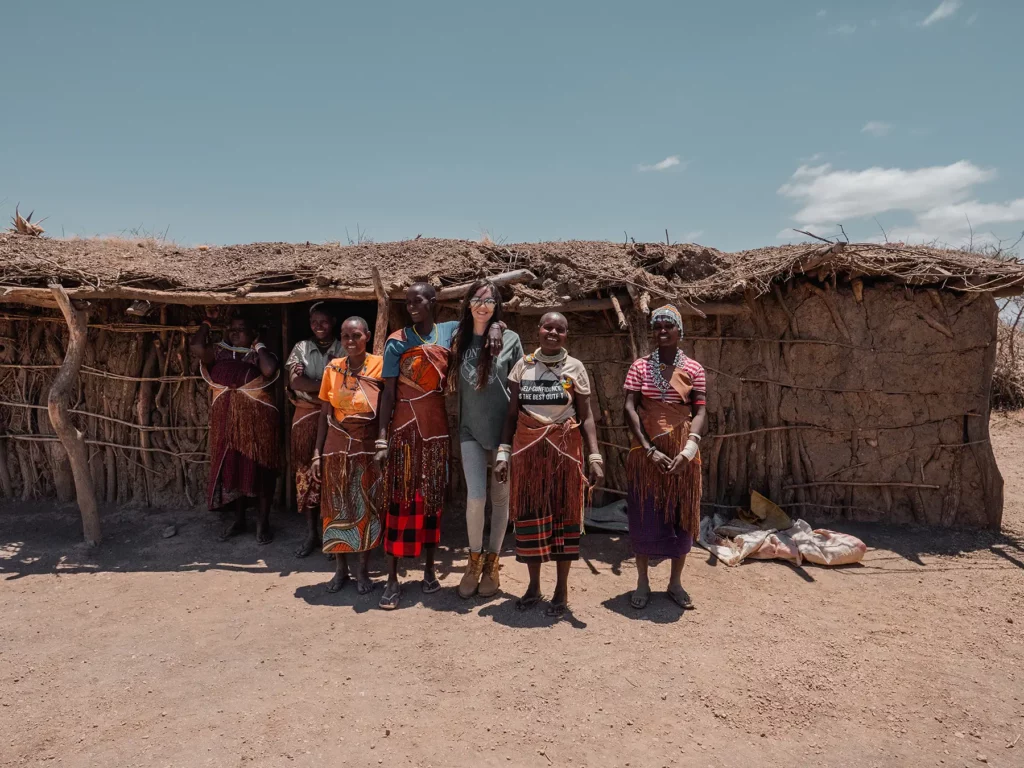
About the Hadzabe and Datoga Tribes
The Hadzabe are one of Africa’s earliest tribes and among the last remaining hunter-gatherers on our planet. They choose to continue a nomadic existence and live entirely off the land.
Armed with only bows and arrows, the men hunt small animals and birds, while the women forage for berries, fruit and honey, which are all shared with the entire clan at the end of the day. They do not keep livestock or plant crops, spending their lives roaming around the shores of Lake Eyasi, taking only what they need for the day and carrying everything they own wherever they go.
The Datoga are known for their metal forging skills and are also efficient farmers. They cultivate numerous crops like maize, onions, beans, and other produce. Despite their seemingly difficult lifestyles, both tribes are extremely content, and friendly, and are always willing to share their skills with visitors.
Spending the day with these people is so educational, entertaining and exciting.
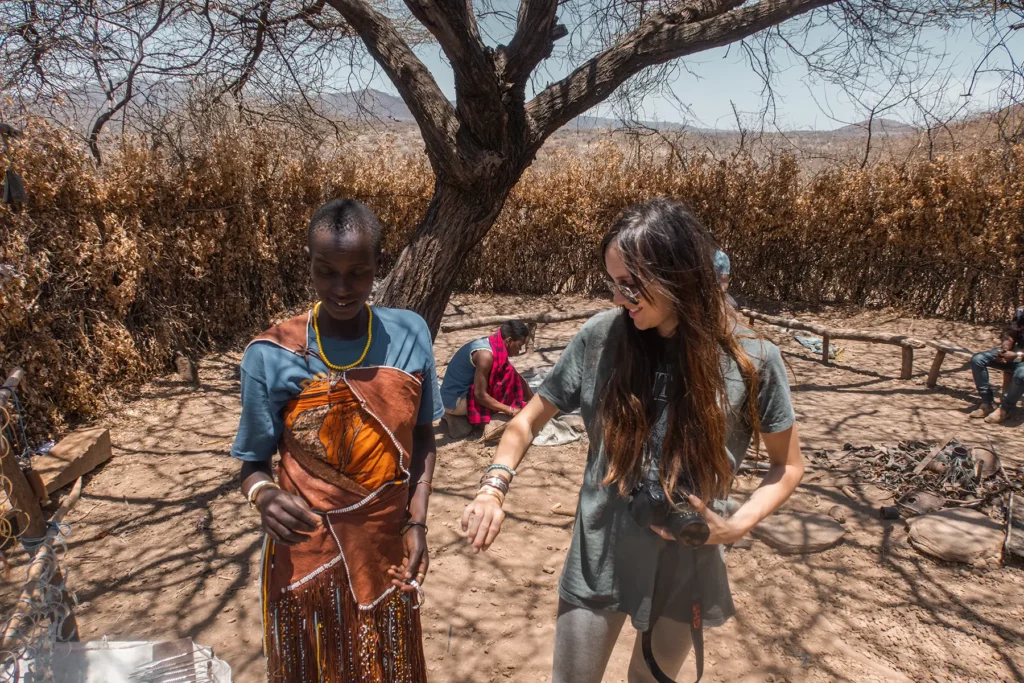
Tips for Visiting the Hadzabe and Datoga Tribes
While their traditions and lifestyles differ vastly from ours, it’s important to always be respectful and have an open mind no matter how strange they may seem to us. Their way of life is not better or worse than ours – just different!
The Hadzabe have faced many serious challenges to retain their preferred simple way of life, their lands and the wildlife upon which they depend entirely. I hope that you’ll understand how important it is for their home to be protected for future generations of their tribe.
If you decide to embark on a hunt with the Hadzabe, be prepared for a half-day hike at a relatively quick pace. It can quickly become exhausting power walking through the bush on uneven terrain in the sun so come prepared with plenty of water and even some snack bars. Wear a cap or sun hat and put on plenty of suncream. Sturdy boots are necessary for this walk and I’d recommend wearing long trousers to protect your skin from thorny bushes that you’ll no doubt have to scramble through.
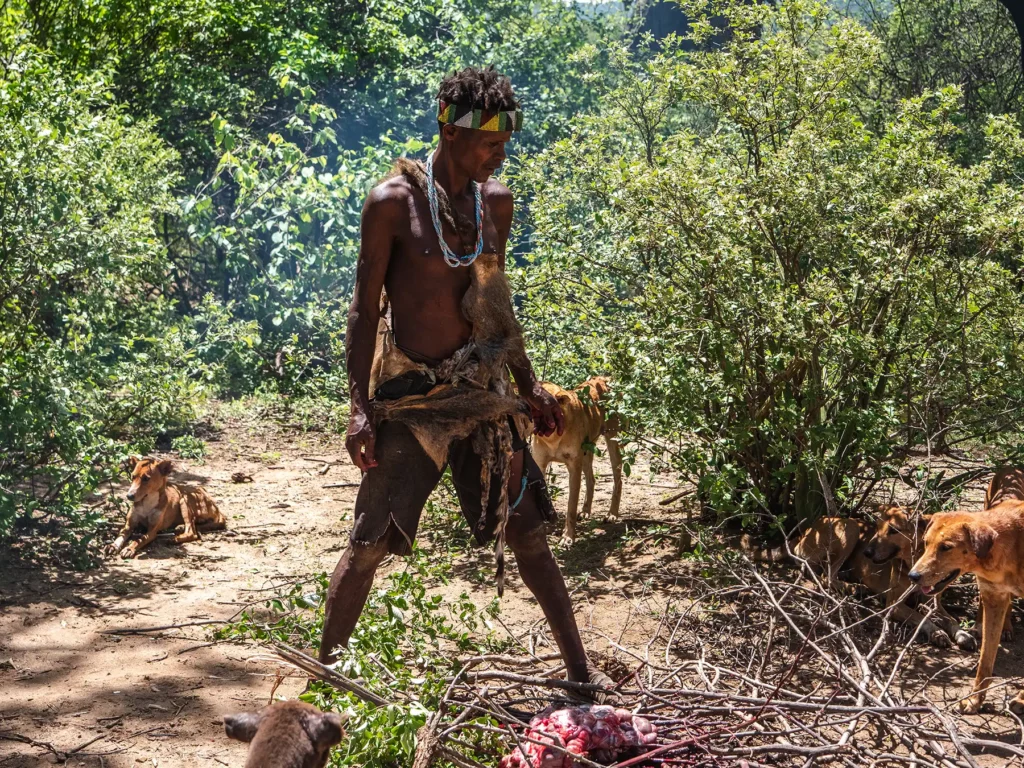
Where to Spend the Night
Karatu is situated on the doorstep of Ngorongoro Conservation Area, and there are numerous lodging options to choose from here.
Lodges or campsites along the crater rim are best as they’ll cut down on travel time tomorrow morning. But these are fairly expensive. Karatu is only a short distance from the park, so you won’t miss out on much if you choose to stay here instead.
My Experience Visiting the Hadzabe and Datoga Tribes
I’ve visited the Hadzabe tribe twice now, and each time it was completely unique and an all-round wonderful experience.
My first visit was during the dry season when the Hadzabe had set up camp around a baobab tree. I joined them and their hunting dogs on a hunt, which was a fascinating experience. The talent and precision needed for their catches were incredible.
One successful hunt was for a white-tailed mongoose; the hunters followed their tracks to a pile of rocks where they tried to dig it out. The mongoose put up quite a fight to escape which led to a tussle with the hunting dogs before the leader eventually emerged with the mongoose.
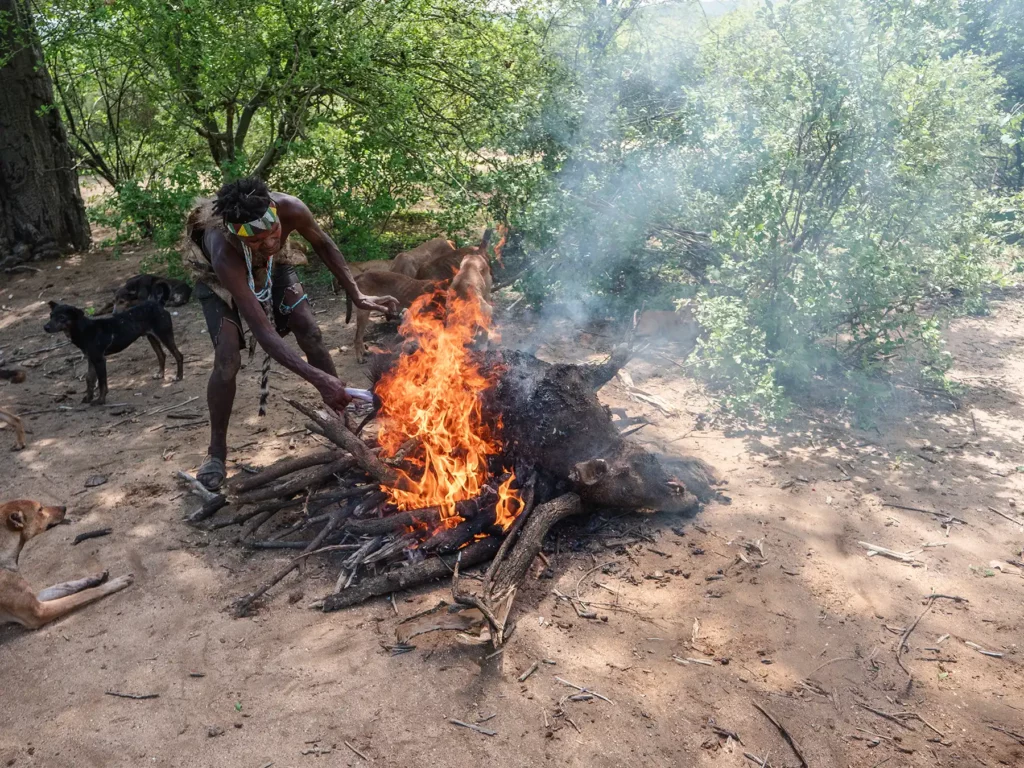
Large catches such as this made the hunters happy, knowing their group would be well-fed for the next few days. I watched them find a shady spot to prepare meat as a snack for the hunters – I tried the dik-dik liver and heart I was offered and enjoyed both.
My second visit was during the rainy season so it was completely different. The tribe had moved to a sheltered hillside cave and this time the hunts were far more difficult. I actually had to take a break at one point as the uneven terrain, slopes, and heat took it out on me – a reminder of how physically fit the Hadzabe are.
But that said, it was as fascinating as the last visit, and I was moved by how welcoming they were.
You can watch a video of my experience visiting the Hadzabe tribe here. Warning: I followed them whilst they went hunting for food with bows and arrows so it’s a bit graphic. They live off the land and have lived like this for thousands of years.
Day 7: Ngorongoro Crater
Total drive time (excluding game drives): 30 minutes to the crater rim. 3-4 hours to Serengeti, depending on region
Today, you’ll head to Ngorongoro Crater. The park is also known as ‘Eden of Africa’ so it’s no surprise that the region is one of the most spectacular and pristine wilderness areas on our planet.
Ngorongoro Crater is a relatively small area of only 260 square kilometres, but it’s packed to the brim with over 25,000 animals, including the Big Five (lion, leopard, elephant, buffalo, rhinoceros).
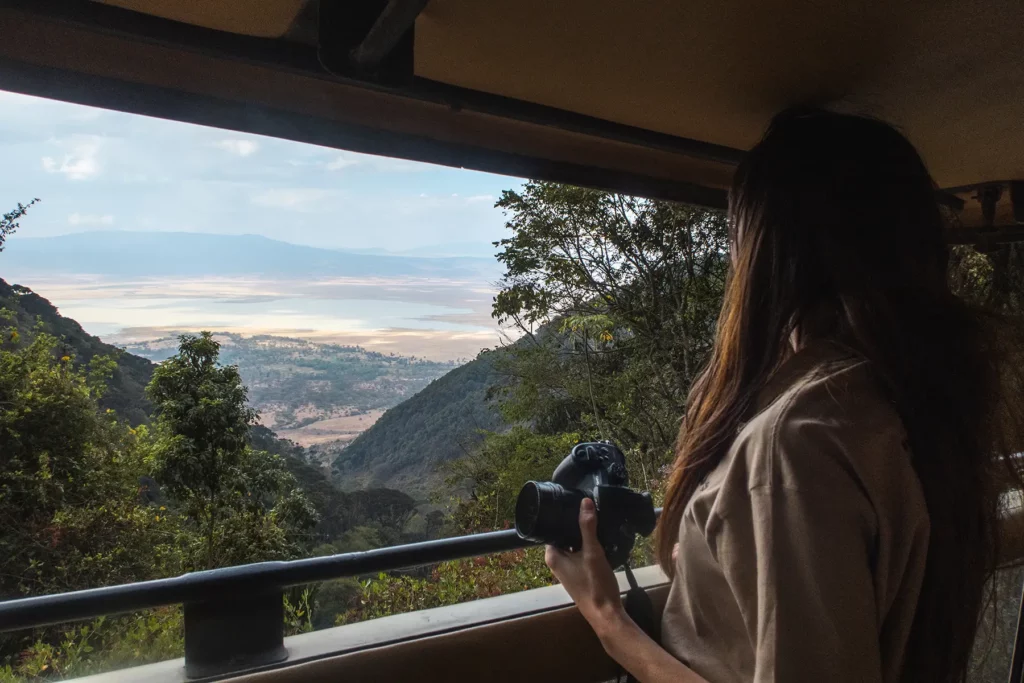
Itinerary
Depending on the location of your lodge, it usually takes just a short 30-minute uphill drive to reach the crater rim. From the summit, you’ll get your first view of the volcanic crater floor 610 metres below. Once you’ve taken in the view (and a few hundred photos), you’ll begin your descent into the crater floor.
After spending the morning viewing a vast array of game and birdlife, you’ll pause for lunch at a secure picnic spot, overlooking a hippo pool.
The safari will continue briefly in the afternoon before you begin the 3-4 hour drive towards Serengeti National Park.

About Ngorongoro Crater
The Ngorongoro Crater is thought to have been formed around two and a half million years ago when the volcano collapsed inwards in a massive and violent eruption. Stretching 19 kilometres in diameter, the steep crater rim prevents any migration from taking place, ensuring that Ngorongoro remains an excellent all-year-round safari destination.
The park is home to a vast array of Africa’s wildlife, except for giraffes and crocodiles. Although no wildlife sighting is ever guaranteed, Ngorongoro is a good place to potentially witness a kill or see the critically endangered black rhino.
The crater floor consists of grassland savannas, woodlands, and Magadi Lake in the centre. The lake attracts huge flocks of pink flamingos, while you’ll also find cheetahs, wildebeest, zebras, hyenas, golden wolves, hippos, eland, kudus, impalas and various other antelope and countless bird species.
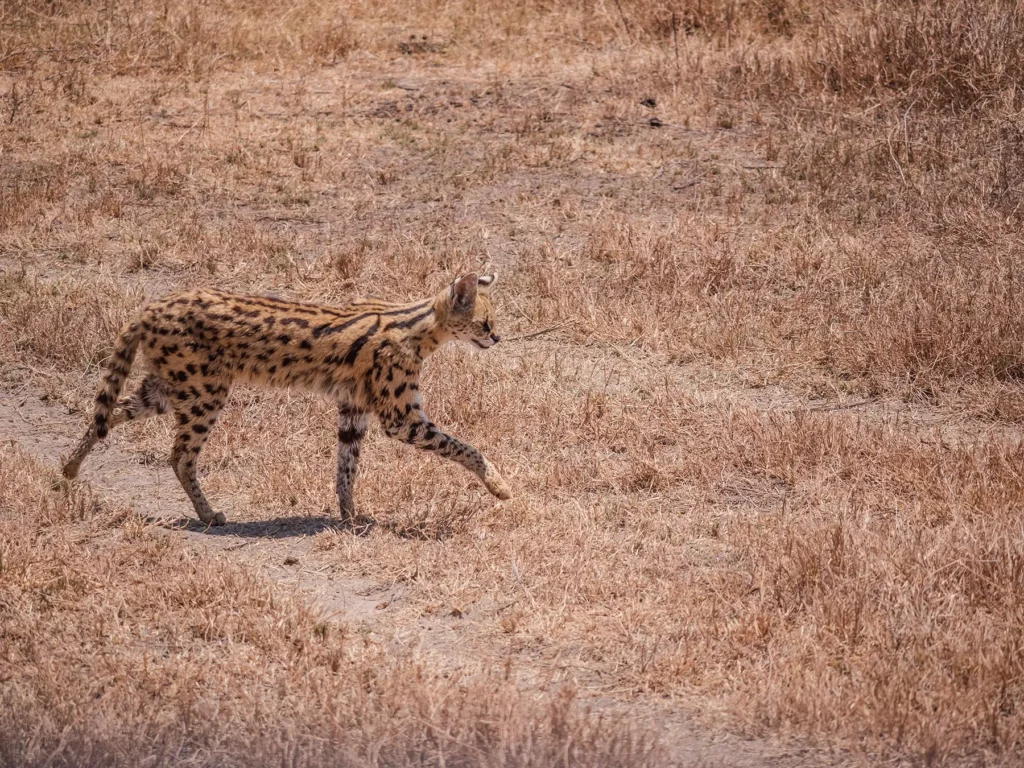
Tips for Visiting Ngorongoro Crater
The gates of the park open at 6 am and it’s highly advisable to get here early. This is the best time to witness wildlife activity before the animals (particularly the big cats) slink off to the dense woodlands to avoid the hot sun.
Despite the heat, the crater floor is often windy and can get pretty chilly, so bring warm layers which you can take off later if necessary. Sunscreen, sunglasses and hats are also essentials.
Whilst enjoying your lunch, be mindful of the thieving black kites, which like to hover above the picnic sites, or else they might steal it from you! I saw a black kite swoop down and steal a sandwich right out of a woman’s hand. She looked crestfallen!
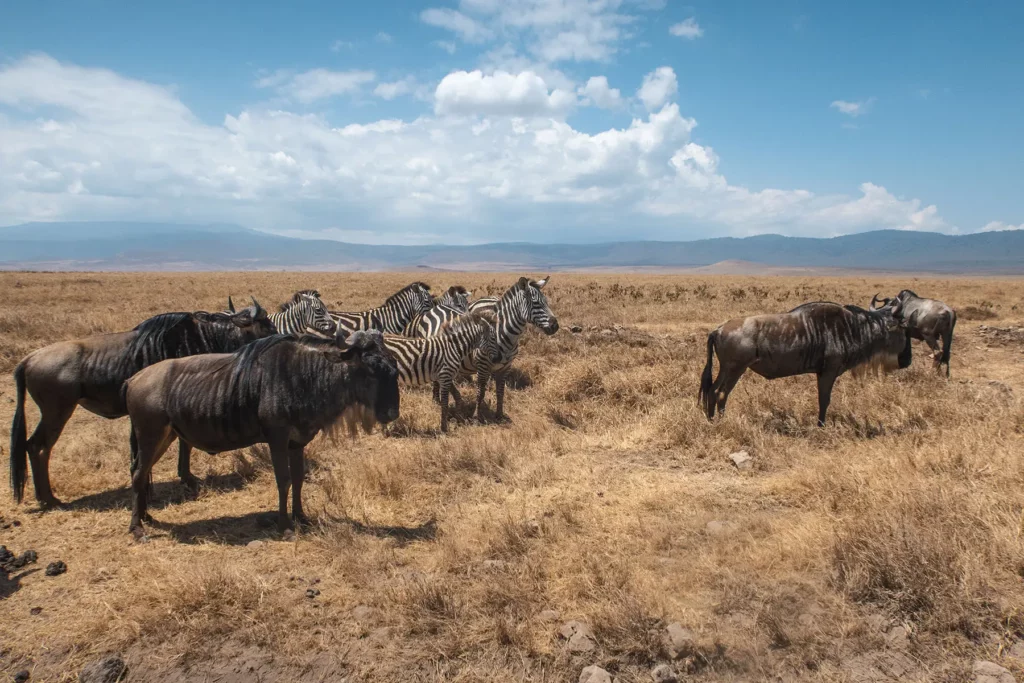
Where to Spend the Night
You’ll spend the night at a tented camp or lodge within Serengeti National Park.
If your visit is between January and March, your lodge or tented camp will be somewhere in the southern Serengeti. For other times of the year, you’ll most likely stay in the central regions. There’s a vast range of accommodation to choose from here.
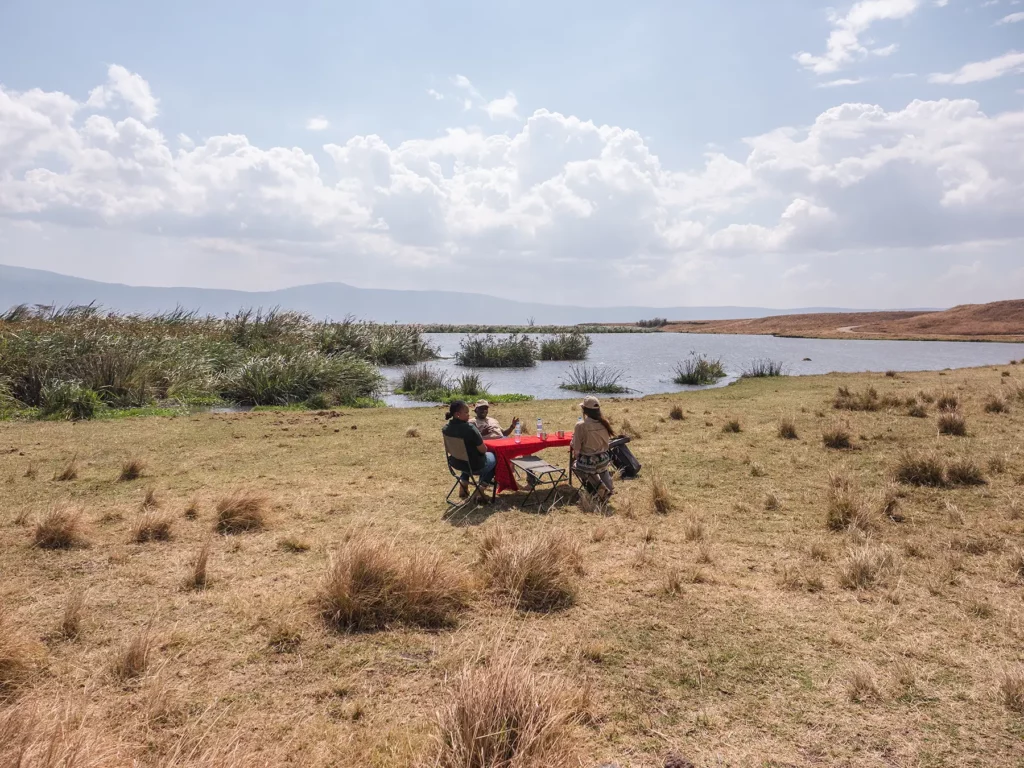
My Experience Visiting Ngorongoro Crater
The drive into Ngorongoro from Karatu was an enchanting experience. As we entered the Ngorongoro Conservation Area, we found ourselves on the crater rim, surrounded by dense forests and enveloped in a thick mist, creating a magical atmosphere.
The mist eventually cleared, revealing Maasai herders and their cattle mingling with zebras. As we descended into the crater, we had our first sighting of a distant hyena on the crater floor, followed by a close encounter with two male buffalos and numerous wildebeest, zebras, and gazelles, alongside flamingoes on the lake.
One of the most memorable moments was spotting three servals, a rare sight during the day, prowling through the savannah. We watched as they expertly hunted, with elegant leaps leading to treats to gobble up – probably mice.
We also observed an African golden wolf, a huge herd of buffalo, grey-crowned cranes, and lionesses relaxing by a stream. Stopping for lunch beside a hippo pool was also a highlight, as was a final sighting of elephants in the Lerai Forest on the way out.
You can watch a video of my experience visiting Ngorongoro Crater below.
Day 8 – 10: Serengeti National Park
Total drive time (excluding game drives): 0 hours
For many visitors, including me, this is the favourite safari destination in Tanzania. Serengeti National Park has a diverse range of wildlife and is home to the world-famous great wildebeest migration.
Serengeti means ‘endless plains’ in the Maasai language, which will be apparent from its vast savannas and woodlands stretching to the horizon and beyond.
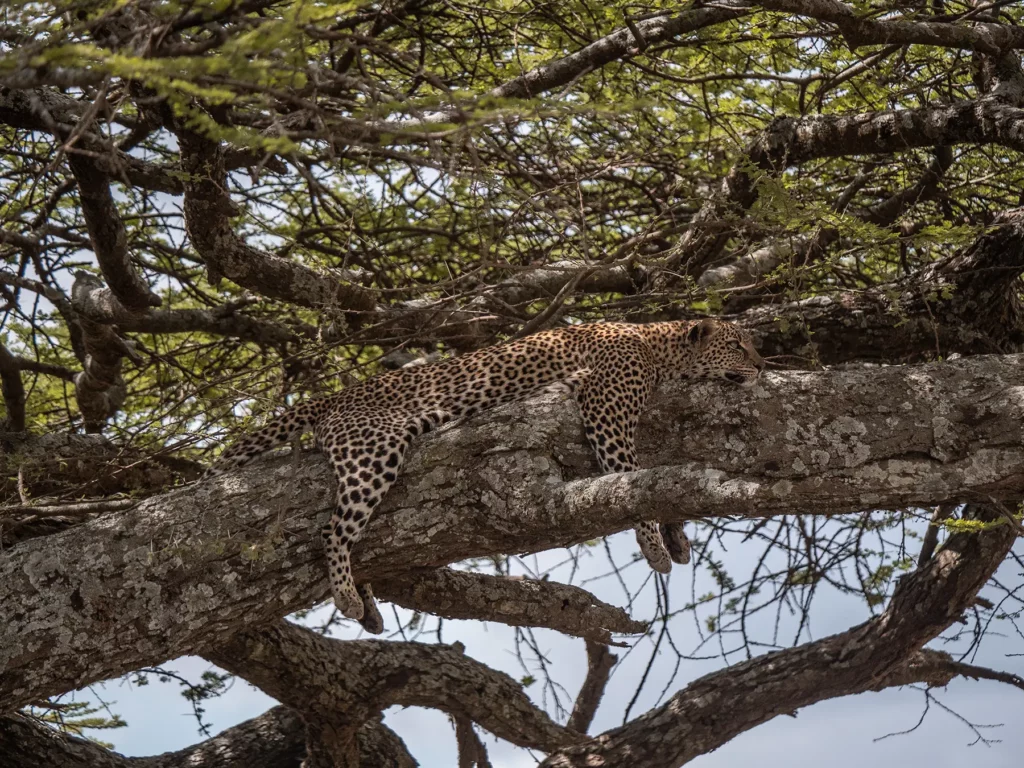
Itinerary
With so much to see and do, you’ll be spending the next three days on game drives, traversing pristine landscapes and perhaps viewing the largest numbers of wild animals you’ll ever see.
As always, it’s normal to begin game drives early so you have the best chance of seeing predator activity before they hide from the midday sun. Then, after a solid morning of driving through the bush, you’ll stop for lunch in one of the park’s many picnic spots, before setting out again until sunset.
Your days in the Serengeti will end by returning to your lodge for dinner and a well-deserved rest, before doing it all again tomorrow!
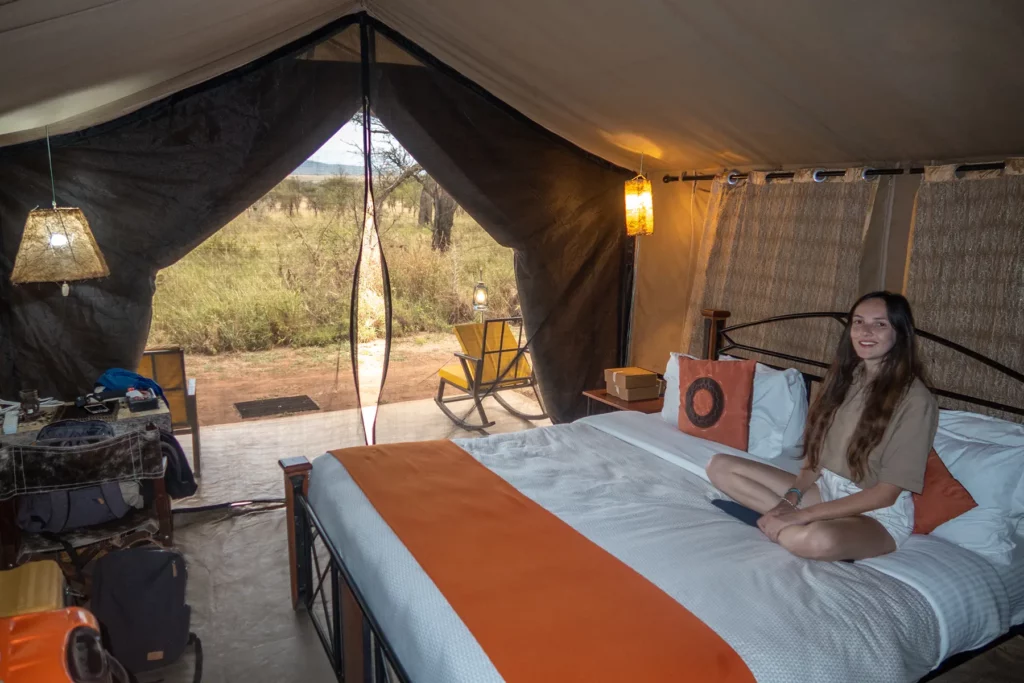
About Serengeti National Park
The Serengeti National Park consists of 15,000 square kilometres of wilderness and is home to an abundance of big cats. These include 4,000 lions, 1000 leopards and 500 cheetahs.
Other animals in large numbers here include large herds of elephants, buffaloes, hippos, crocodiles, rhinos, giraffes, zebras, wildebeest, warthogs, impalas, and countless other herbivores and bird species.
Serengeti is also a co-host (with Kenya) to the Great Wildebeest Migration, where over two million wildebeest, zebras and antelope take off on their perilous annual journey north in search of greener pastures and fresh water. There’s no surprise that this is known as the greatest wildlife spectacle on the planet.
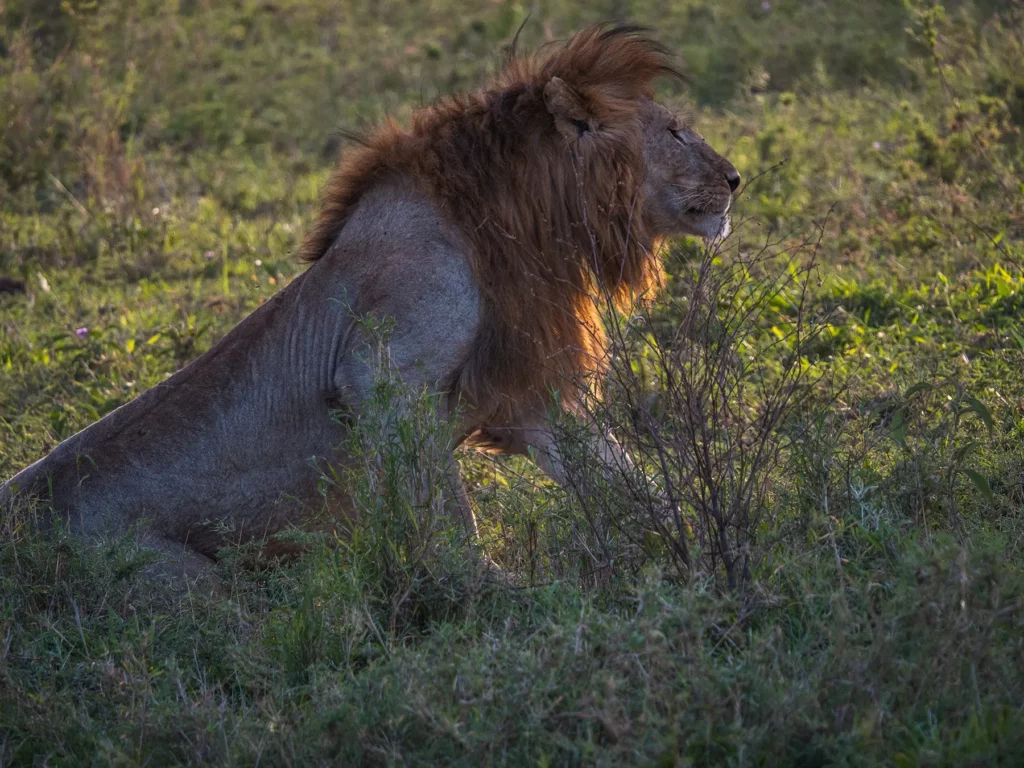
During their dramatic migration, these animals are constantly under attack from big predators, such as lions and hyenas. And once they reach the rivers? They have to navigate crocodile-infested river crossings, where it is absolute pandemonium.
Unfortunately, this means the stragglers, weak and wounded, don’t usually complete this journey. It’s estimated that a quarter of a million animals perish along the way each year. But those lives are not lost in vain; in fact, the migration ensures the survival of millions of others. There’s no better example of the circle of life.
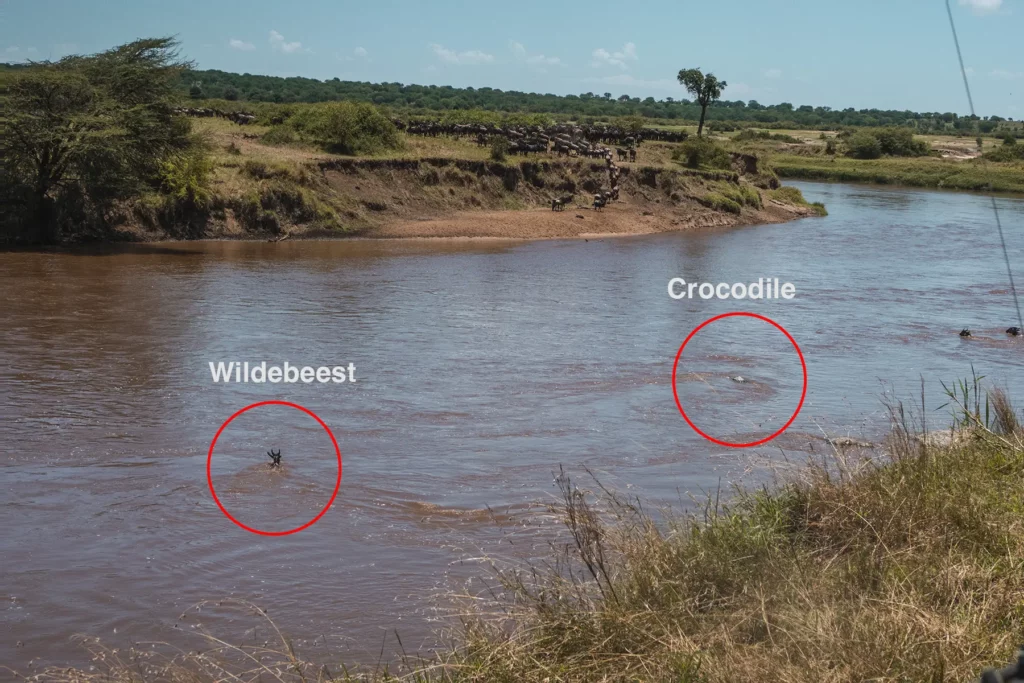
Tips for Visiting Serengeti National Park
Regardless of the season, early mornings in the Serengeti can still be cold, so it’s best to dress in layers which you can remove as the day warms up.
This is also a high tsetse fly area, so bug sprays, long sleeves, and long pants are recommended. Tsetse flies are attracted to dark colours, especially black and navy blue, so light, beige and neutral-coloured clothing is ideal for all safaris.
Where to Spend the Night
Serengeti has a vast number of lodges of all styles scattered throughout every region of the park.
From January to March, many visitors stay in the southern regions of the Serengeti, where most of the calvings and subsequent cat activities are. Whereas between April to May, you’ll likely stay on the Western Corridor, closer to the moving herds.
Meanwhile, the great migration takes place from June to October, so the northern regions close to the infamous Mara River crossing are an ideal area to stay.
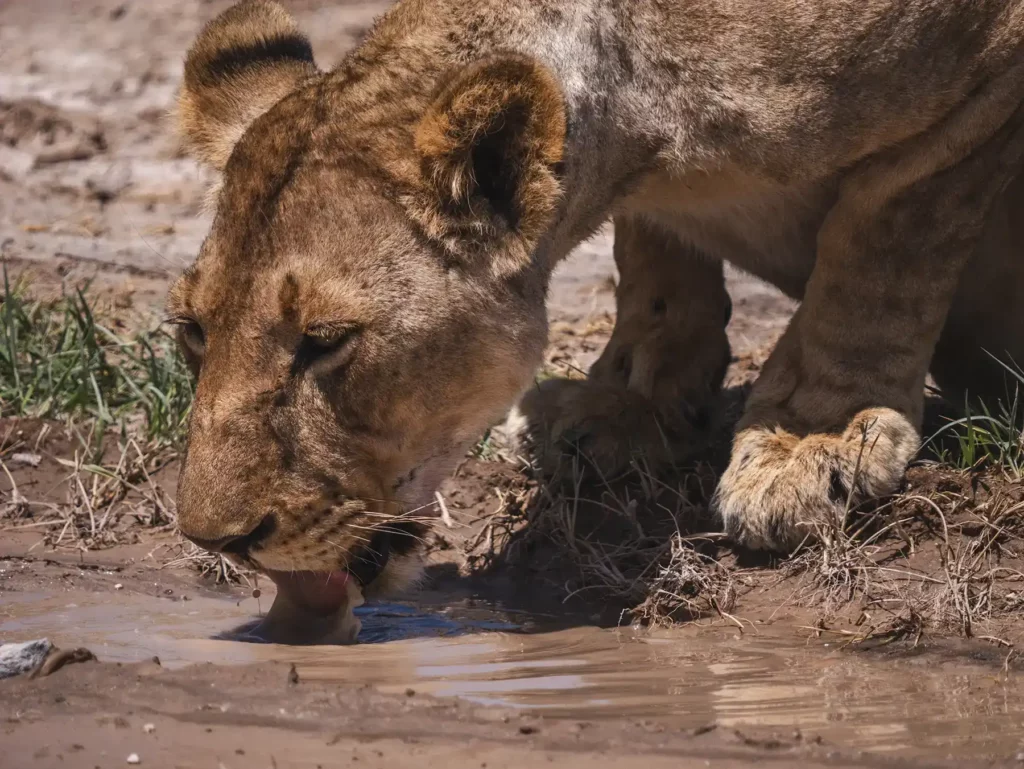
My Experience Visiting Serengeti National Park
Central Serengeti never fails to impress, no matter the time of year. During my first visit, I was thrilled to see three leopards in a single day, including a cub and its mother in nearby trees.
I also saw tons of lions, including a majestic male on a rock, a mating pair, and later a lioness by a stream. I then noticed a lioness lying on the sturdy branch of an acacia tree nearby – this is one of the only places where you can spot tree-climbing lions, so this was a treat.
I also had some incredible cheetah sightings, including two males feeding on a young wildebeest, and a female cheetah surveying the landscape from a termite mound.
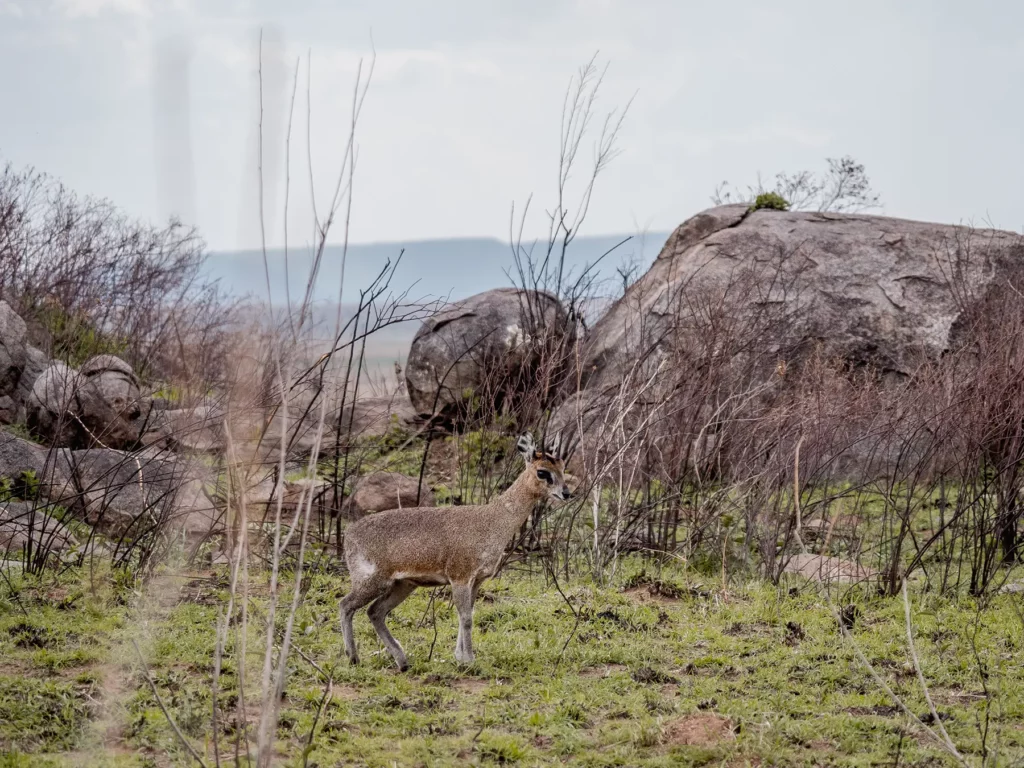
And I was amazed by the sheer number of elephants, even more than I’d seen in Tarangire. Other wildlife sightings included topis, zebras, dik-diks, loads of giraffes, hippos, gazelles, impalas, baboons, and hyenas, which were mostly seen in the early mornings.
In Northern Serengeti, I had the unforgettable experience of witnessing the wildebeest migration across the Mara River. Although the drive from Central Serengeti was long, it was worth it to see the wildebeest leaping into the river and battling the strong currents. While the wildebeest’s first crossing was successful, the second was more dramatic, with huge crocodiles waiting for their chance.
The Northern Serengeti also offered sightings of zebras, impalas, gazelles, and two secretary birds.
You can watch a video of my experience visiting Serengeti National Park below.
Day 11: Serengeti to Ruaha National Park
Total drive time (excluding game drives): 2 hours (from the airstrip to Ruaha) and a flight beforehand.
Today will be spent getting from Serengeti to Ruaha National Park. The exact distance will vary depending on which area of the Serengeti you’re staying in, but if you chose to drive (rather than fly) you’d expect a very long ten-hour drive!
Fortunately, to avoid spending the whole day on a bumpy road, there are several direct flights available.
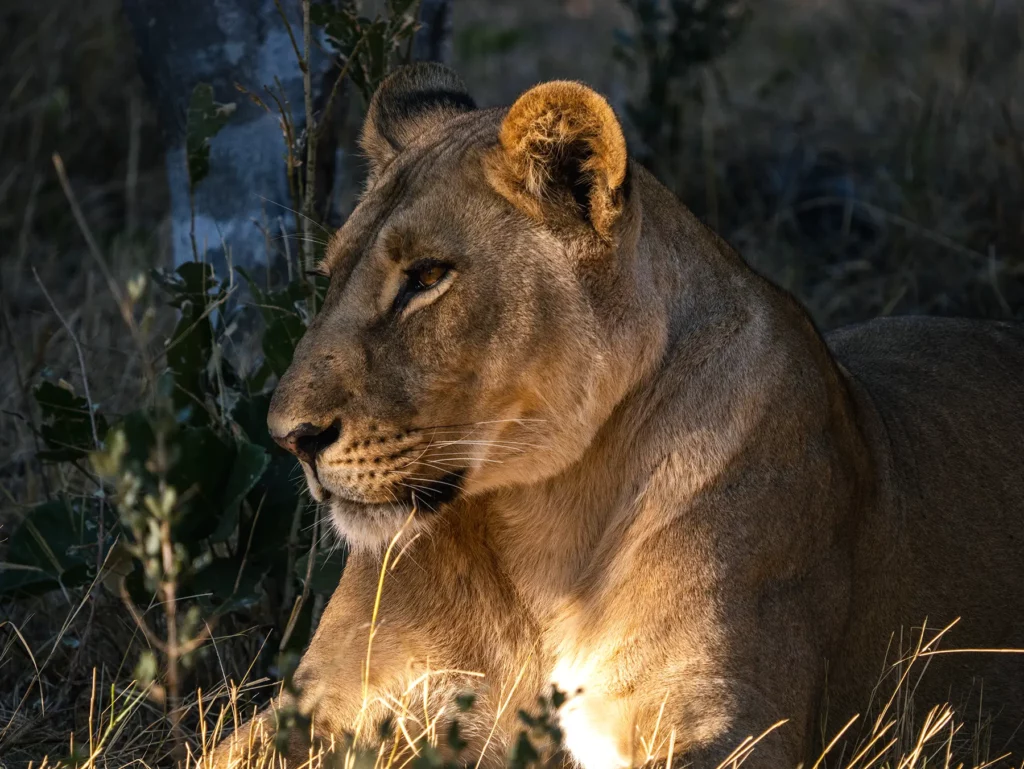
Itinerary
The best way to get from the Serengeti to Ruaha is to take one of the three weekly flights from either Kogatende, in Northern Serengeti, or from Seronera, in the centre. These flights will take you to the Msembe/Jongomero airstrips, from where a 2-hour drive will get you to the Ruaha National Park.
Otherwise, you can take an indirect flight via Arusha and Dar es Salaam, though these indirect flights can be complicated to navigate. I’d suggest asking your local tour operator to help you plan your flight itinerary.
The direct flight is by far the easiest option!
Fortunately, once you’ve endured the journey, you’ll spend the next two days in Ruaha enjoying the park.
You can watch a video of my experience visiting Serengeti National Park below.
Day 12 – 13: Ruaha National Park
Total drive time (excluding game drives): 0 hours (if staying in the park)
Your journey from the Serengeti has paid off, and now you get to enjoy two days in the beautiful and secluded Ruaha National Park.
Itinerary
Enjoy two days of game drives, or mix things up by spending one day on a walking, boating, or birding safari. And if you want to spend some time just lounging leisurely within your lodge or tented campsite, you deserve it!
About Ruaha National Park
Despite being one of the biggest and most beautiful national parks of Tanzania, what separates Ruaha from the other more well-known parks is the surprisingly low number of visitors.
Ruaha provides miles and miles of quiet serene remoteness, with all the wildlife you could ever wish to see. So if you want to enjoy Africa’s wilderness spaces without feeling crowded by safari trucks, this is the place for you.
The park’s varied landscapes include savannah, woodlands and waterways, which together support a high number of big predators such as lions, leopards, cheetahs, hyenas and wild dogs. You may also spot huge herds of elephants, buffaloes, zebras, giraffes, crocodiles, hippos, wildebeest, thousands of various bucks, and over 500 bird species.
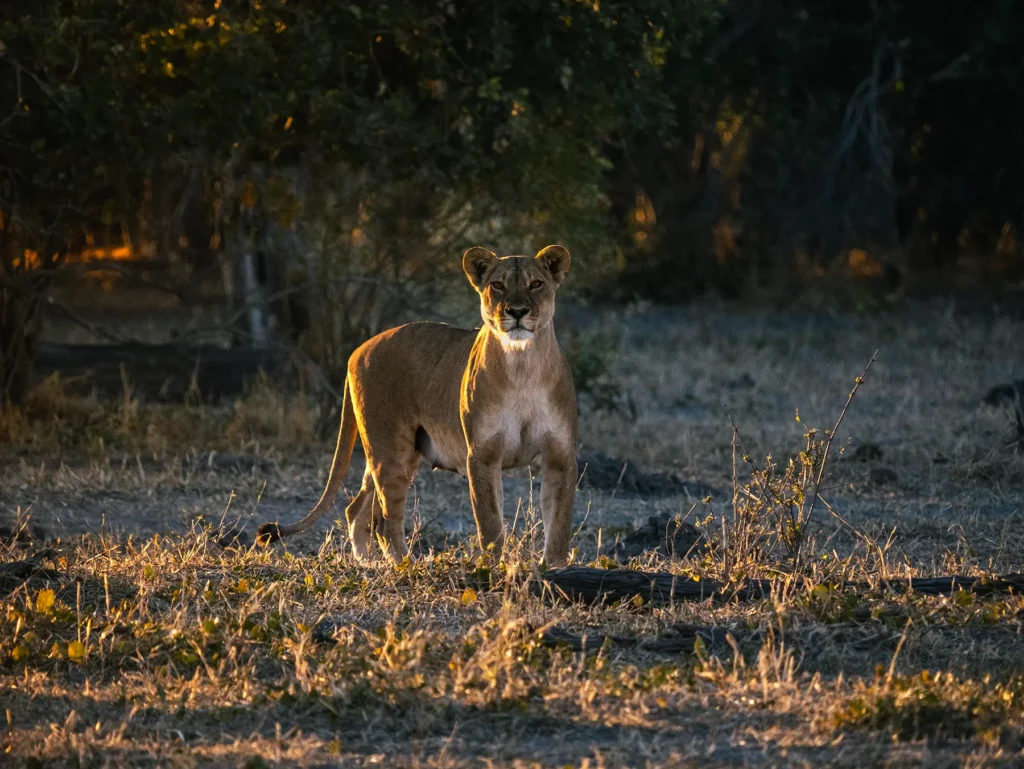
Tips for Visiting Ruaha National Park
For wildlife, June to October are by far the best months to visit. These months have perfect weather and great wildlife viewing, but prices are at their highest. That said, despite being peak season, Ruaha is far less crowded than other parts of the country all year round.
Meanwhile, January and February are decent months to visit. Although these months can be wet, the lush greenery and rich birdlife are at their finest. Tourism is fairly low and prices are less expensive during this period.
On the other hand, I’d avoid visiting from March to May, when many lodges are closed due to low tourism, heavy rainfall and high malaria risk.
Where to Spend the Night
You’ll spend these two nights at a lodge or tented camp within Ruaha National Park.
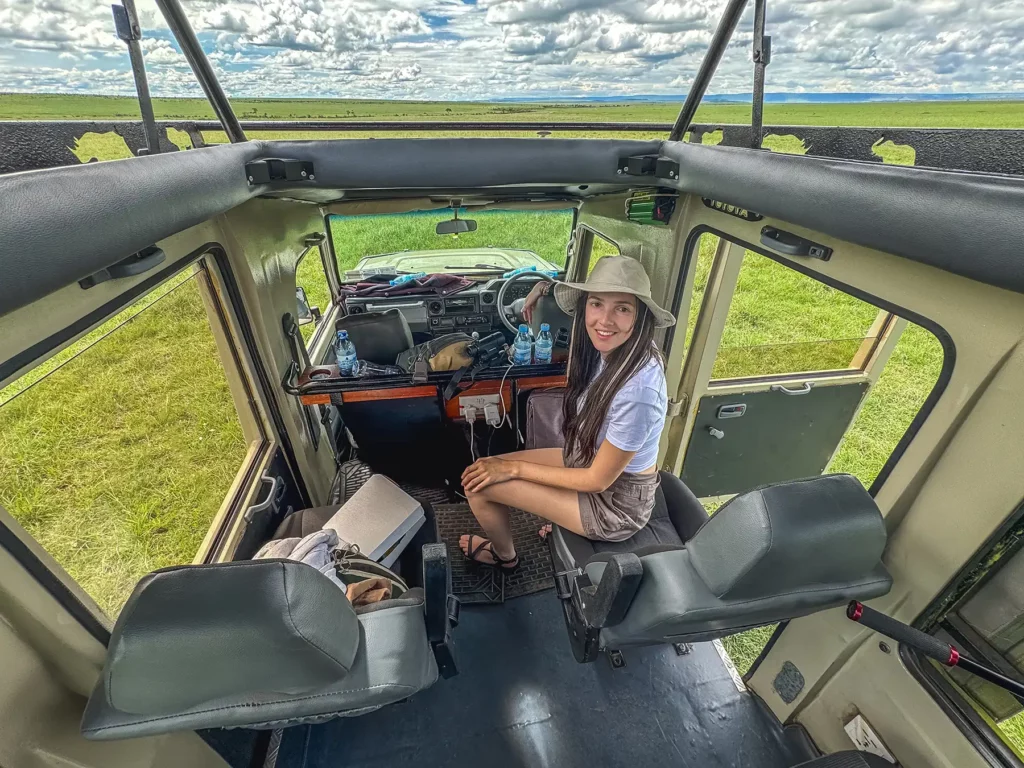
Day 14: Ruaha and Nyerere National Park
Total drive time (excluding game drives): 2 hours (from Ruaha to the airstrip) plus a flight
Today you’ll travel from Ruaha to Nyerere National Park.
Nyerere is also situated in Tanzania’s southern circuit and is a few hundred kilometres east of Ruaha National Park.
Itinerary
From Ruaha, you’ll need to fly to Nyerere as it’s too far to drive between the two.
Thankfully, this travel day is more straightforward than the last, so you’ll reach your selected lodge in time for an afternoon game drive.
There are numerous airstrips throughout the Nyerere, and once you’ve arrived, you’ll remain here for the next two days.
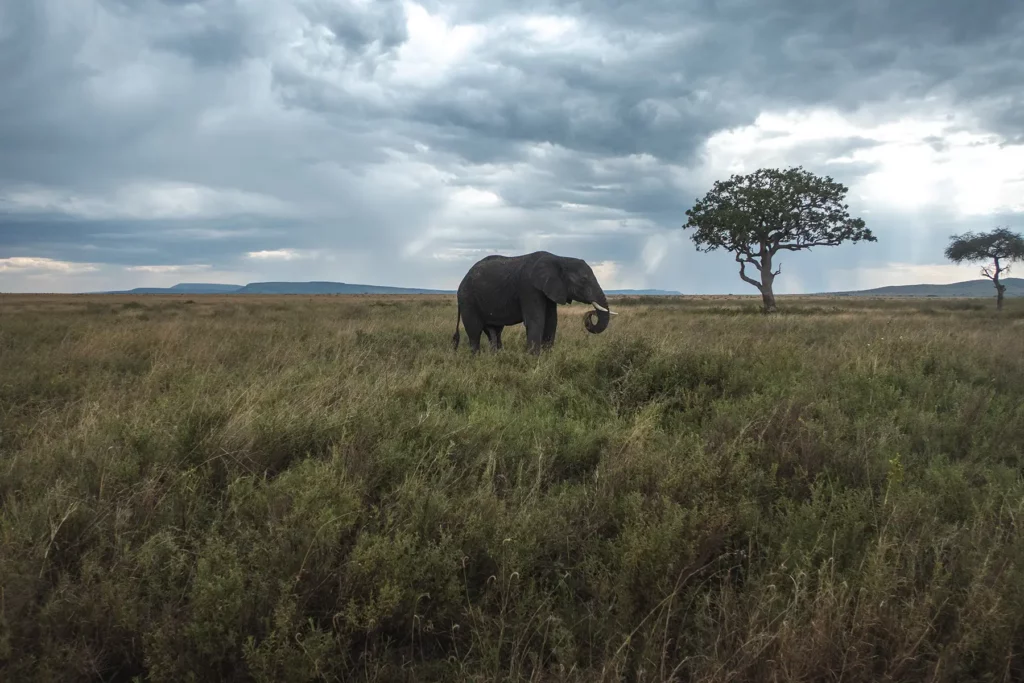
About Nyerere National Park
Nyerere (formerly known as Selous) is similar to Ruaha in terms of wildlife and remoteness, but here there is more water due to having numerous lakes, watering holes and rivers throughout the park.
Game drives are still fantastic here, but due to the number of waterways, it’s the perfect place to take a boating safari.
Tips for Visiting Nyerere National Park
As with Ruaha, the rainy season is fairly heavy and humidity can become unbearable, particularly during February and March. It is best to avoid coming here during this time.
Where to Spend the Night
Lodges and tented campsites are plentiful in this park, many of which are situated on the banks of rivers, with magnificent waterfront views.
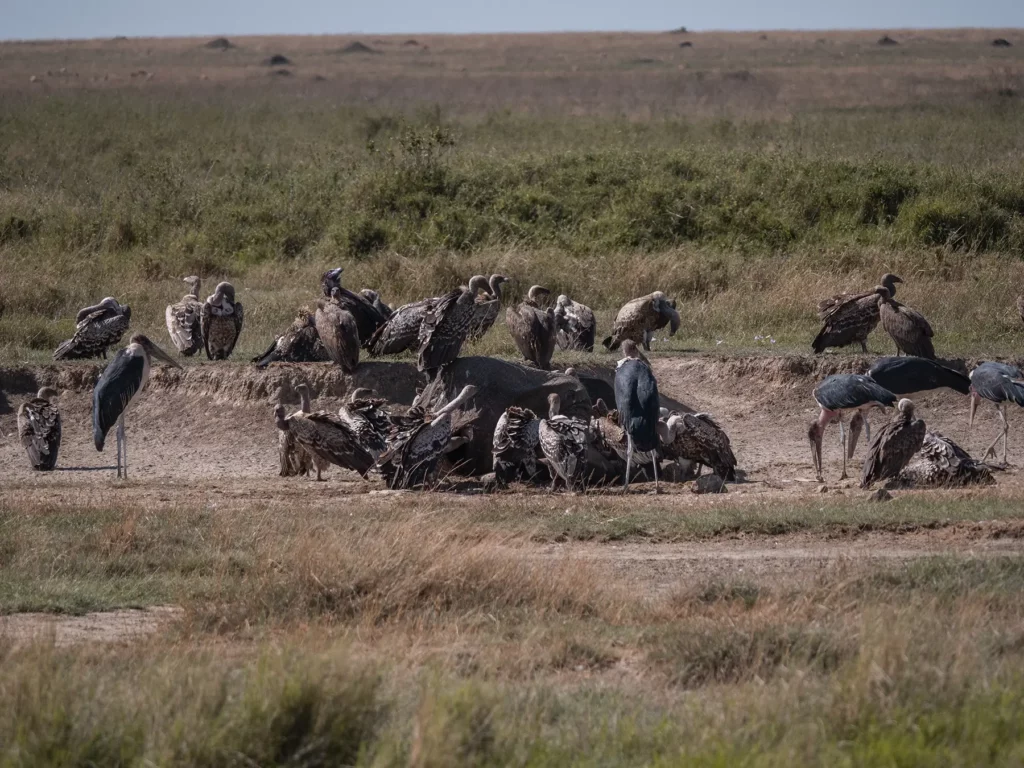
Day 15: Nyerere National Park
Total drive time (excluding game drives): 0 hours
As this is your last full day at the Nyerere National Park, if you haven’t had a boating safari, today is the day.
Itinerary
A full-day Nyerere Boat safari provides the best opportunity to ride along the Rufiji River and enter the lake systems. From the water, you’ll see a wide range of game and birdlife.
You’re likely to encounter hippos and crocs in the water or along the shoreline, alongside elephants, giraffes, zebras, buffaloes, waterbuck, and warthogs coming to cool down and quench their thirst. Predators get thirsty too, so you may see them coming for a drink here too – or a hunt!
Keep an eye out for fish eagles, kingfishers, goliath herons and the distinct black and white colobus monkeys flitting high in the lush tree canopy lining the shores. The boat ride will include a lunch break along a quiet spot along the banks.
Sunrises and sunsets along the waterways are truly magical.
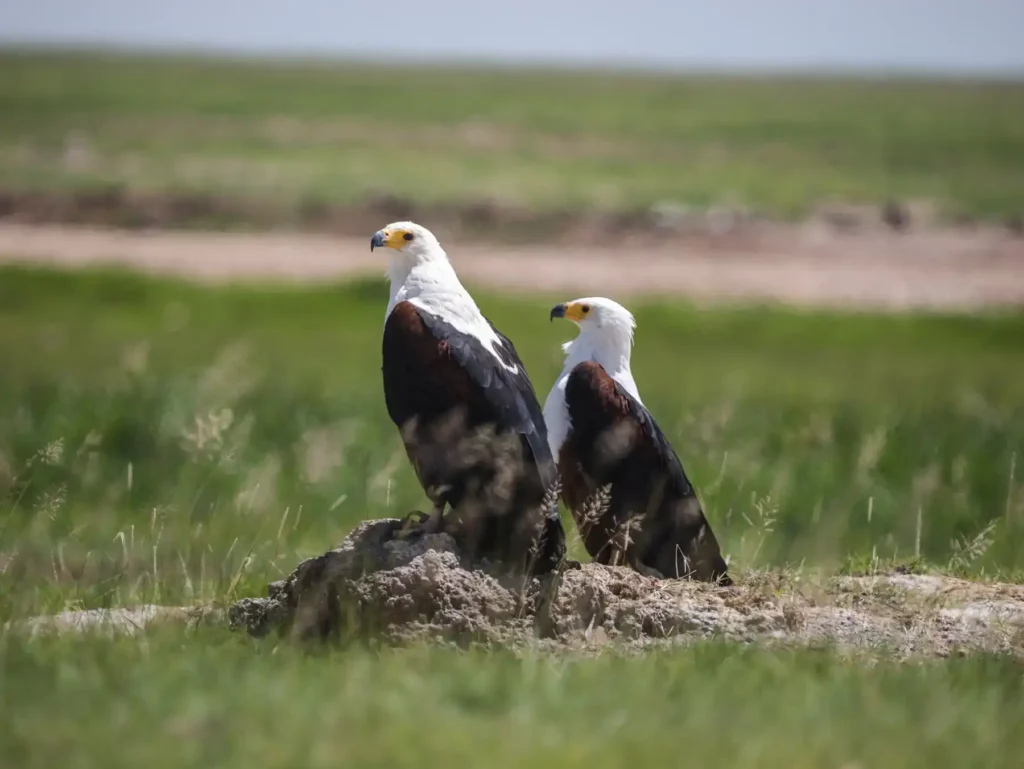
Tips for Your Boat Safari in Nyerere National Park
Have your camera ready at all times whilst on the water, as a hippo yawn or a croc can pop up and disappear in a flash.
Late afternoons provide a better chance to get close to a crocodile, as the rising water temperature keeps them close to the surface. The mornings seem to be better for spotting birds.
Where to Spend the Night
You’ll spend tonight at the same lodge as last night.
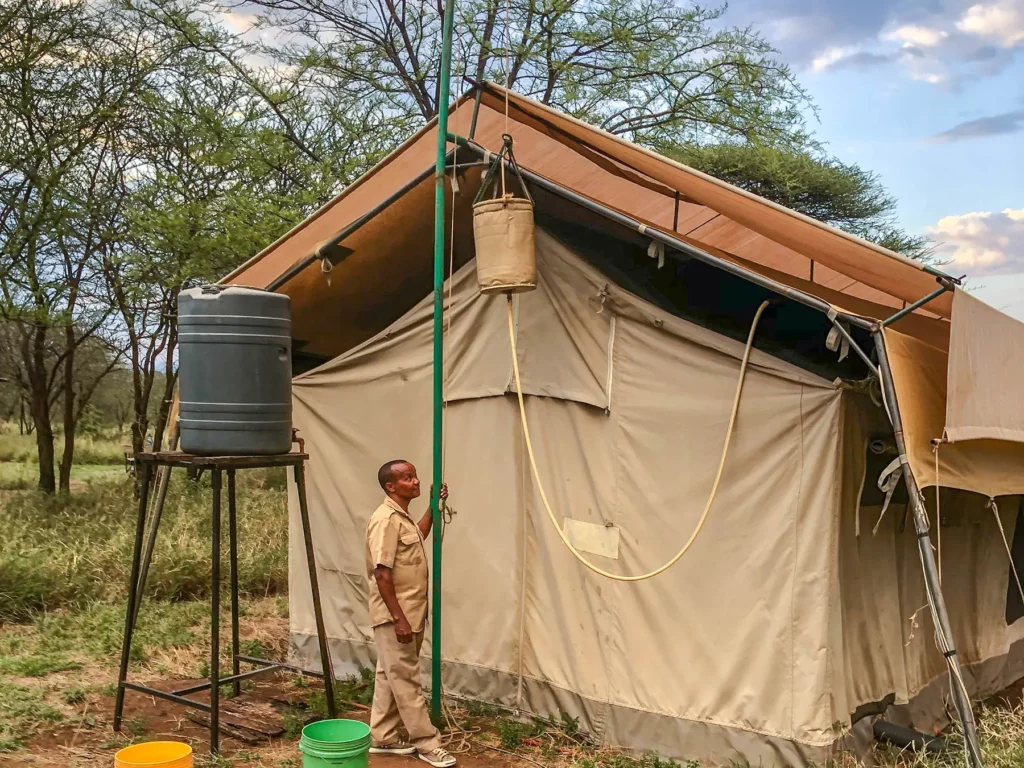
Day 16: Dar Es Salaam
Total drive time: 30 minutes from the airport to your hotel
Today you will journey to Tanzania’s largest city! Once you arrive in Dar, you are free to choose how to spend your day in the city, as tomorrow morning you’ll be heading off to Zanzibar.
Itinerary
In the morning, fly to Dar and go to your selected hotel. You can spend the afternoon exploring the city or catching up on some rest.
About Dar Es Salaam
With a population fast approaching seven million people, Dar es Salaam is the biggest city in Tanzania. As you approach the city, you’ll notice the skyline is a rich mix of old and new, with architecture taking on Indian, Arab and European colonial influences standing beside ultra-modern high-rise buildings.
What was once a quiet fishing village in the mid-19th century, Dar es Salaam (city of peace) has developed into a thriving bustling metropolis.
Situated along the East Coast of Africa, the city is also known for having miles of glorious beaches lining the warm waters of the Indian Ocean, making Dar a fantastic cultural and relaxing tourist destination.
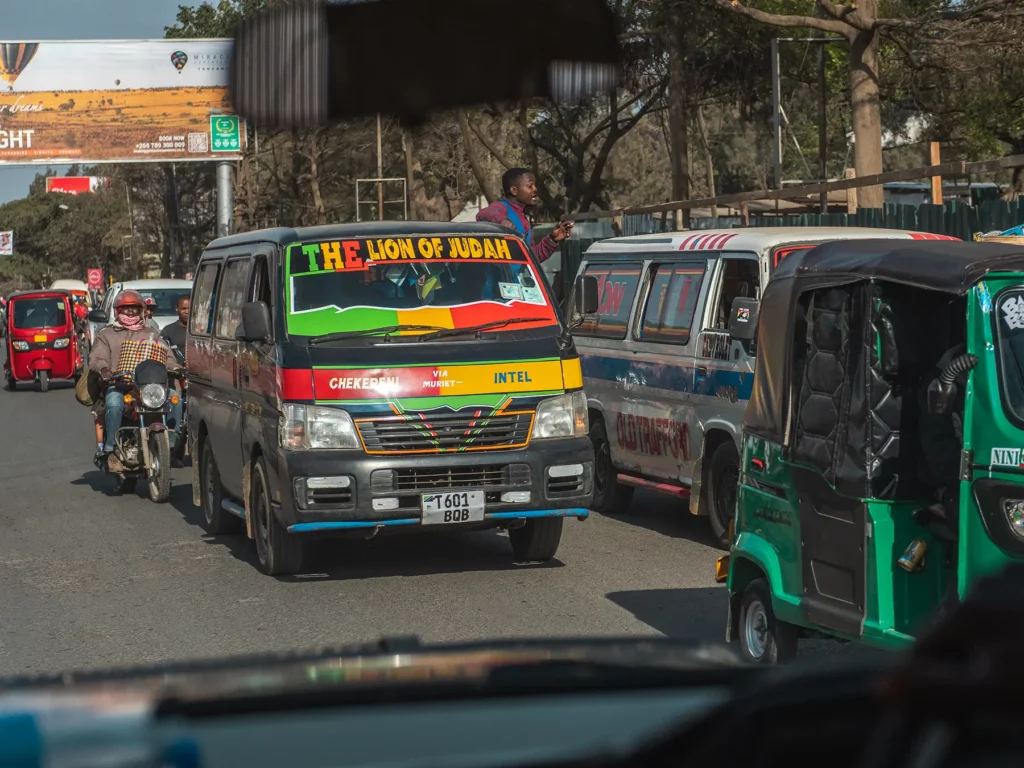
Things to Do in Dar Es Salaam
There are numerous ways to spend your afternoon in Dar.
For culture vultures, the National Museum of Tanzania, situated on the harbourfront, is an excellent place to escape the heat or rain and learn about the country’s history and culture. The St Joseph Catholic Cathedral situated a stone’s throw away behind the ferry point is certainly worth visiting to restore a sense of calm.
For shopaholics, the Kariakoo Market is a fascinating place to browse for local homemade artworks, colourful clothing, international fashion items, spices and souvenirs, all while taking in the inviting aromas of the prepared traditional foods.
Meanwhile, the beautiful beaches are a great place to relax or swim.
Tips for Visiting Dar Es Salaam
Although Dar is regarded as fairly safe, like in every city, pickpocketing and petty theft are not uncommon.
It’s best to stick to low-risk touristy areas and not to wear visible jewellery or flash your wallets in public. Avoid walking alone after dark – you can ask your hotel to book you a reputable taxi if needed.
Where to Spend the Night
Being a popular tourist destination, Dar es Salaam has a vast number of accommodation options to meet all tastes and budgets, ranging from the 5-star Hyatt Regency to the most rustic B&B.
After spending the last two weeks trudging around on rough dusty roads in the Tanzanian bush, you may be ready to indulge in some pampering and a few creature comforts of the modern world. If your budget allows, look no further than the Oyster Bay Hotel.
Situated in (you guessed it) Oyster Bay overlooking Coco Beach and the Indian Ocean, this small hotel is sheer class with all the modern luxuries and amenities. It is also conveniently situated next to a shopping mall and surrounded by restaurants. The beach is a mere stone’s throw away or you can stay in your hotel, relaxing around their pool.
There are, of course, numerous similar hotels spread along the shoreline of the city.
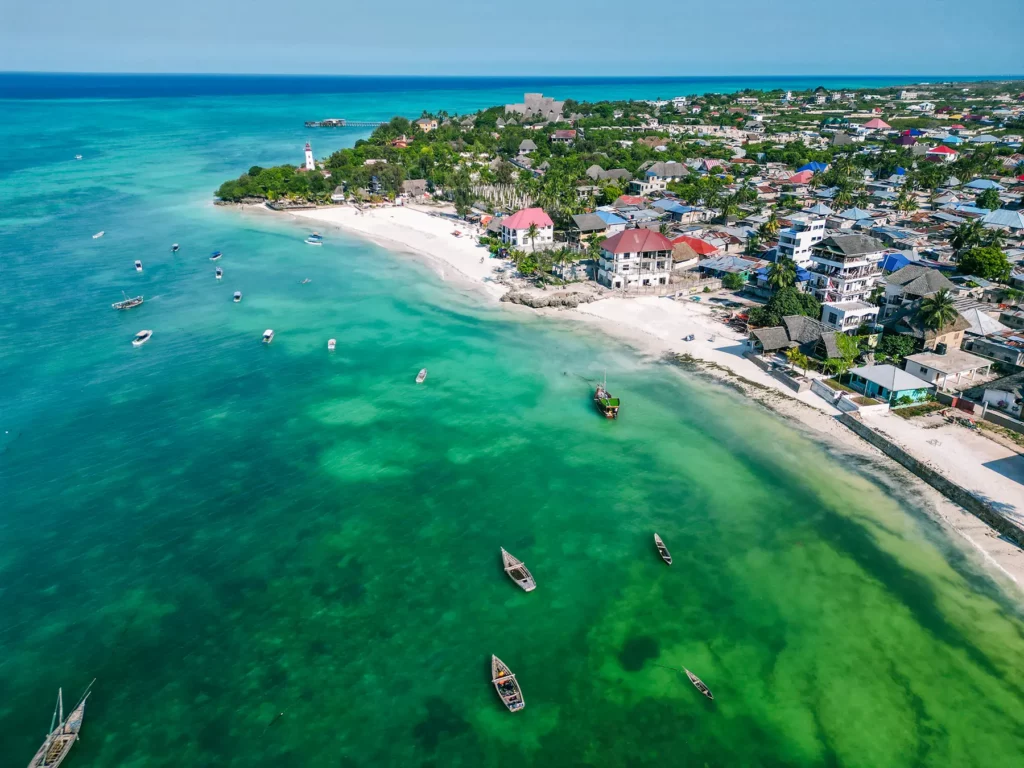
Day 17: Zanzibar
Total drive time: Approximately 30 minutes (to the airport or ferry terminal) plus an extra drive from your arrival in Zanzibar to your accommodation.
Today you’ll set off for the final leg of your 3-week Tanzania holiday – the paradise islands of Zanzibar.
Rather than having a set routine and early morning game drives, now is the time to relax and do whatever you feel like doing.
Itinerary
In the morning, fly or take the ferry to Zanzibar.
Ferry rides take approximately 1 hour and 20 minutes, while by air it’s a quick 25-minute flight.
There are regular daily flights and ferries to fit in with your schedule, so no need to schedule an early alarm.
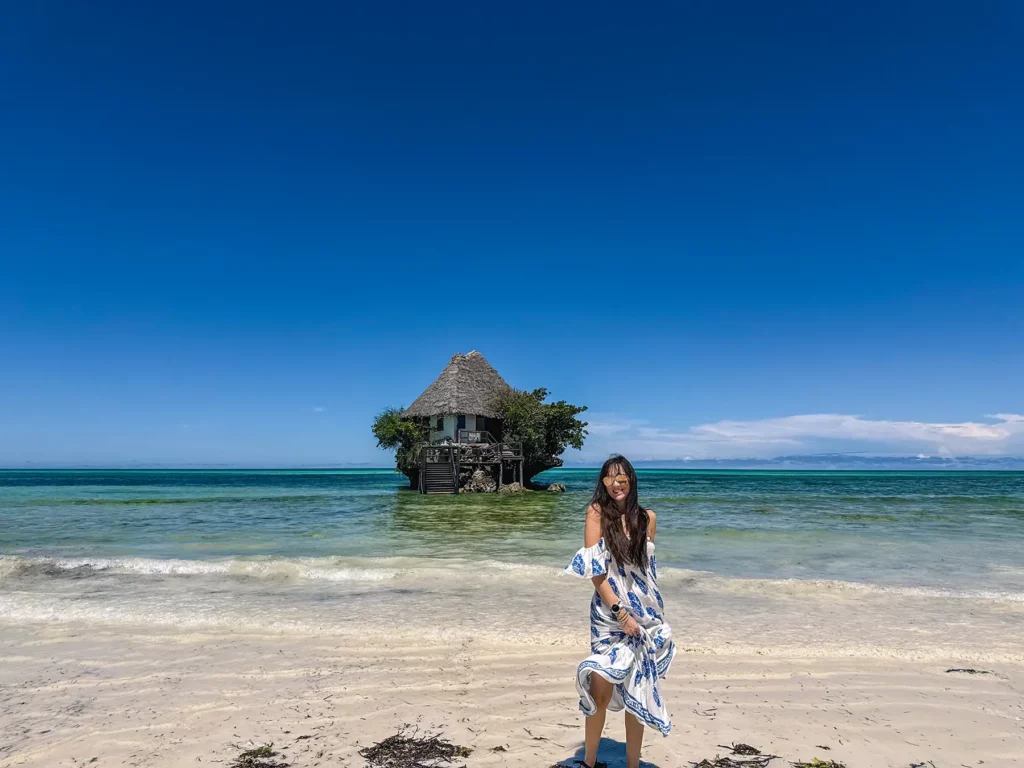
About Zanzibar
Zanzibar consists of a chain of islands; three main ones and dozens of other tiny uninhabited islets, drop-dead gorgeous reefs, and remote sandbanks, all surrounded by the crystal clear turquoise waters of the Indian Ocean.
Although the largest island is referred to as Zanzibar, its proper name is Unguja. The other two main but smaller islands are Pemba to the north and Mafia Island to the south.
Zanzibar has a fascinating history with a rich blend of Arab, Persian, Asian, African and European influences, all reflected in its architecture, its customs and its people.
Being the centre of the Spice, Ivory and Slave Trades, Zanzibar has a lot to offer in terms of culture and history, while also being the ultimate relaxation holiday due to its pristine white beaches.
You can learn by reading my Ultimate Guide to Zanzibar.
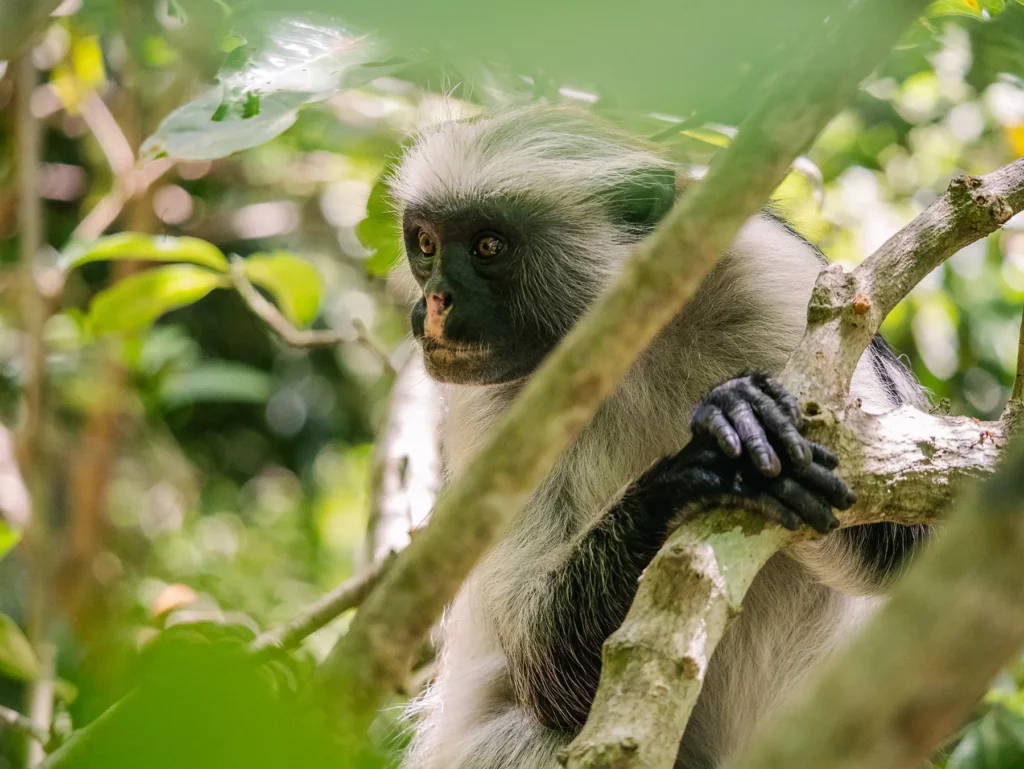
Tips for Visiting Zanzibar
Bug spray is essential for mosquitos, and you’ll also need sunscreen and sunglasses.
Zanzibar has mainly a Muslim population so dress appropriately when in public spaces. In the hotels or resorts, they are not as strict but still be respectful to Muslim visitors and staff. A basic rule is to make sure you’re covered from your knees to shoulders and women will need to wear a headscarf when entering a mosque.
Zanzibar is regarded as fairly safe for tourists, but practise common sense and keep an eye on your valuables.
Where to Spend the Night
You can choose to stay in a single beachfront hotel during your entire 4-day stay or move to different hotels or even to a different island. All the islands provide a wide range of accommodations from the most luxurious resorts to the most basic in virtually every corner.
I do however recommend spending some time on the main island where you can find tons of stuff to do and places to see and experience. It has practically everything.
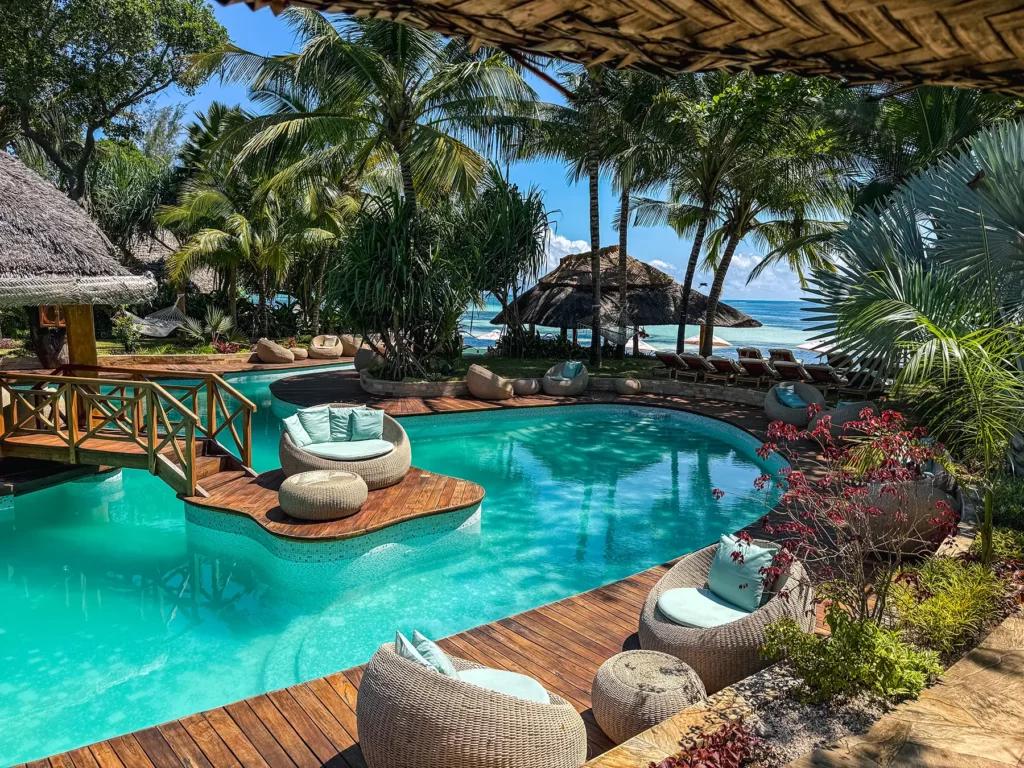
My Experience Visiting Zanzibar
Zanzibar certainly provides the most magical conclusion to any honeymoon. The beaches here are some of the best in the world, with soft white sand stretching for miles and the warm, clear waters of the Indian Ocean inviting you to relax and explore. I stayed at a beachfront luxury boutique hotel, and it was pristine and super relaxing – the perfect setting to enjoy truly intimate moments.
Zanzibar is also rich in history; wandering through Stone Town felt like stepping back in time, with its labyrinth of alleys and history around every corner. It’s the perfect place to unwind, reflect on your incredible adventure, and cherish the final days of a honeymoon in one of the most beautiful destinations on earth.
You can watch a video of my experience visiting the Zanzibar below.
Day 18 – 21: Zanzibar
Total drive time: Depends on your choice of activities.
There is no set itinerary and you get to choose how to spend the next three days!
Things to Do in Zanzibar
No matter how long you choose to stay here, you’ll run out of things to do as Zanzibar is jam-packed with beautiful sights and fascinating things to experience. Hiring a car will allow you the freedom to explore the island at your leisure, spending as long at each place as you wish.
Below are just a few such places and activities for you to consider.
1. Relax on the Beach
There are miles of stunning beaches to relax on around the entire Zanzibar Islands. Soft white sandy beaches, tall swaying palm trees and crystal blue water are what you’ll find virtually everywhere you go. While every beach has its character and appeal, they are all equally beautiful.
Some of the best beaches include Nungwi Beach, situated on the north-western tip of Zanzibar for all round water sports and relaxing, plus stunning sunset scenery. Kendwa Beach is another gem, perfect for relaxing during the day and partying at night. Paje Beach on the southeast-facing coast is another beauty, excellent for swimming, kayaking or kitesurfing.
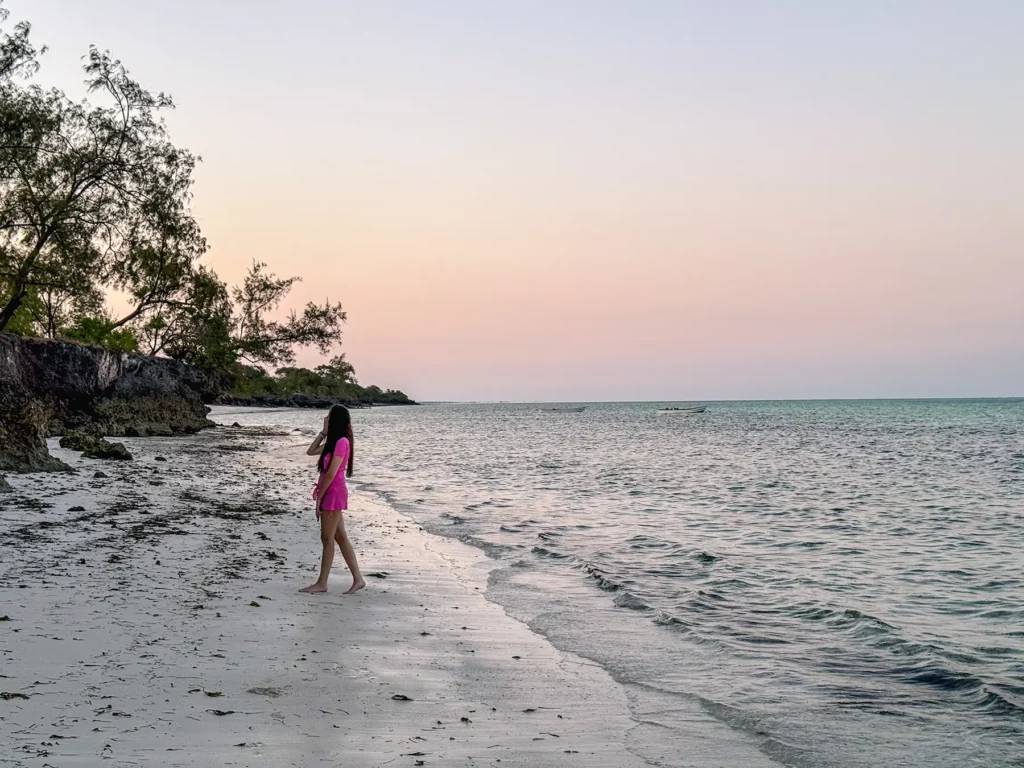
2. Go Snorkelling
Zanzibar is one of the best snorkelling destinations in Africa. Almost the entire islands’ shorelines are surrounded by barrier reefs. Some of these reefs are just a few feet from the shore in extremely shallow water, perfect for complete novices and safe for young children too.
Along the shallow reefs, you’ll find a wide range of colourful reef fish, such as the elegant Moorish idol, multi-coloured parrot fish, angel fish, lionfish and the ever-popular.
There are also numerous predatory fish cruising amongst the coral reefs like trevally, barracuda, and giant grouper. If you’re really lucky, you may spot a turtle or two munching away on the corals.
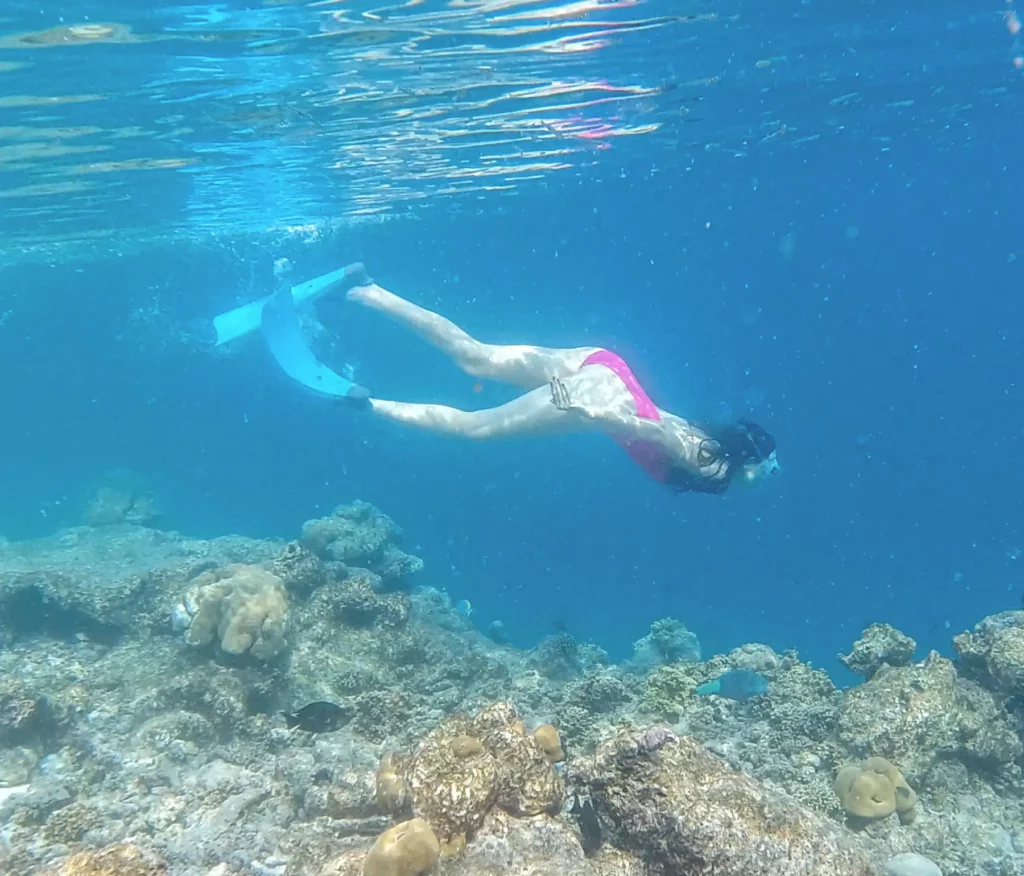
3. Visit Stone Town
The historic Stone Town is situated in the heart of Zanzibar City on its westernmost tip and is a must-see. Hidden in plain view in all their glory, all the cultures of past and present inhabitants of Zanzibar are crammed into this tiny space of less than one square kilometre.
Make time to spend at least a morning or even a full day getting lost in its narrow twisty streets visiting rich cathedrals, elaborately decorated mosques, imposing ancient forts, and somewhat disturbing slave markets of a thankfully bygone era.
You’ll pass by intriguing shops selling spices, vibrant fabrics, local artworks and souvenirs, as well as irresistible coffee shops, eateries serving delectable local foods and colourful street traders plying their trade. Grab a souvenir or local snack while you’re here.

Where to Spend the Night
Spend your time in Zanzibar in one of the island’s beautiful beachfront hotels.
Recommended Booking Options For Your 3 Week Tanzania Safari Itinerary
Safari with local tour operator
Most popular & best experience – typical prices for this itinerary start from $350 per person per day.
Visit safarisbyella.com for free quotes from trustworthy local tour companies I use to book my own trips.
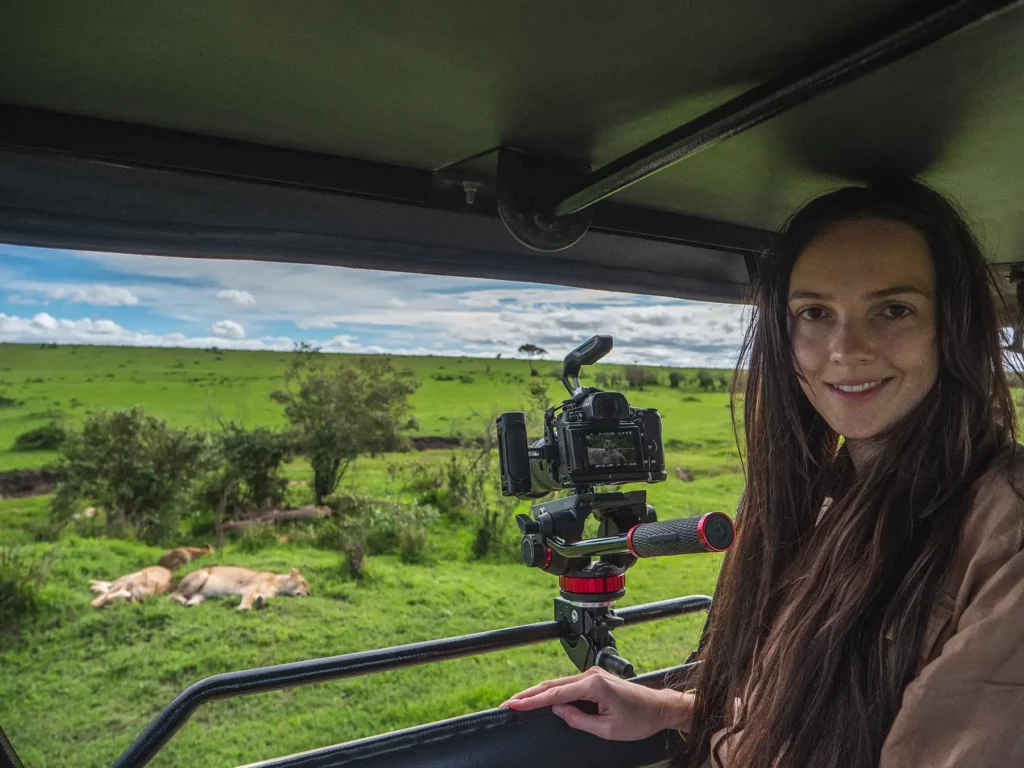
Final Thoughts
So there you have it. Three glorious weeks traversing Tanzania seeing virtually all this country has to offer. From the excitement and drama of the Serengeti where you don’t know what you’ll stumble across from one minute to the next, to the placid and inviting waters of Zanzibar Island, where time just stands still.
Tanzania will leave you feeling ‘mission accomplished’, having witnessed sights you probably thought you’d only see on National Geographic and travel programs. It may leave you wanting to come back again…and again. It did that to me!
Read More Tanzania Guides
For an overview of planning your safari, you can read my Ultimate Tanzania Safari Guide.
Tanzania Itineraries
Recomended itineraries and how to book them.
7-10 Day Tanzania Safari Itinerary & Costs
5-Day Tanzania Safari Itineraries & Costs (6 unique Itineraries)
3-Day Tanzania Safari Itinerary & Costs
2-Week Tanzania & Zanzibar Safari Itinerary & Costs
3-Week Tanzania Safari Itinerary & Costs
10-Day Tanzania Honeymoon Itinerary & Costs
Tanzania and Kenya Itineraries
Multi-country itineraries and how to book them.
10-Day Kenya and Tanzania Safari Itinerary
2-Week Kenya & Tanzania Safari Itinerary
Costs & Planning
How to get the most bang for your buck and the best time of year to visit depending on what you want to do and see.
Tanzania Safari Cost – Everything You Need to Know!
The Great Wildebeest Migration Guide
Zanzibar Island – The Complete Guide
National Parks & Reserves
Complete guides to the best and most famous safari reserves, including the wildlife you’ll see, entrance costs and best time to visit.
Other Popular Safari Destinations
How to Book Your Safari
Save time and ensure an incredible safari experience by getting quotes from my recommended local safari companies.
Join the rapidly growing tribe of over 1,000 travellers who’ve booked their dream safari using my insider tips and recommendations.

